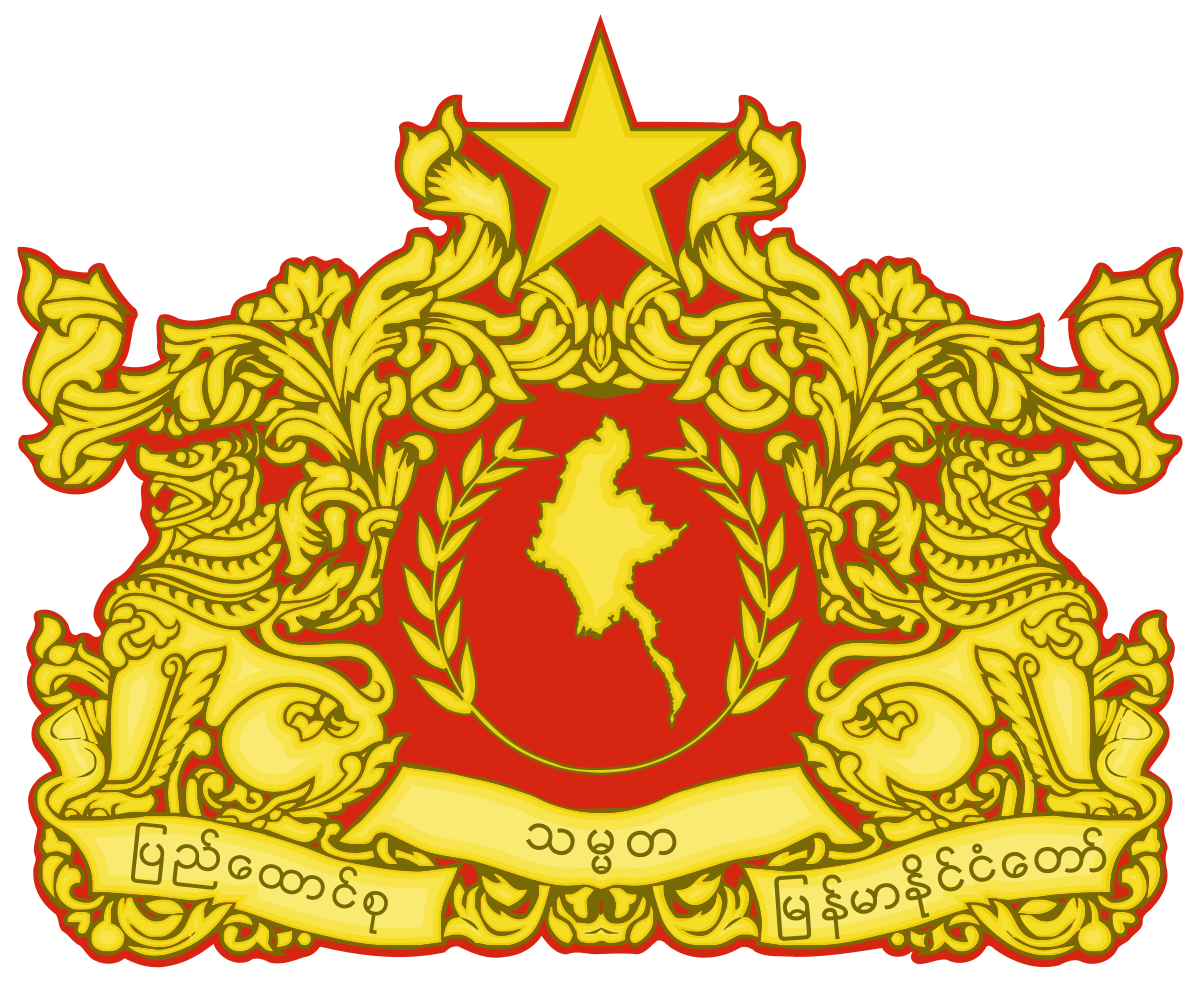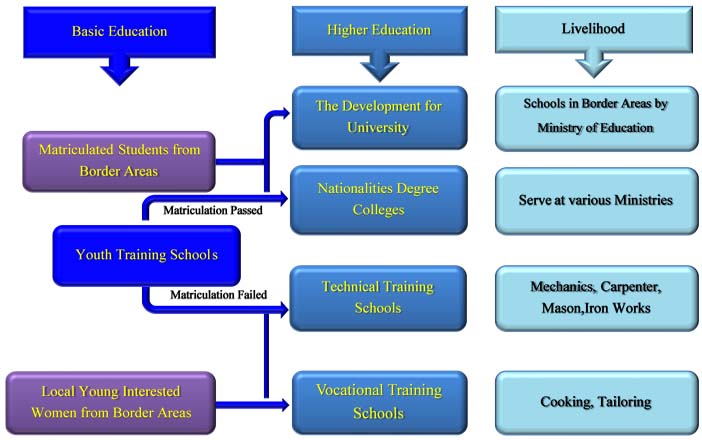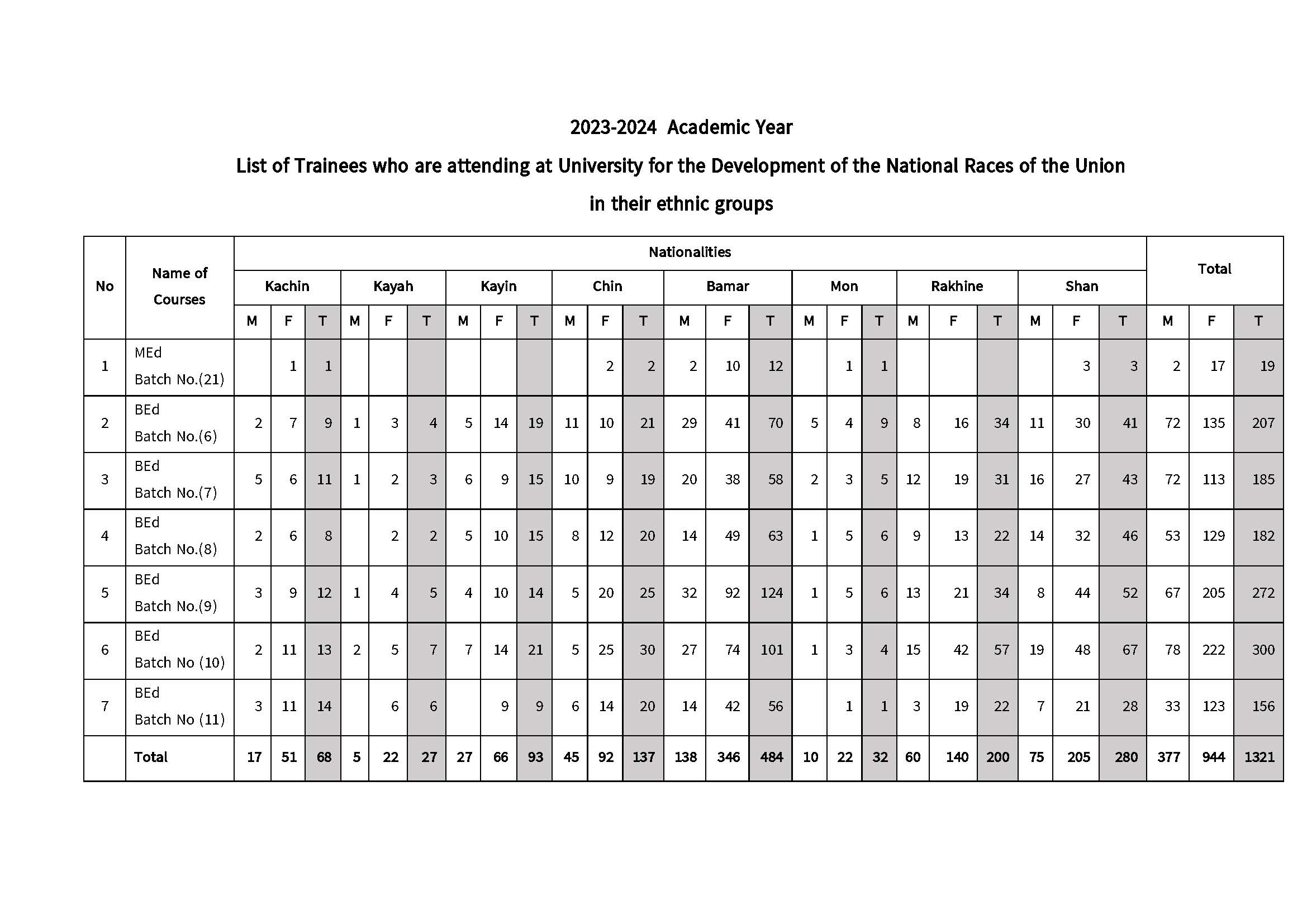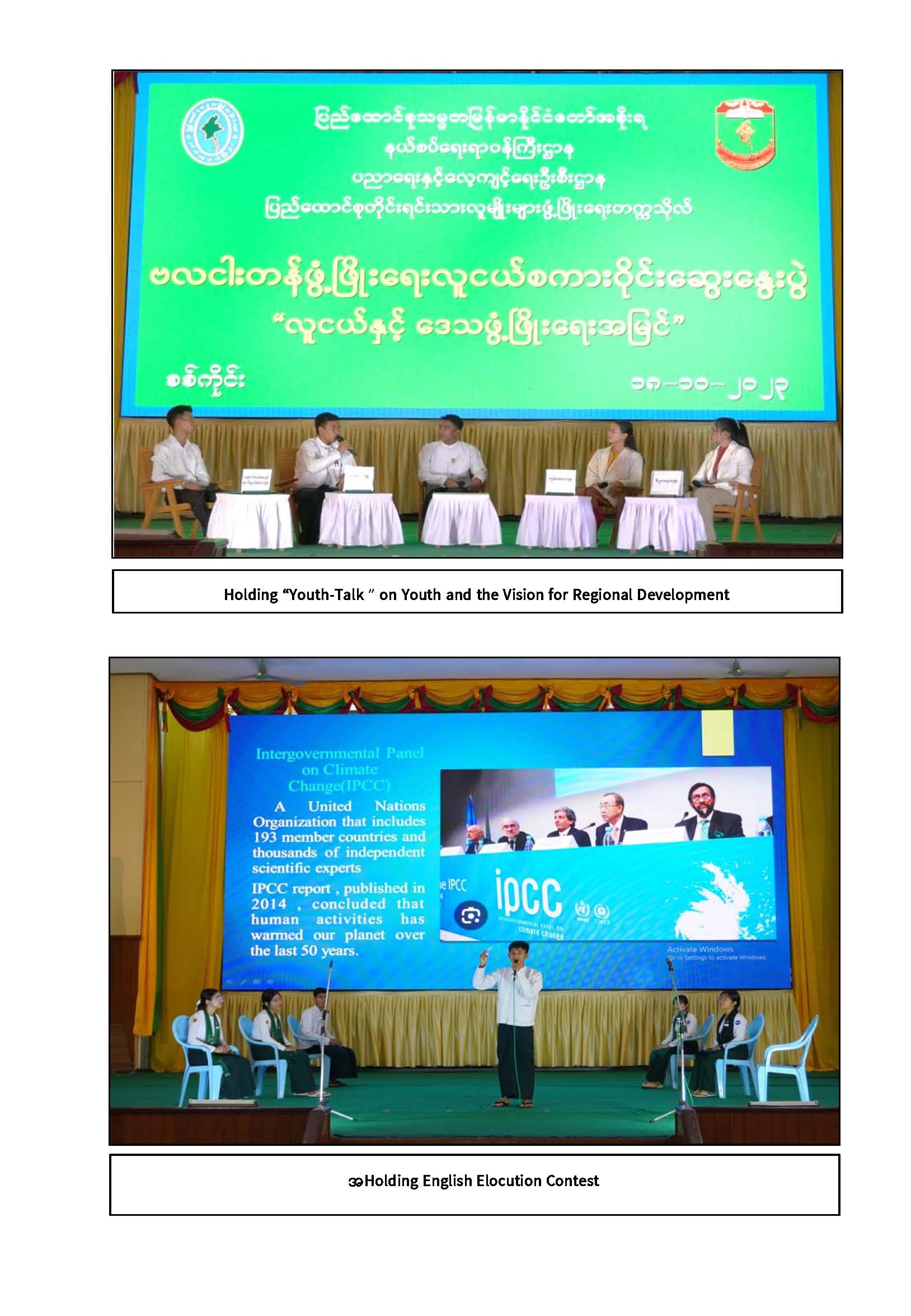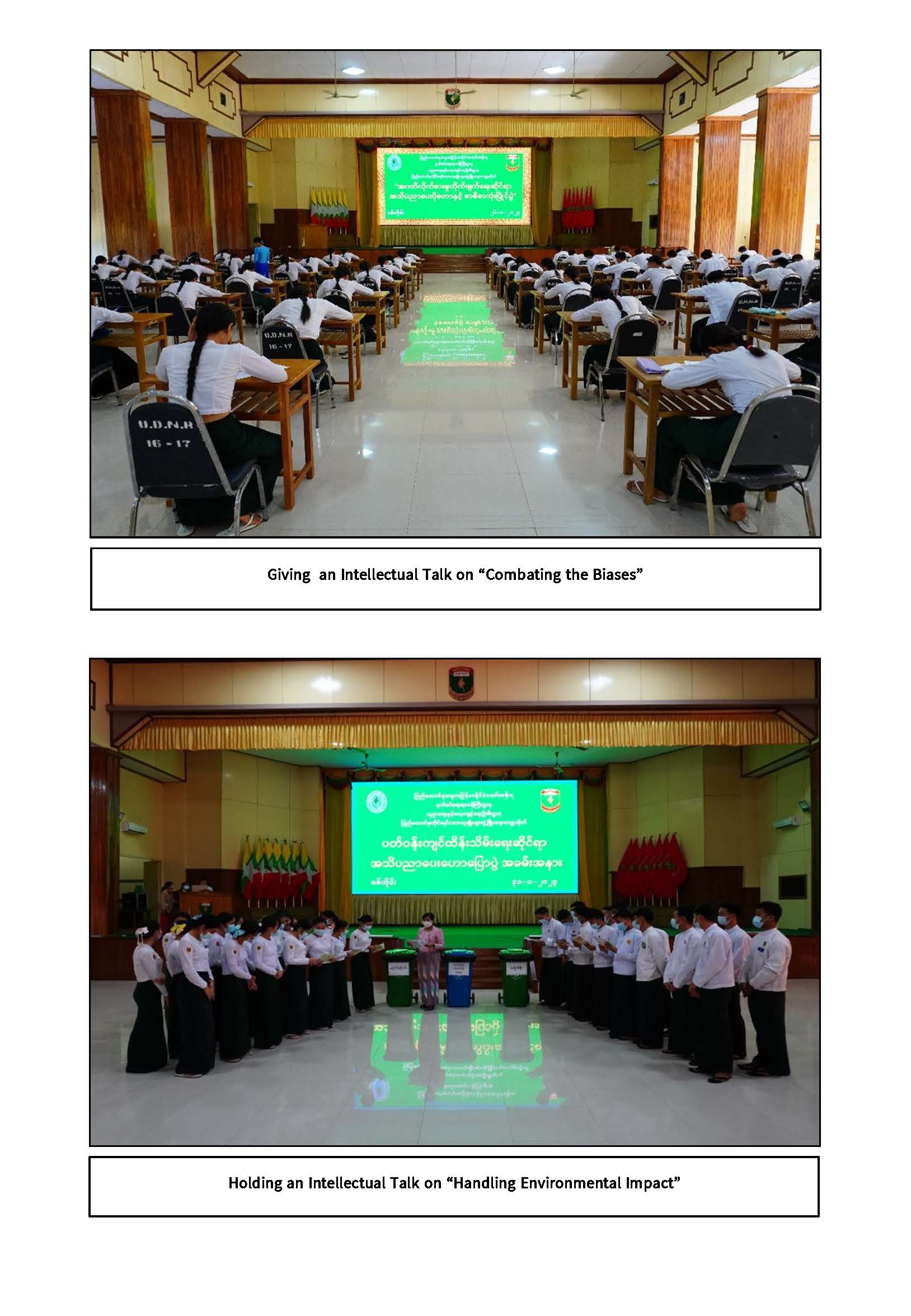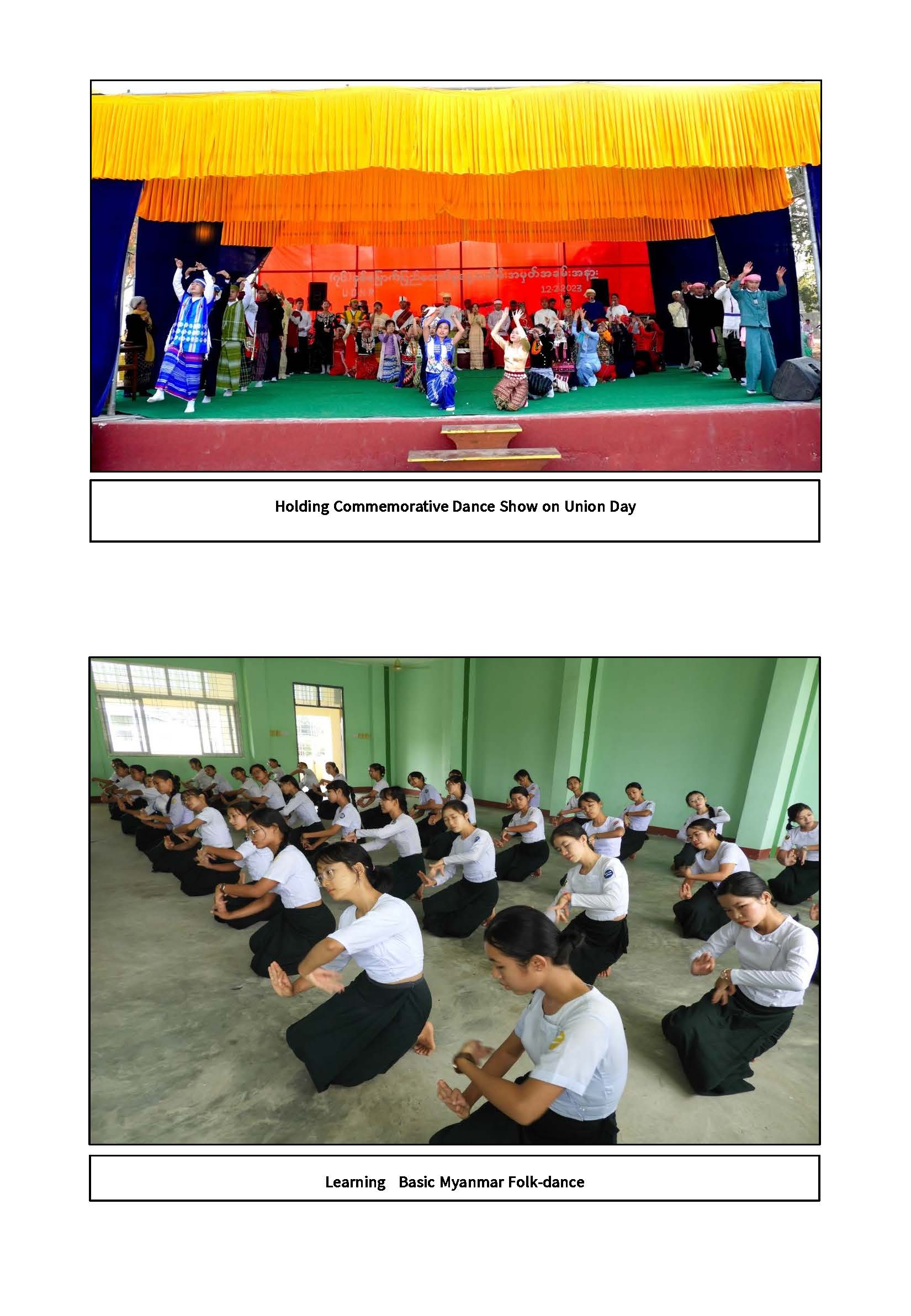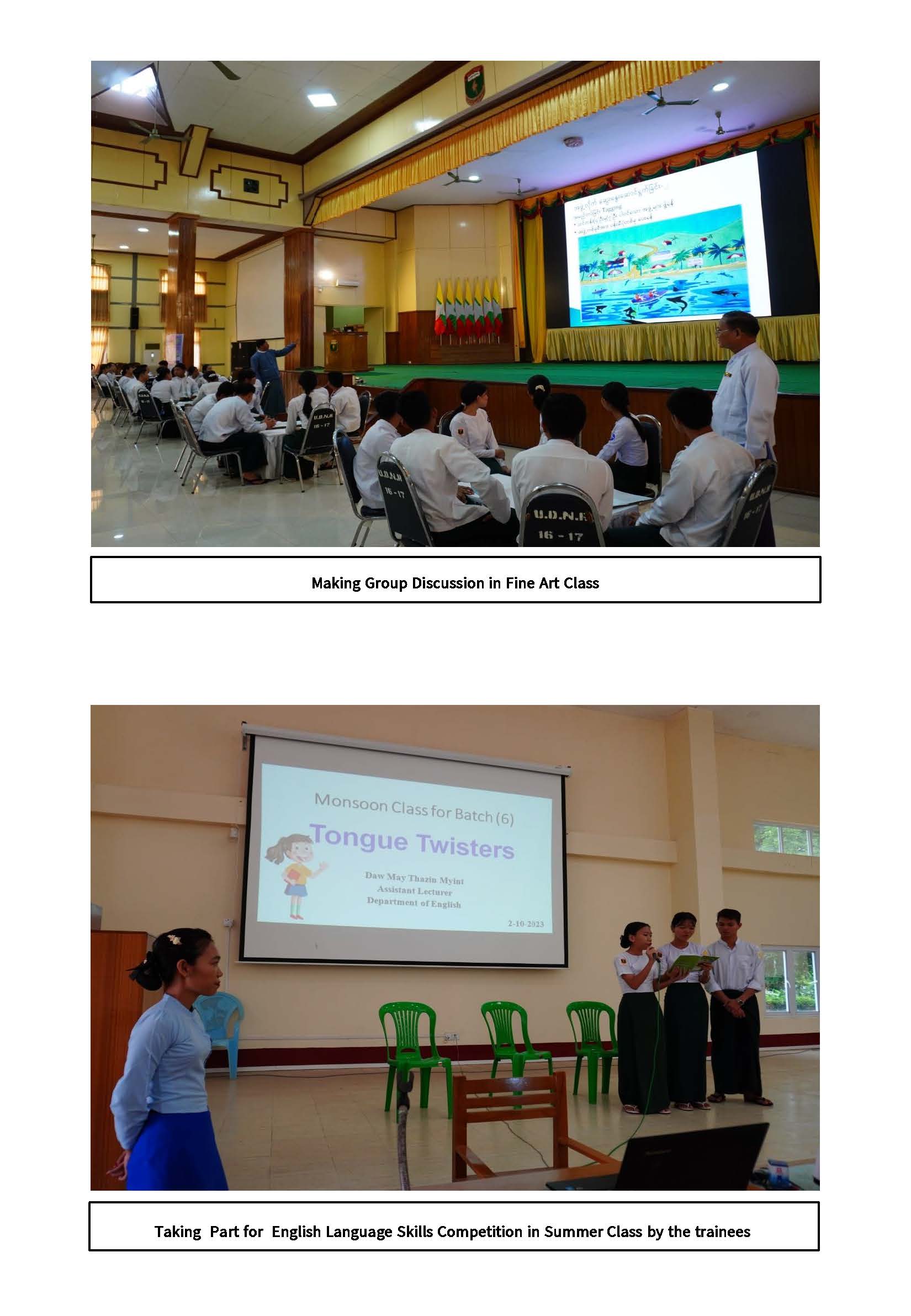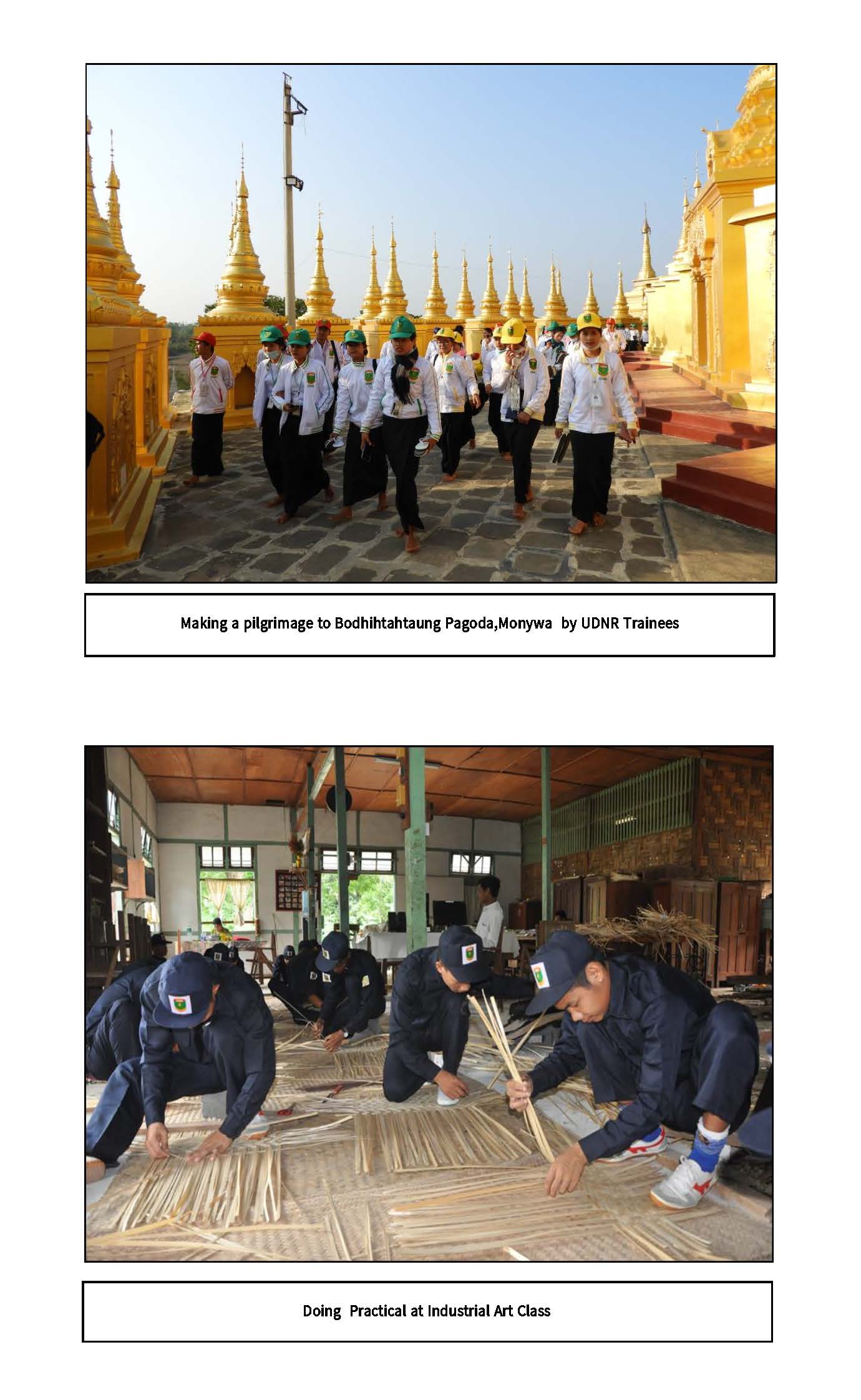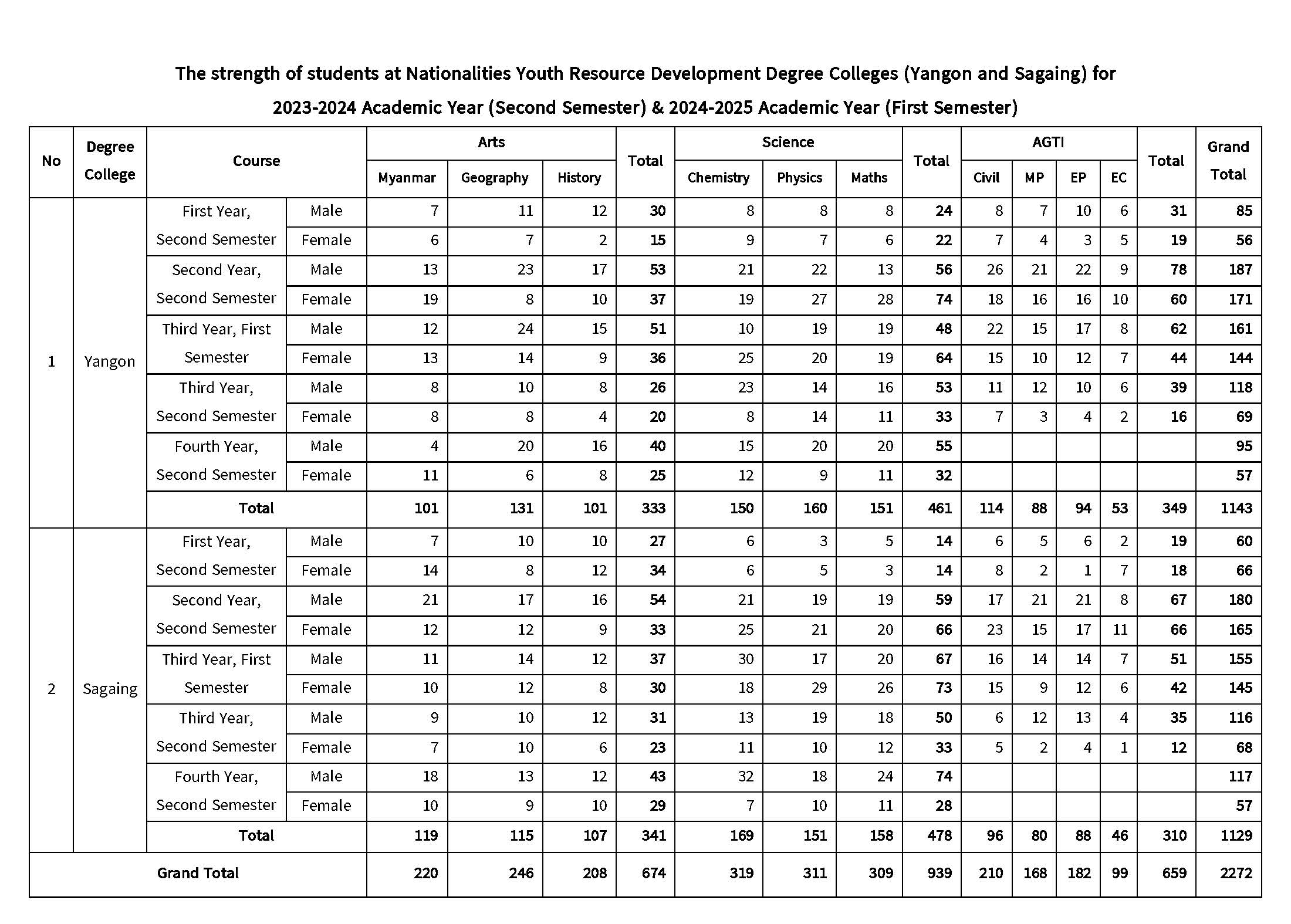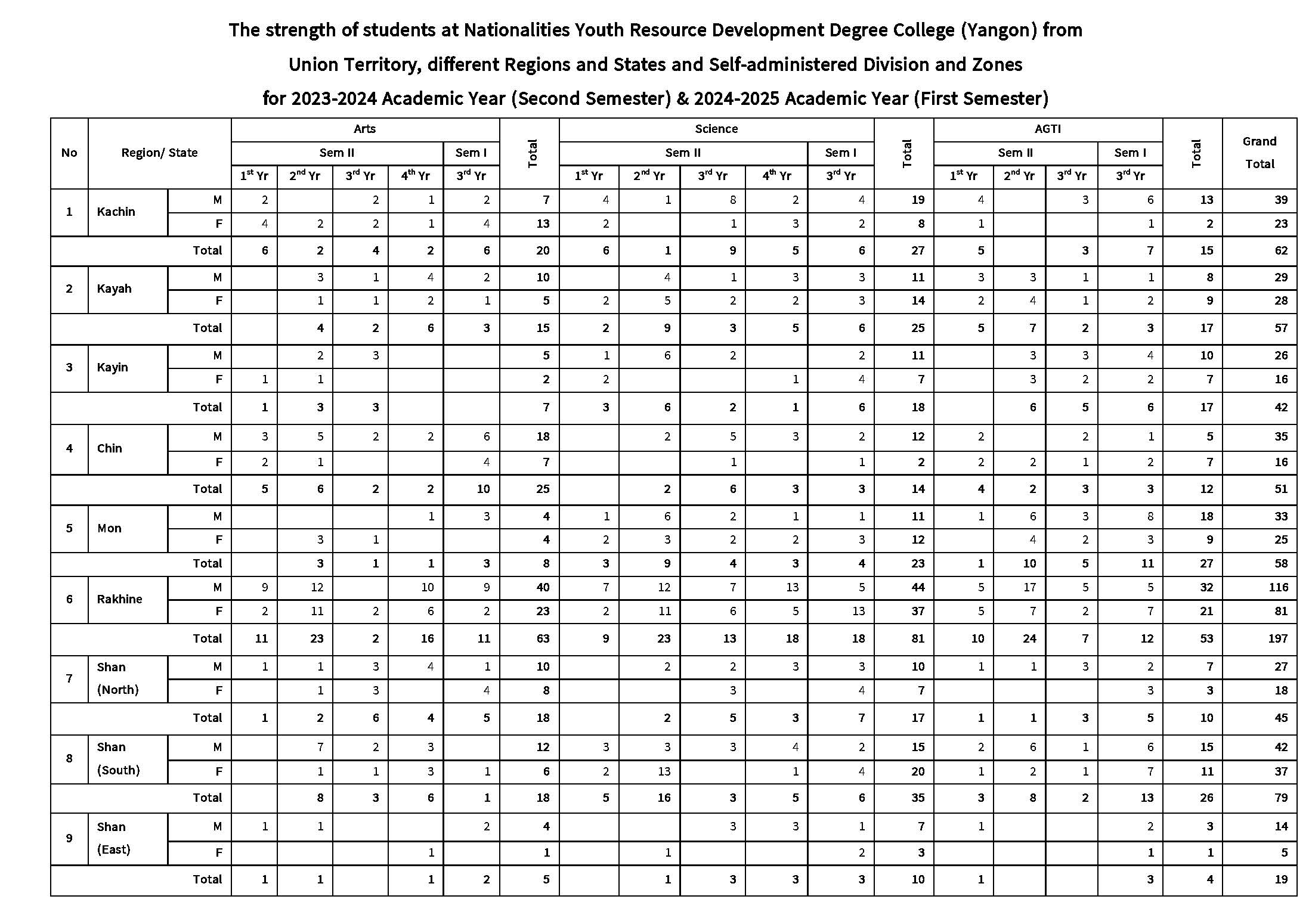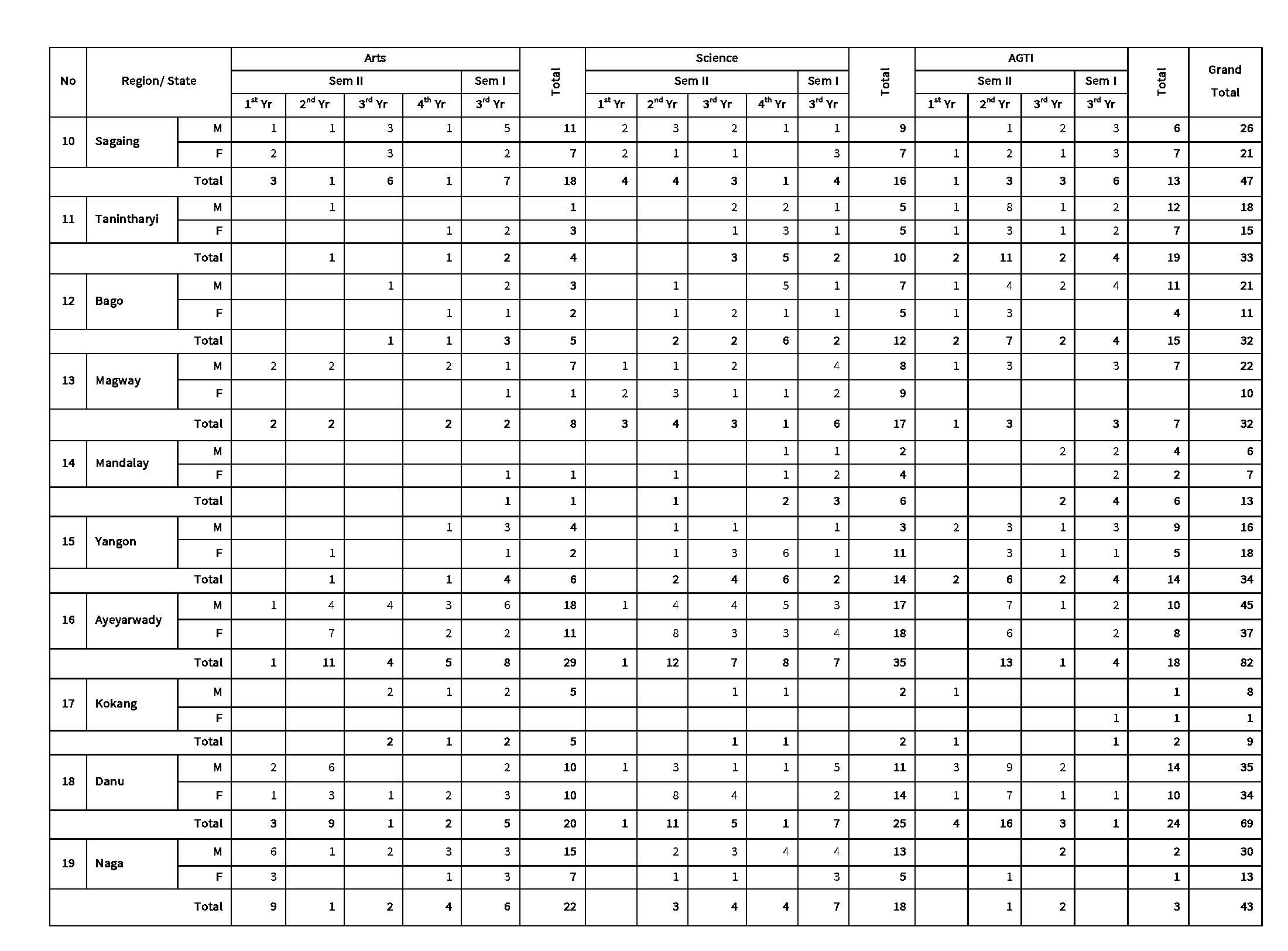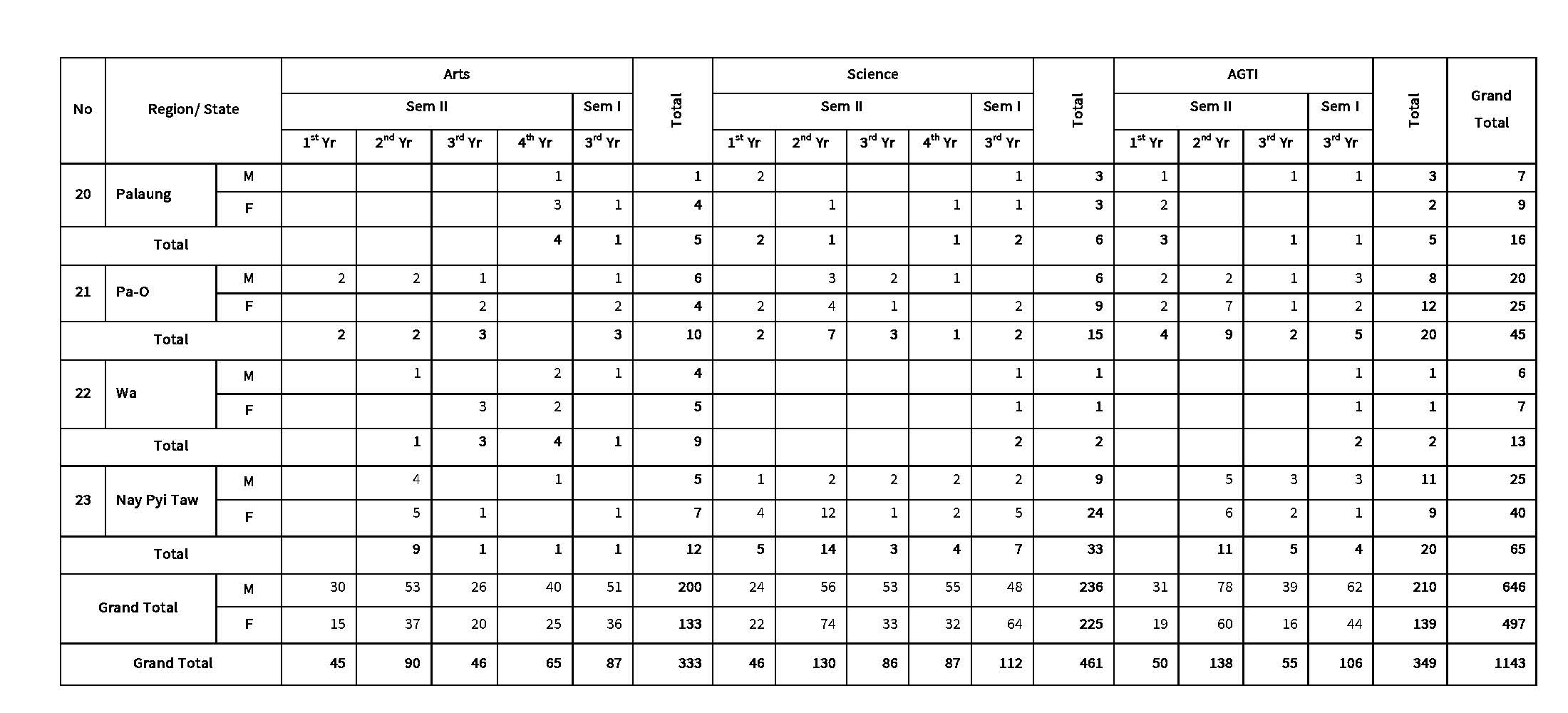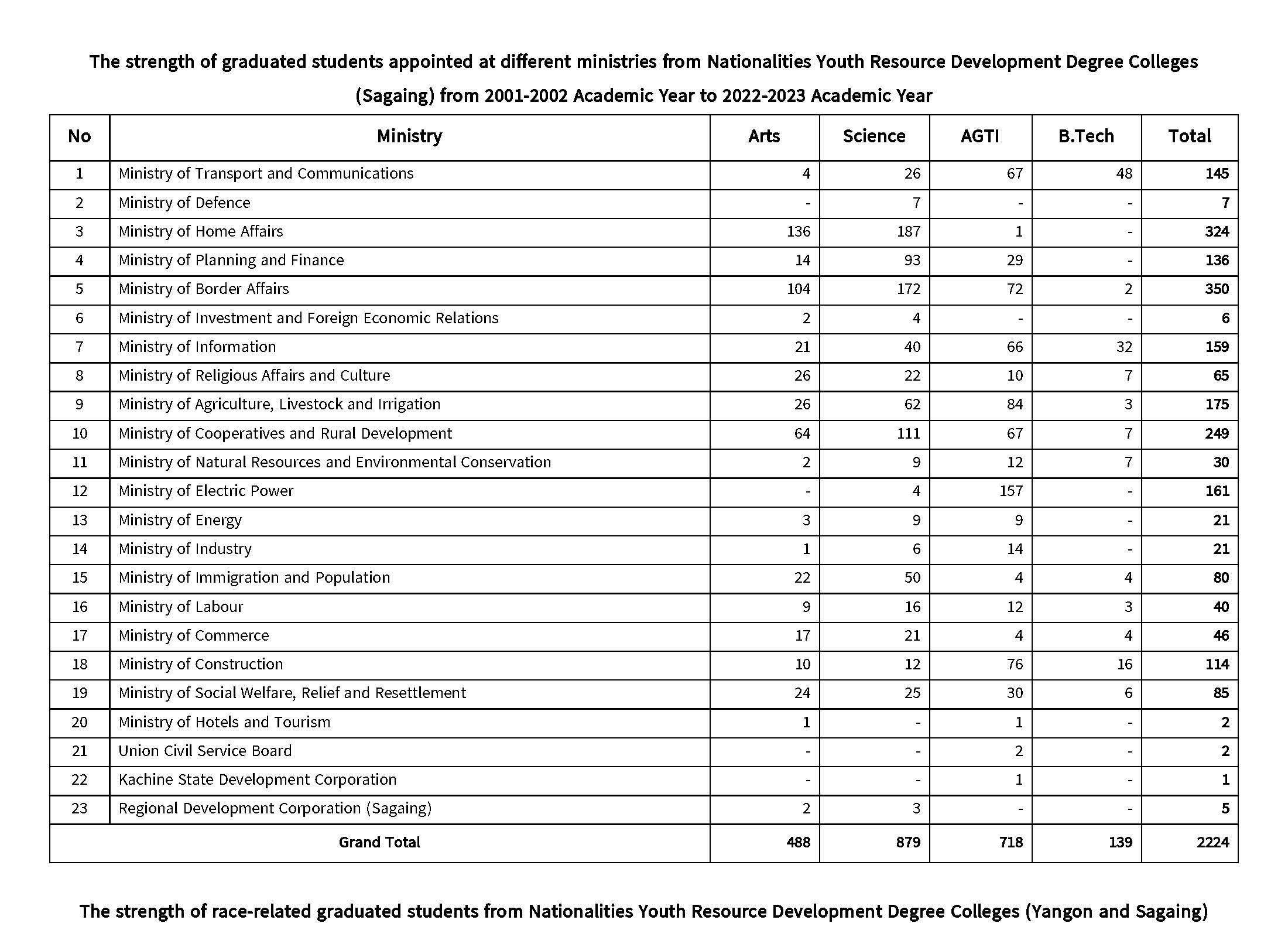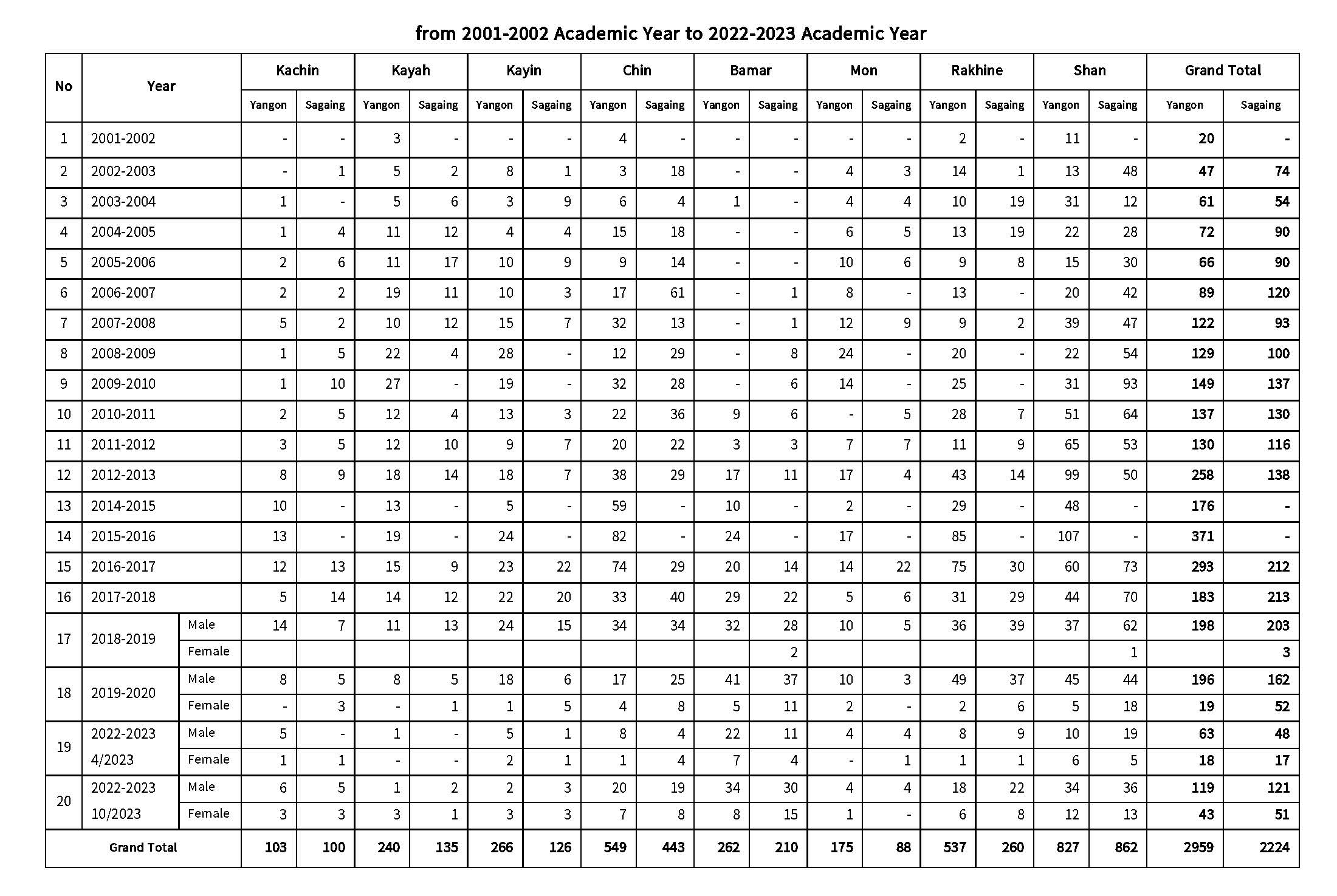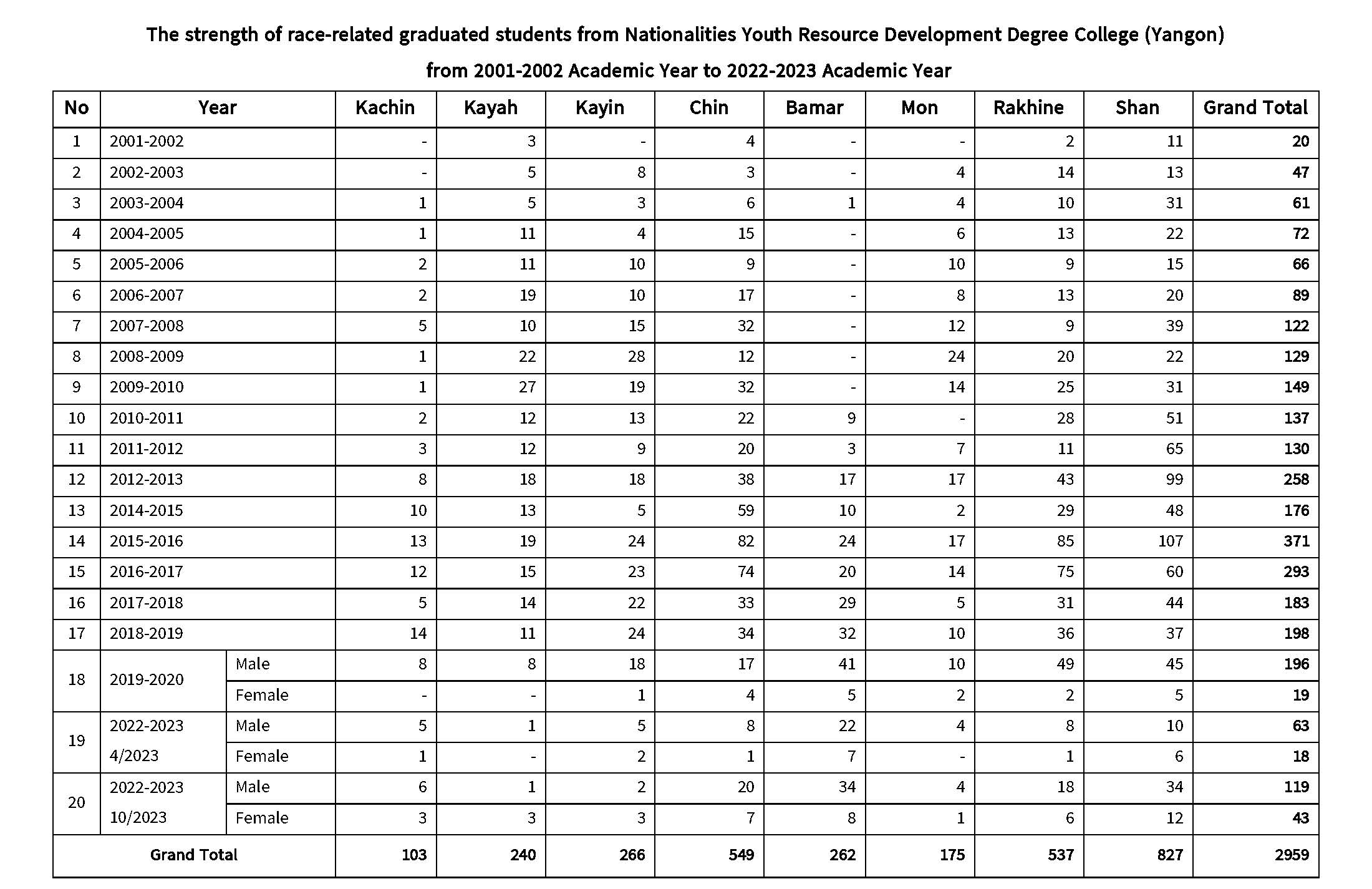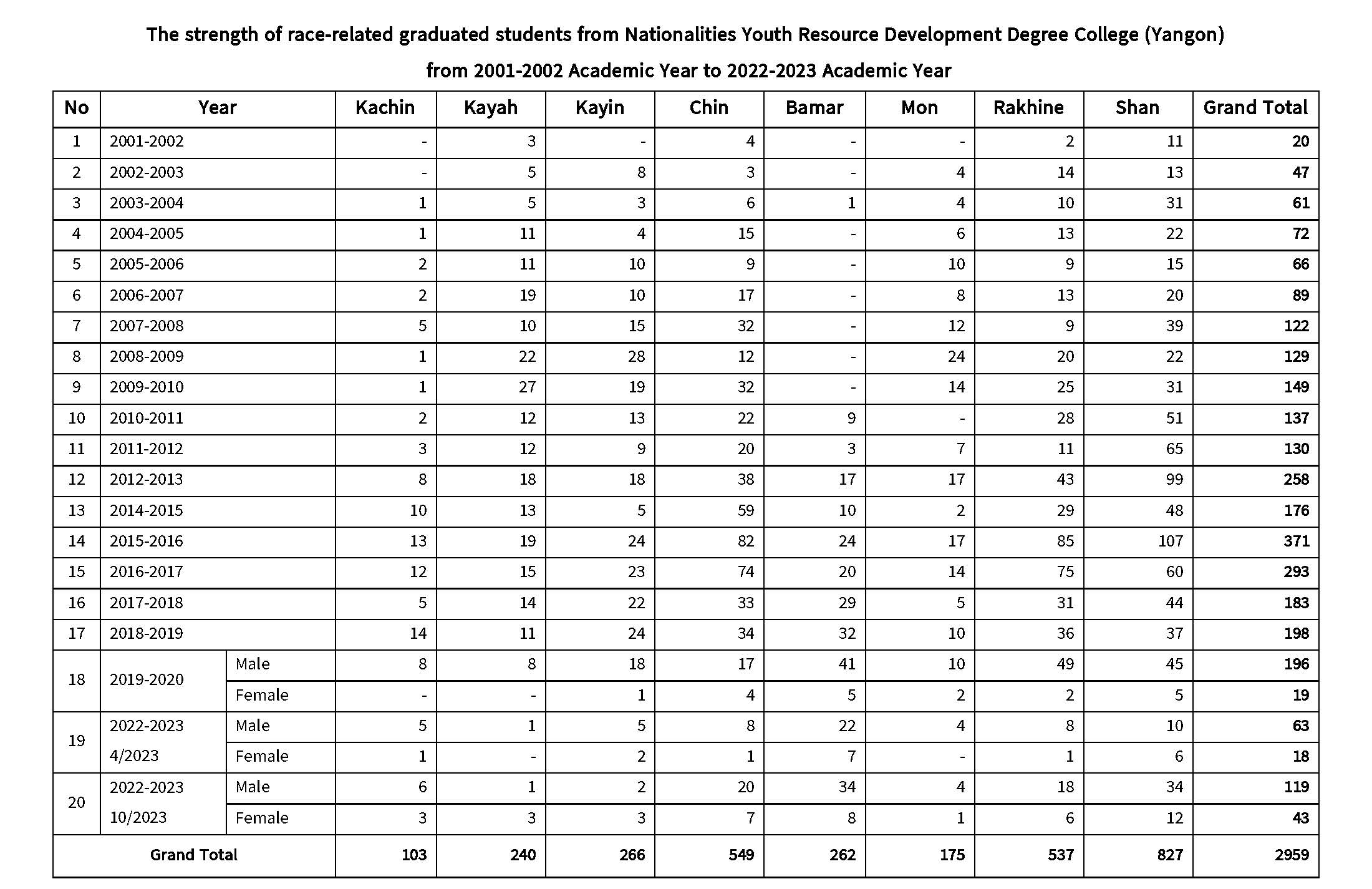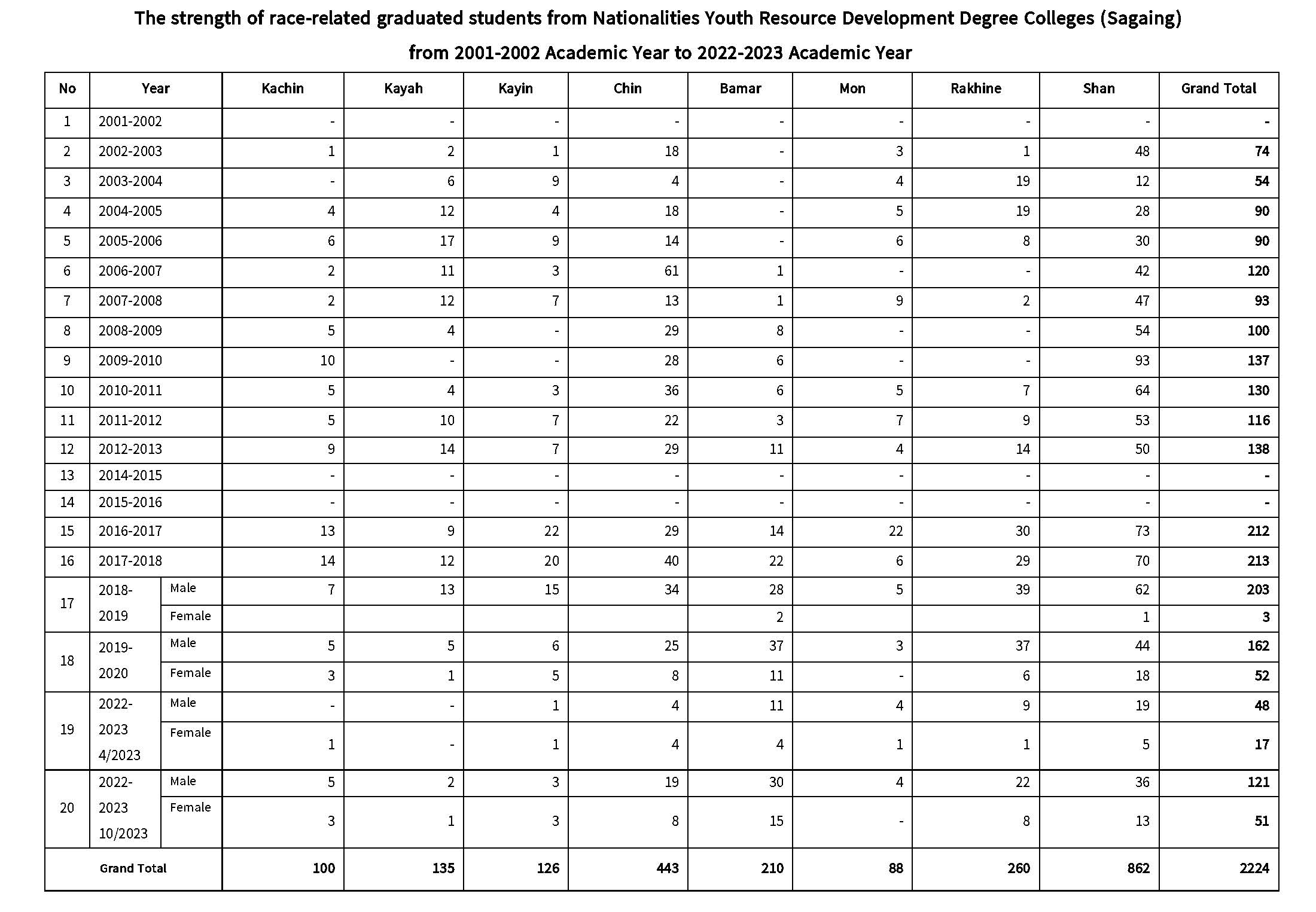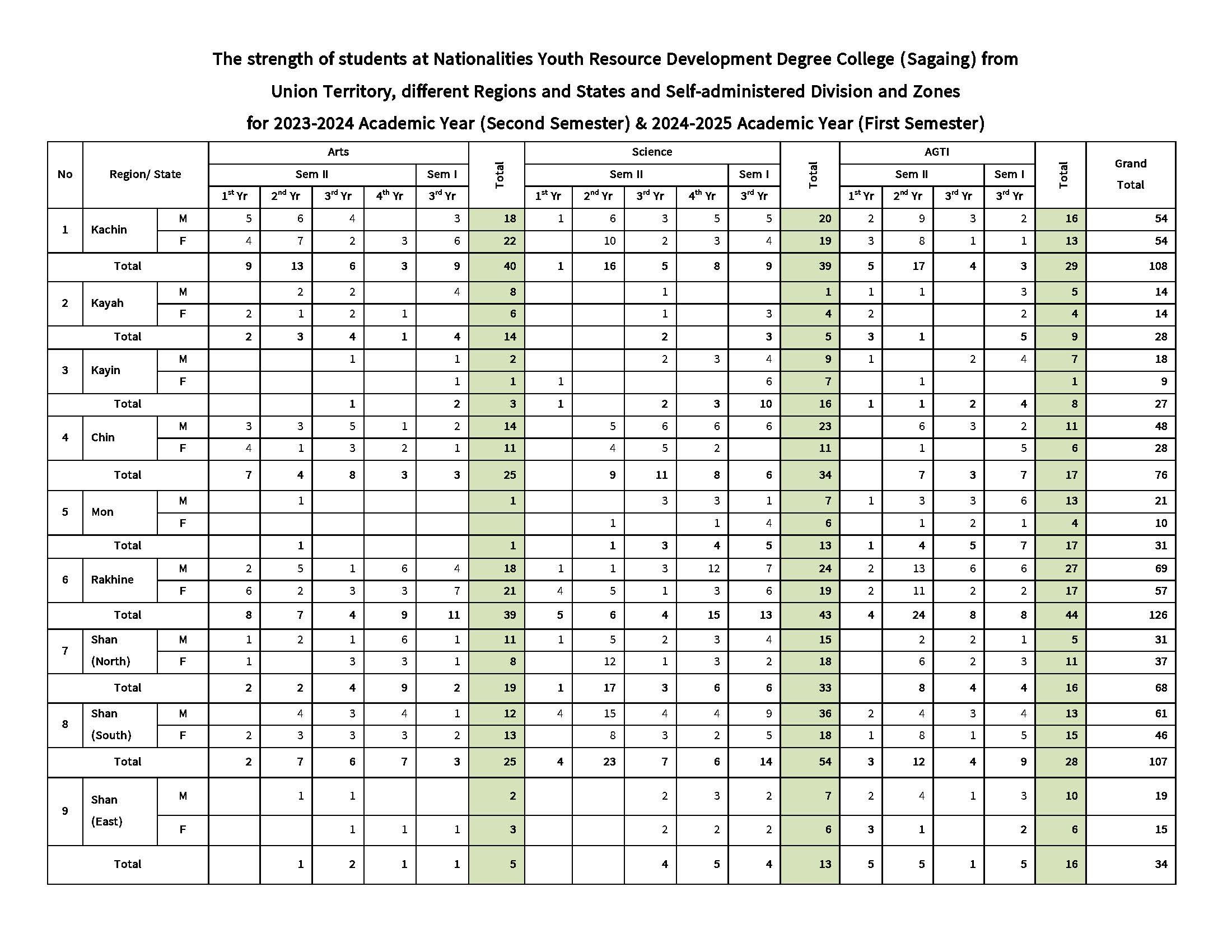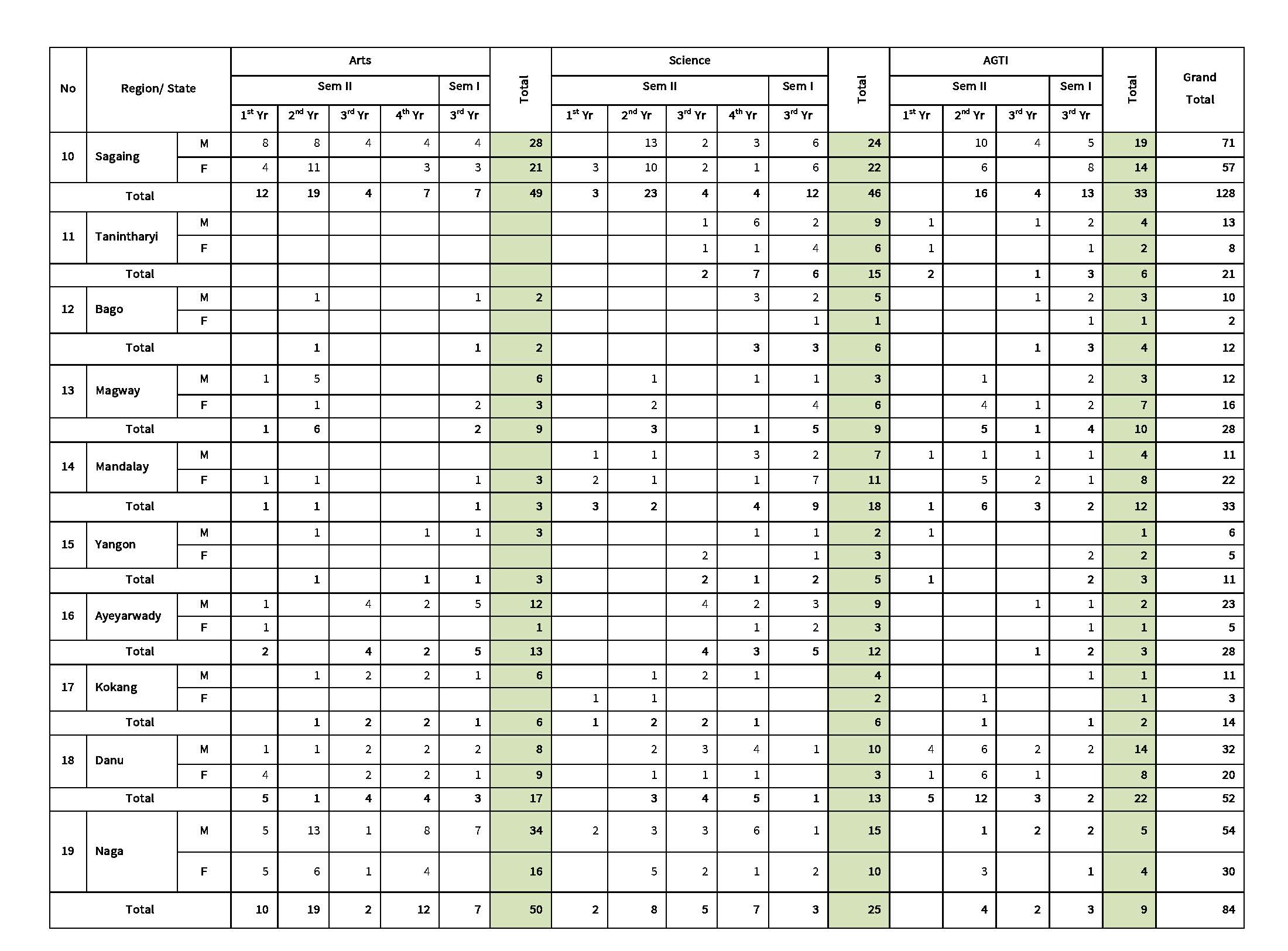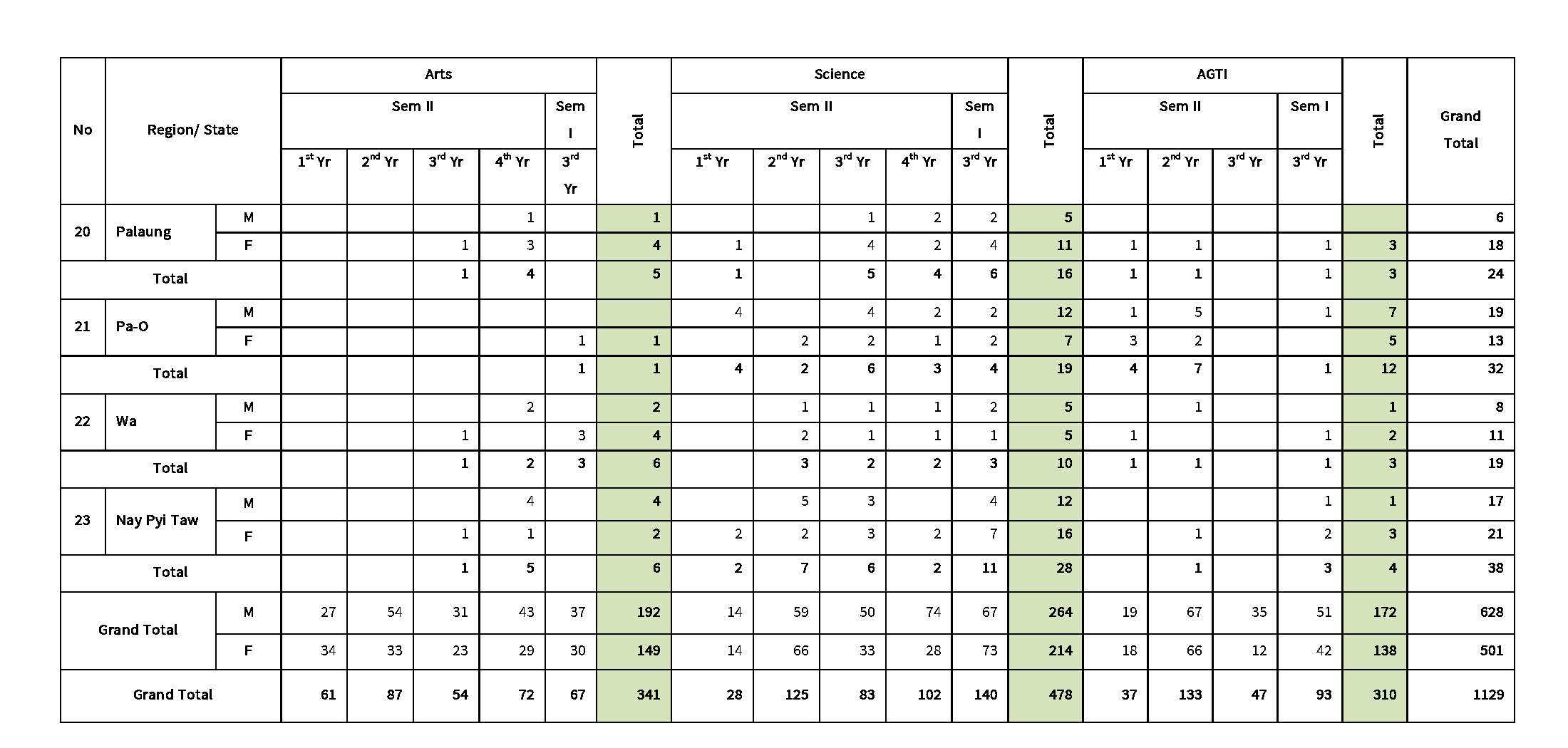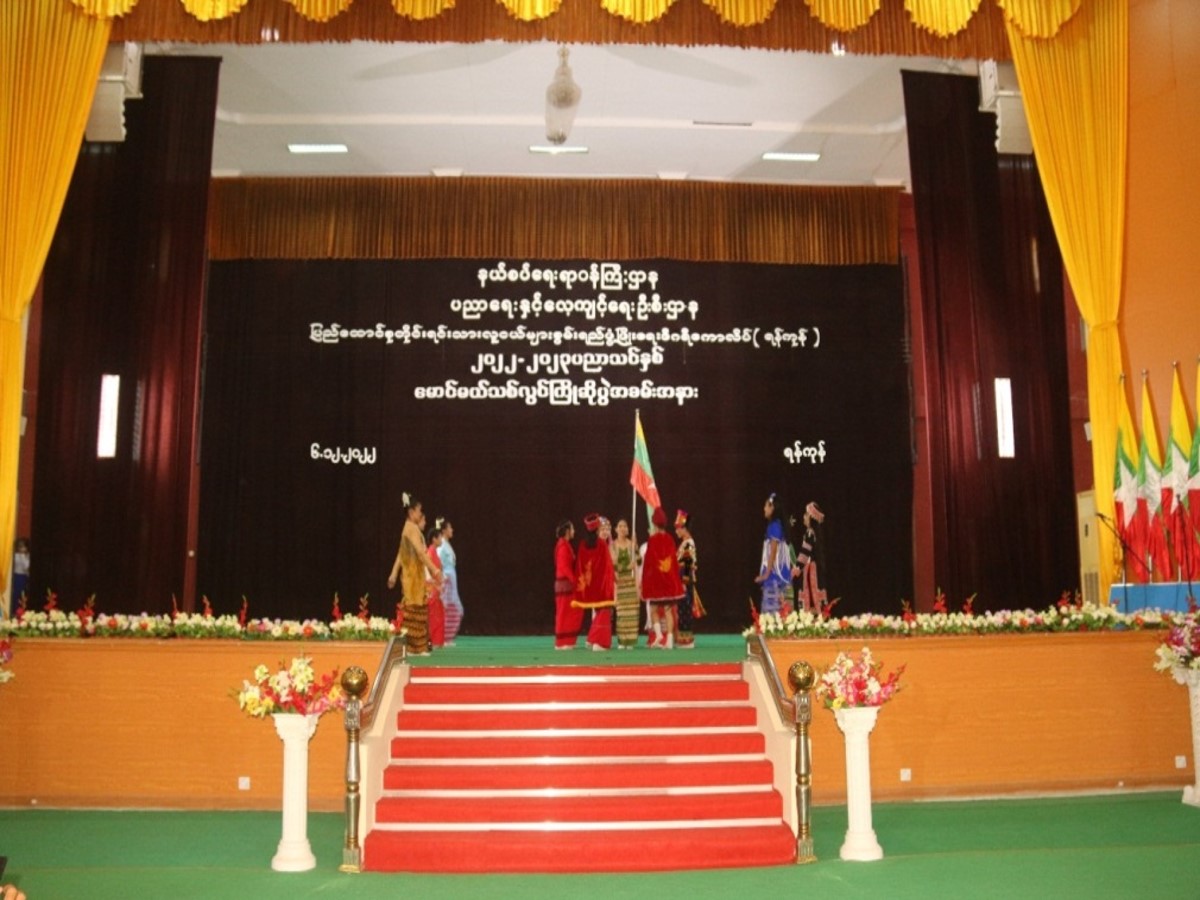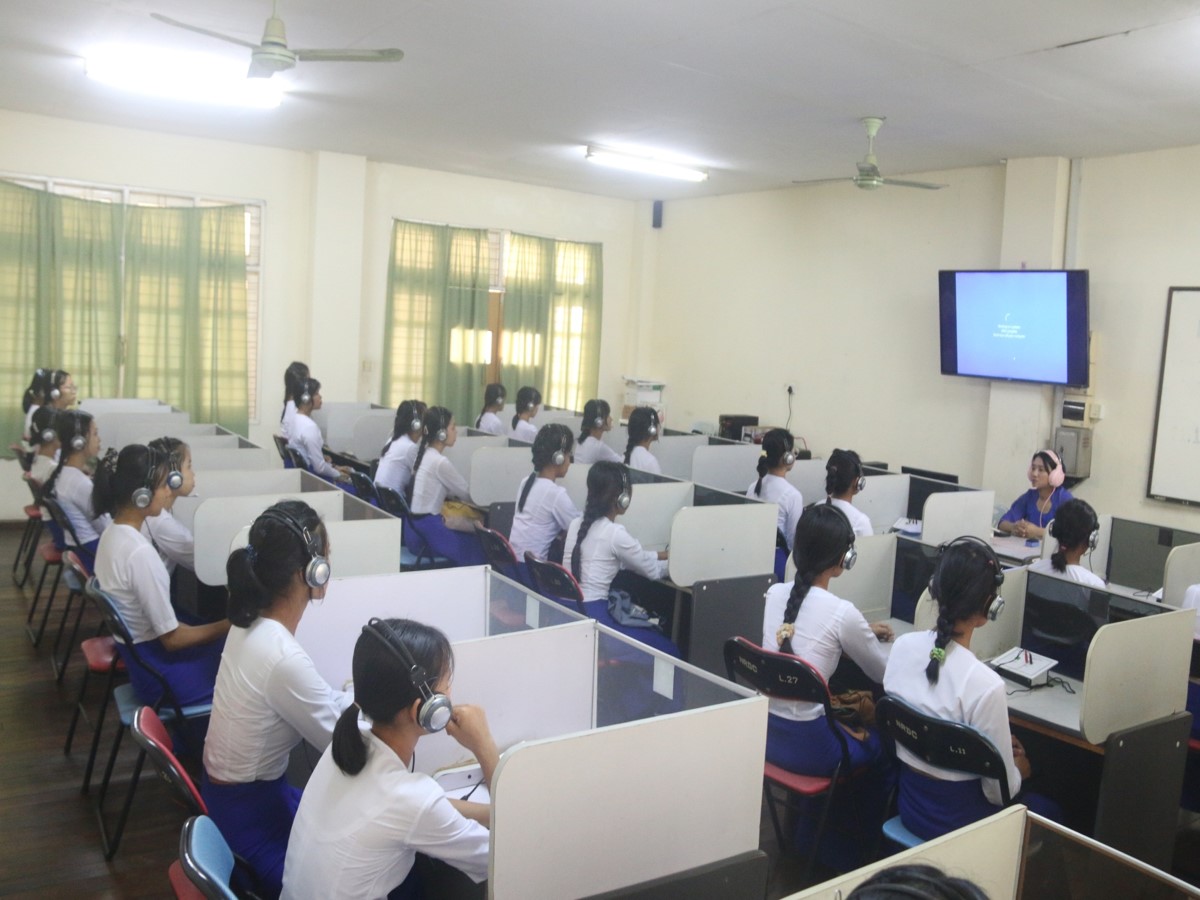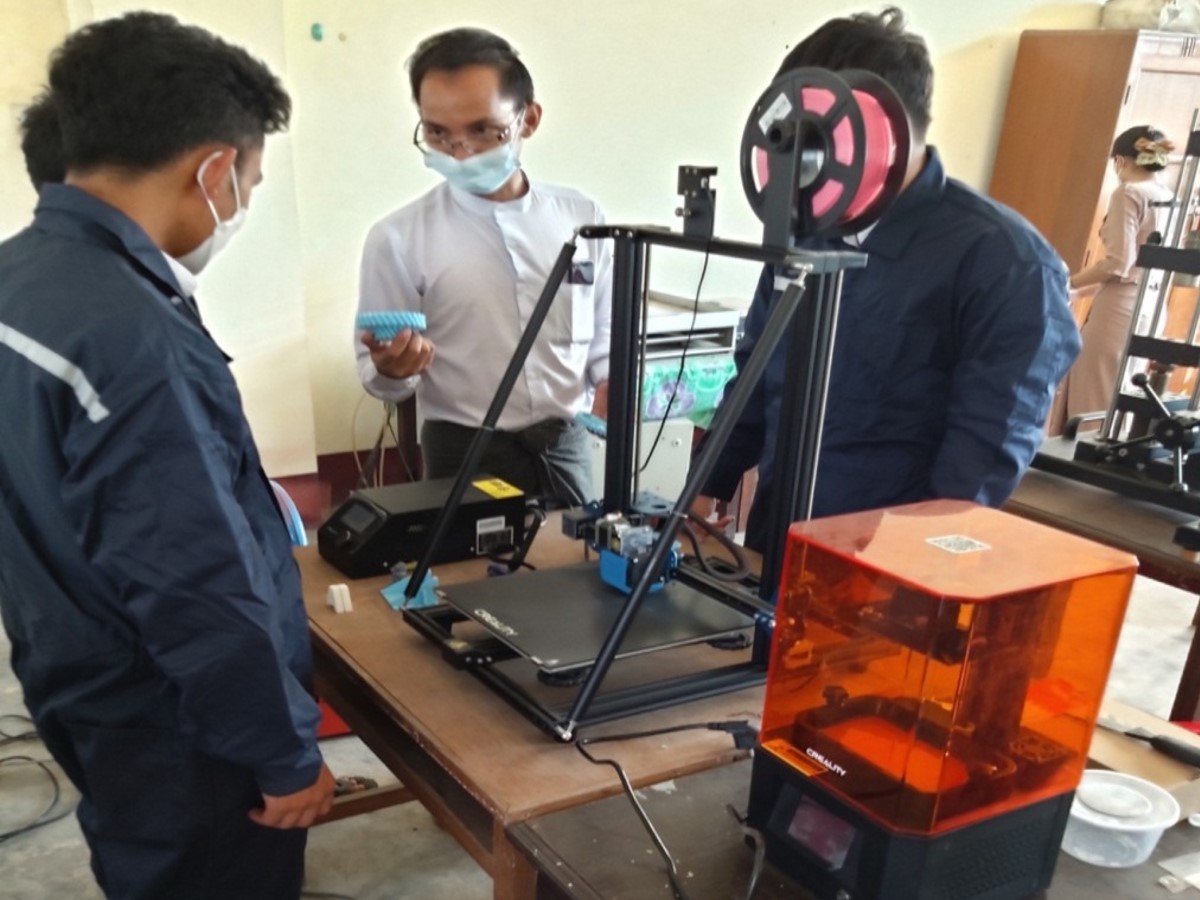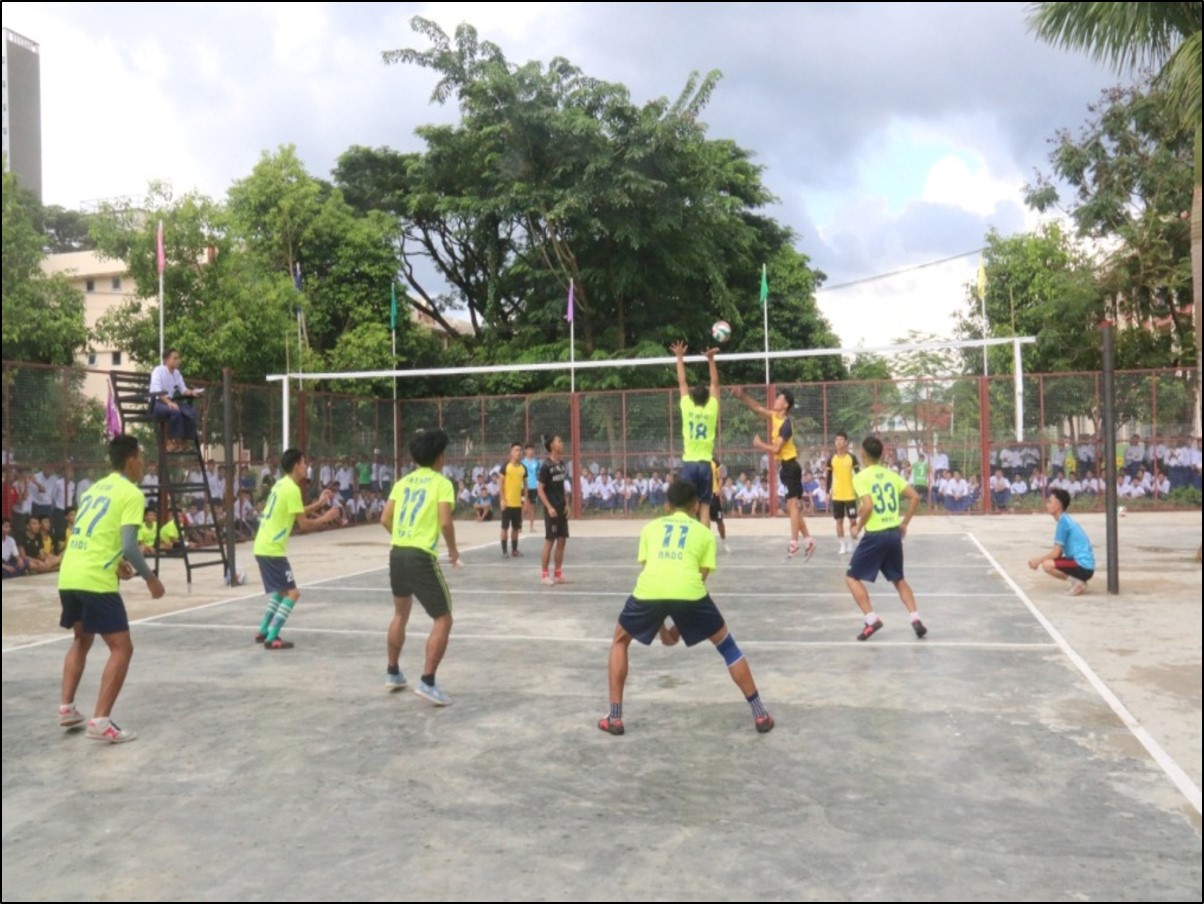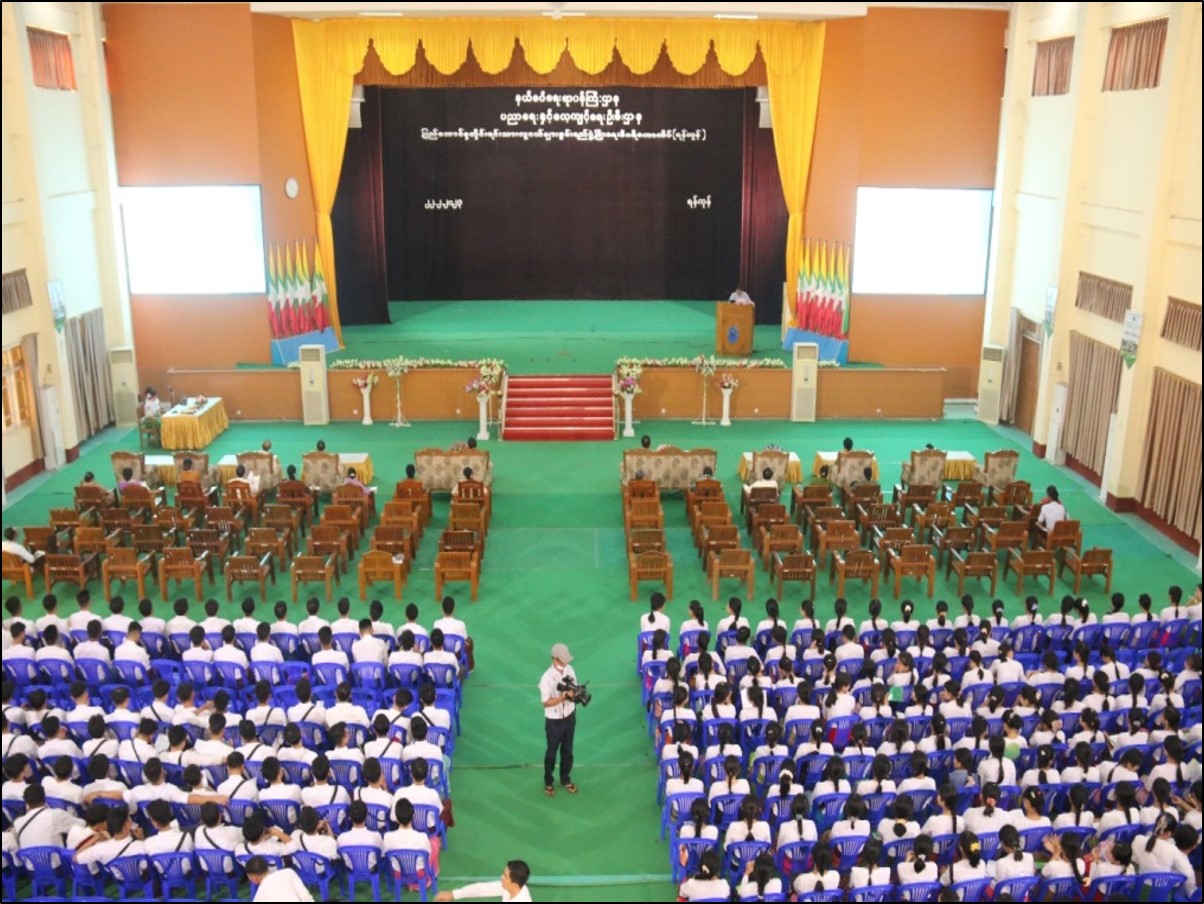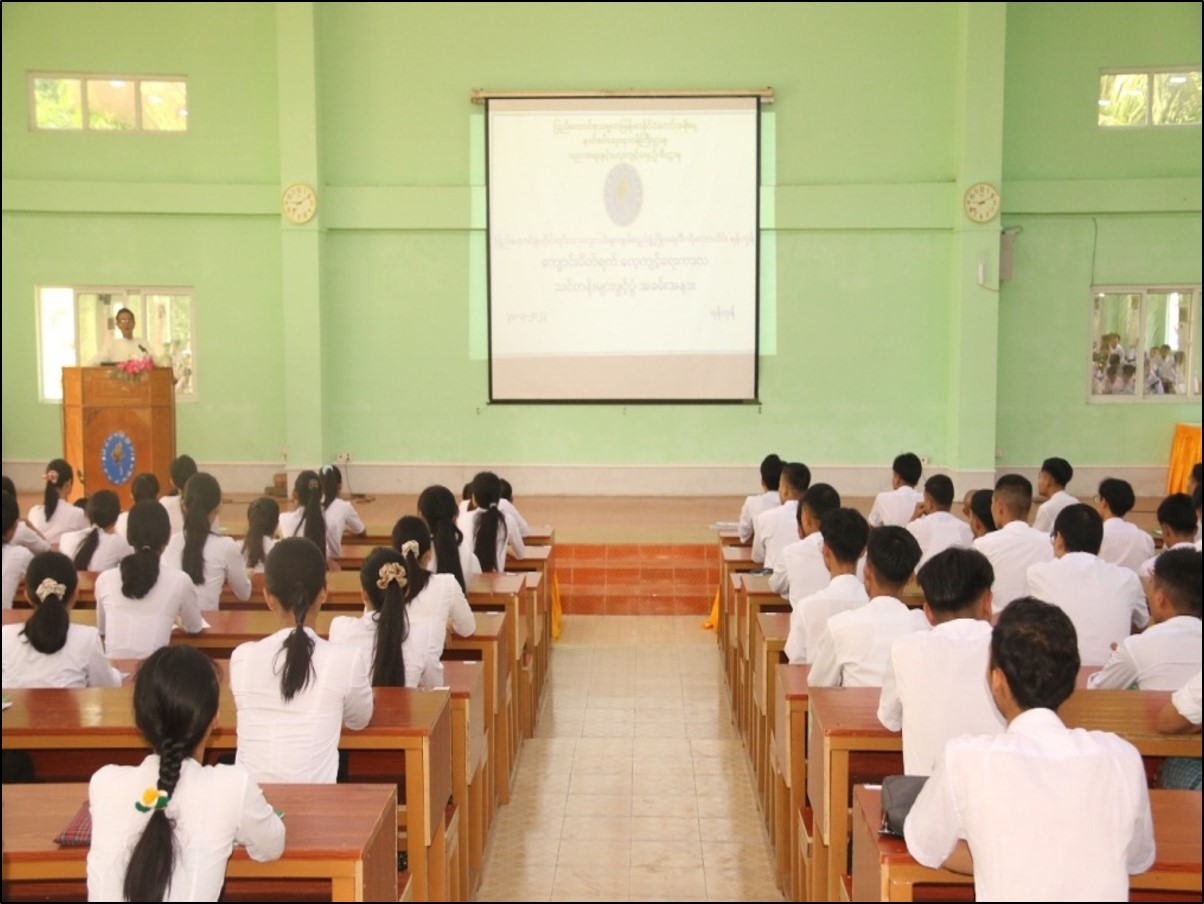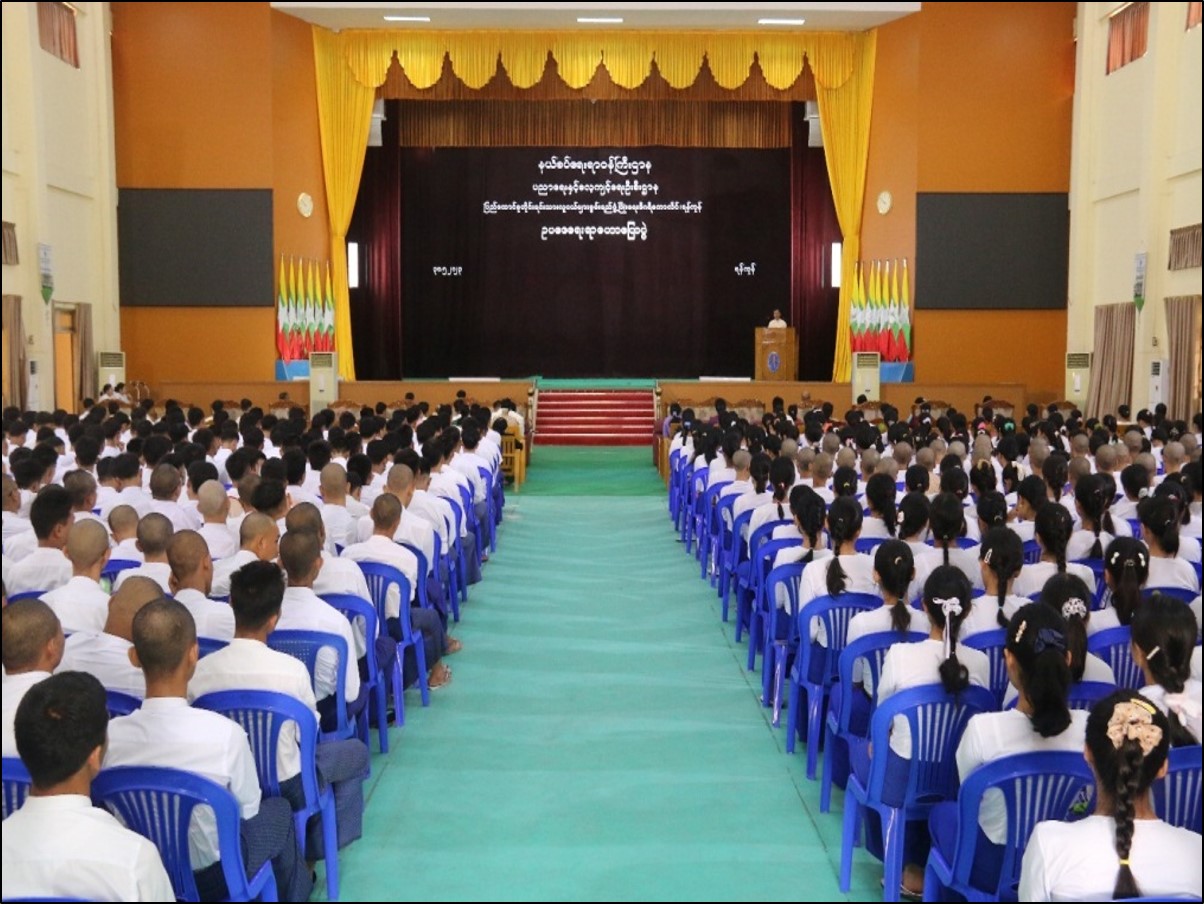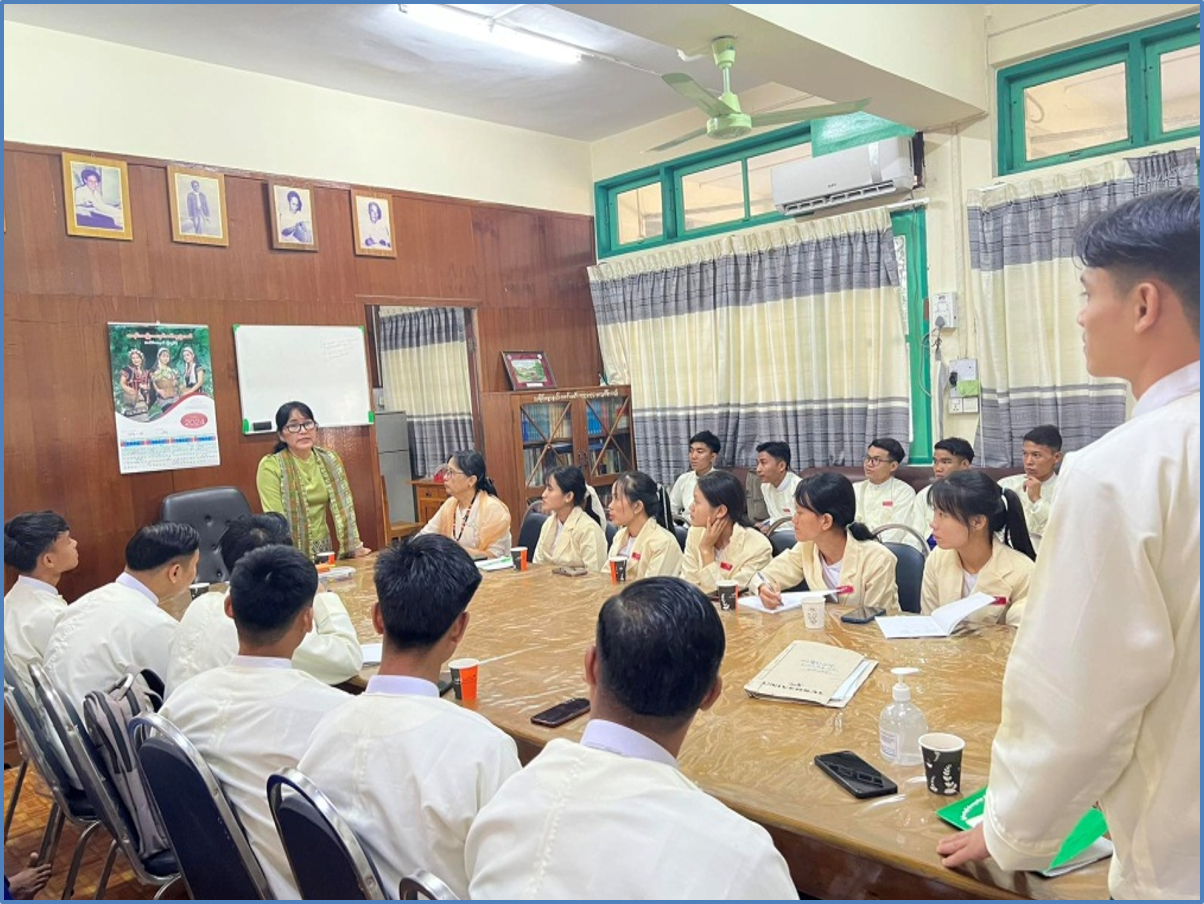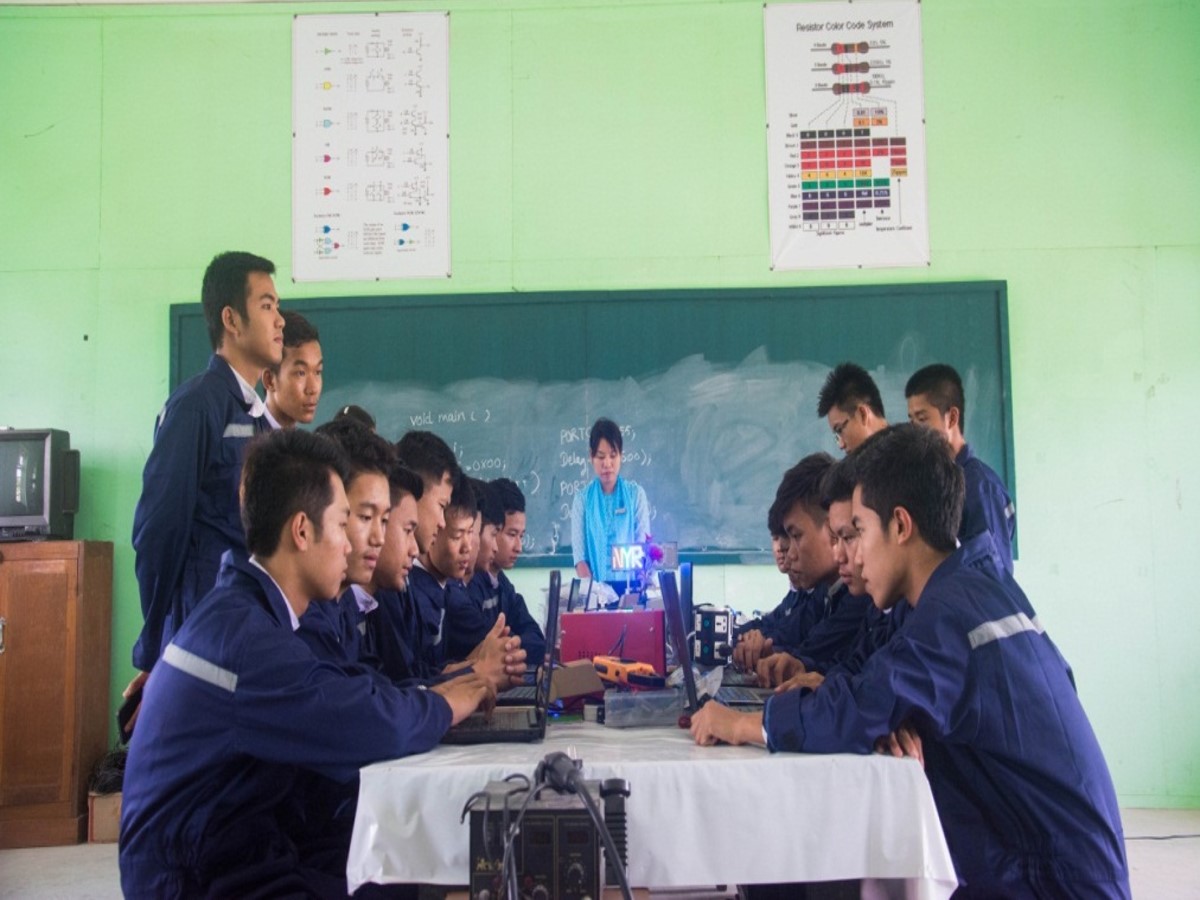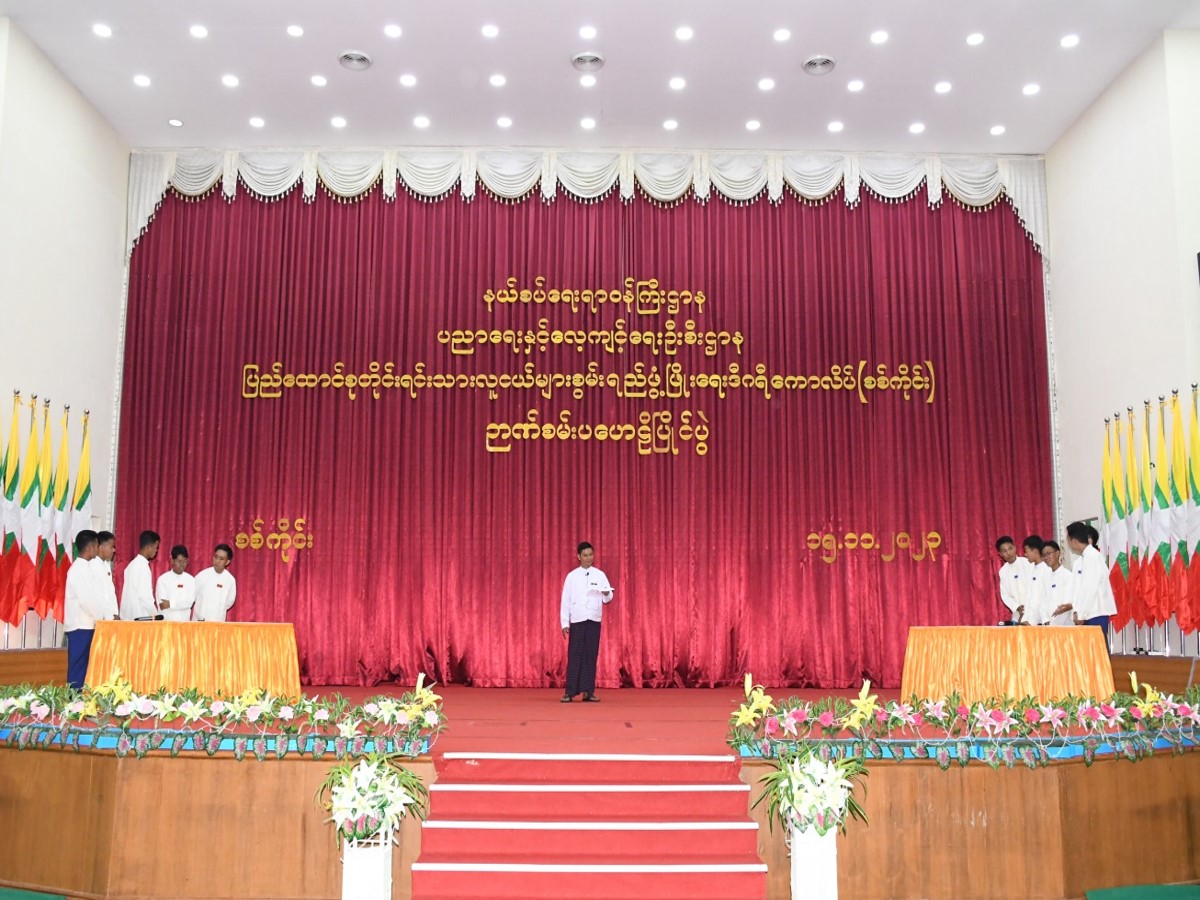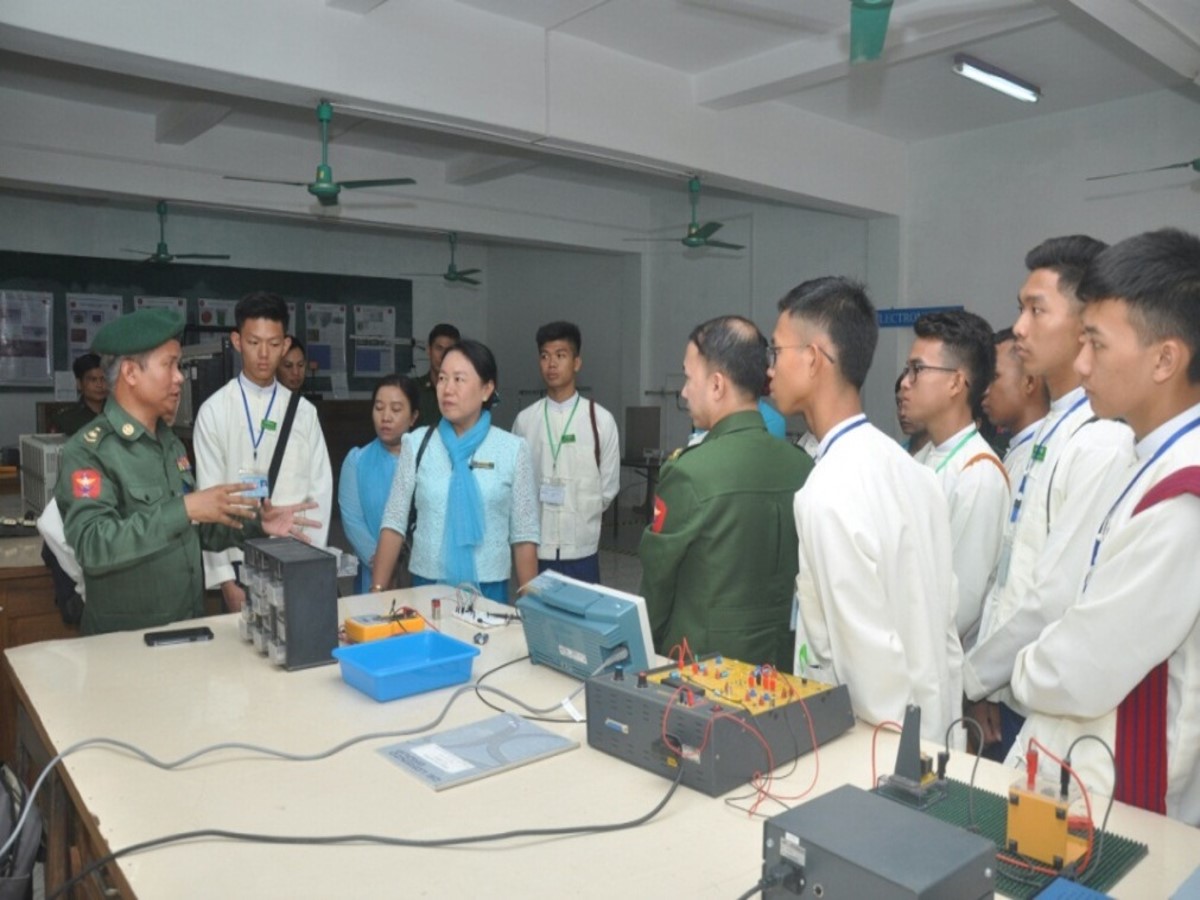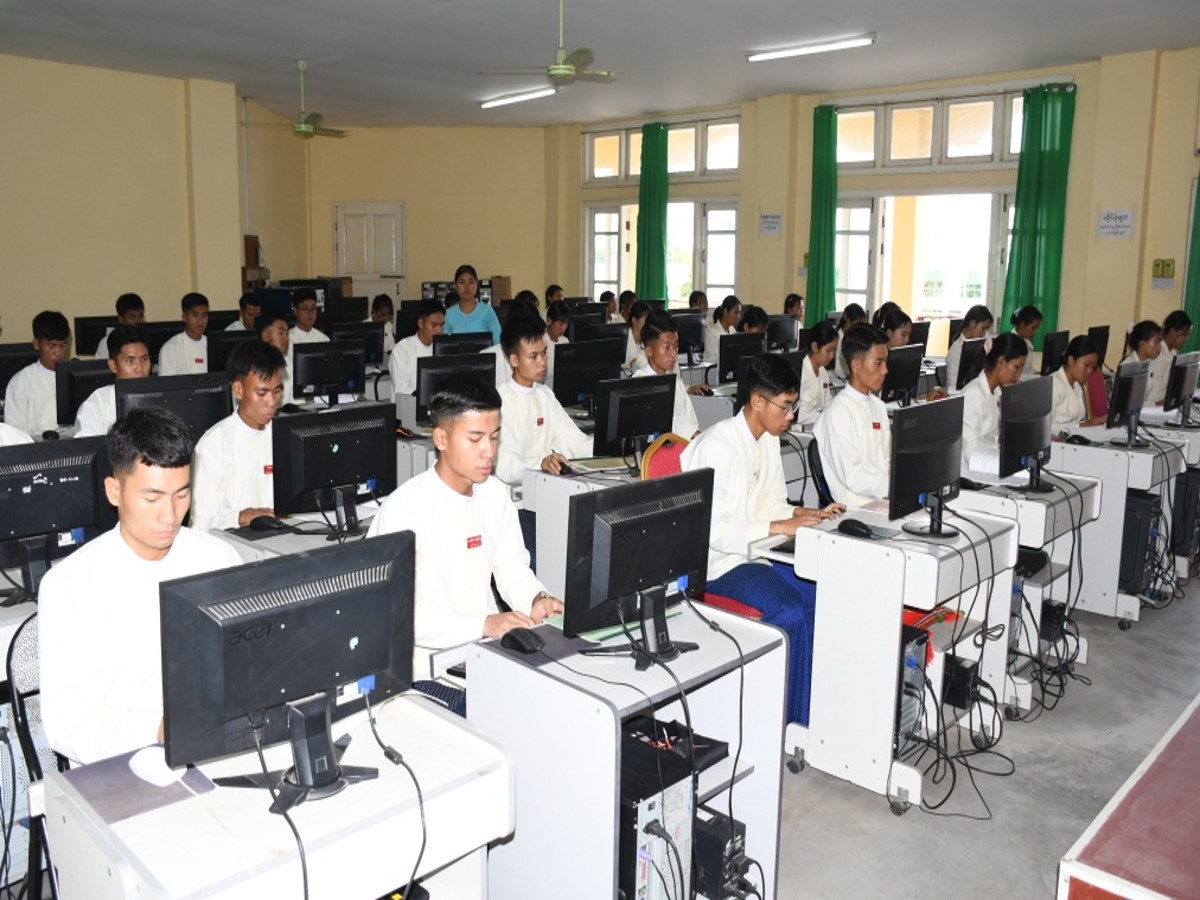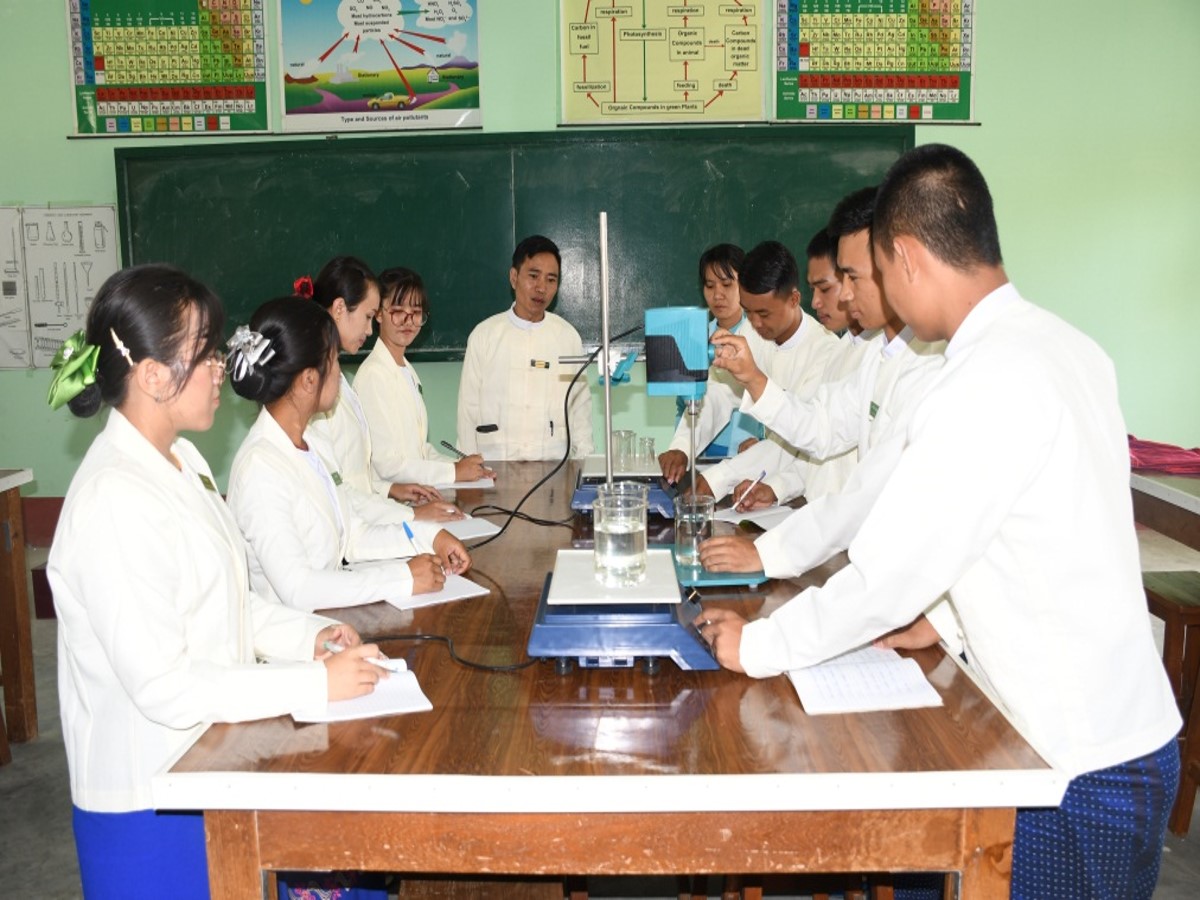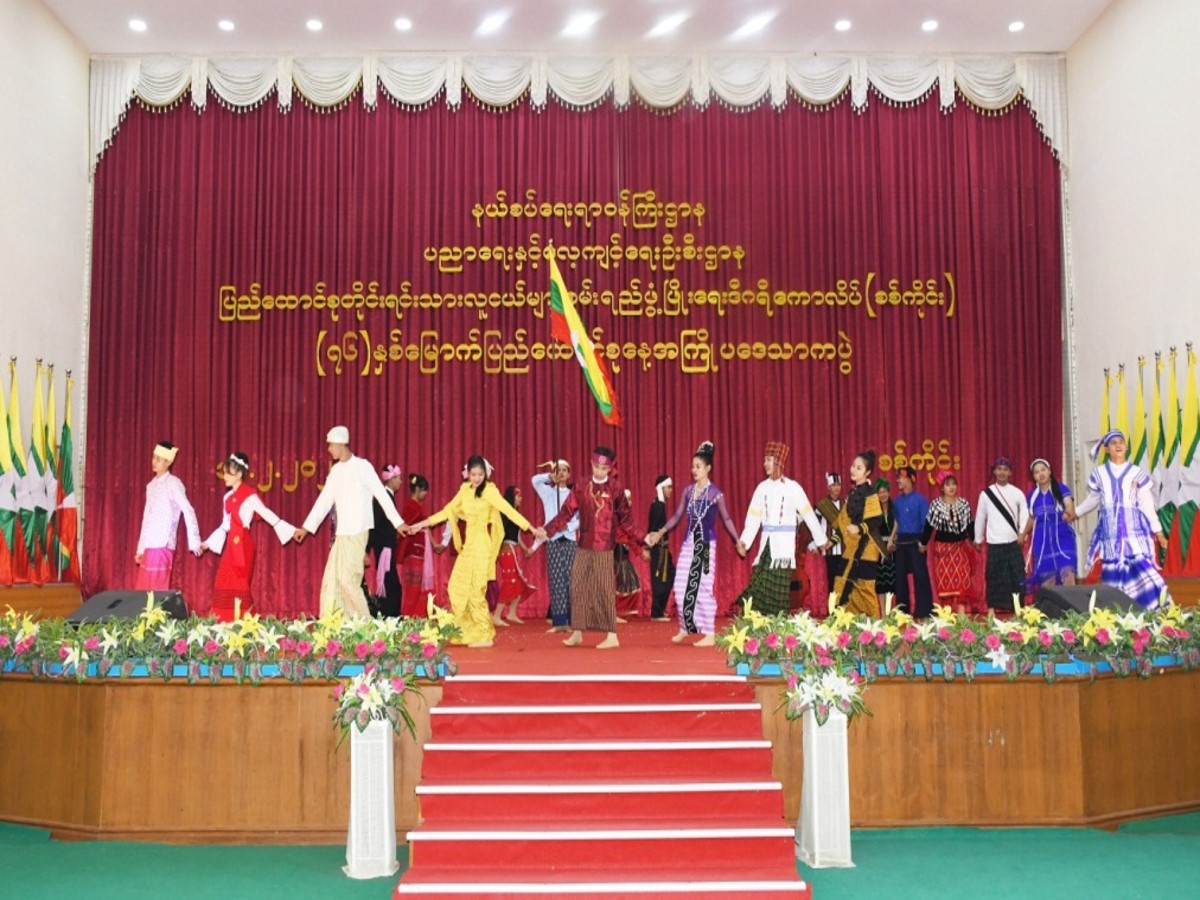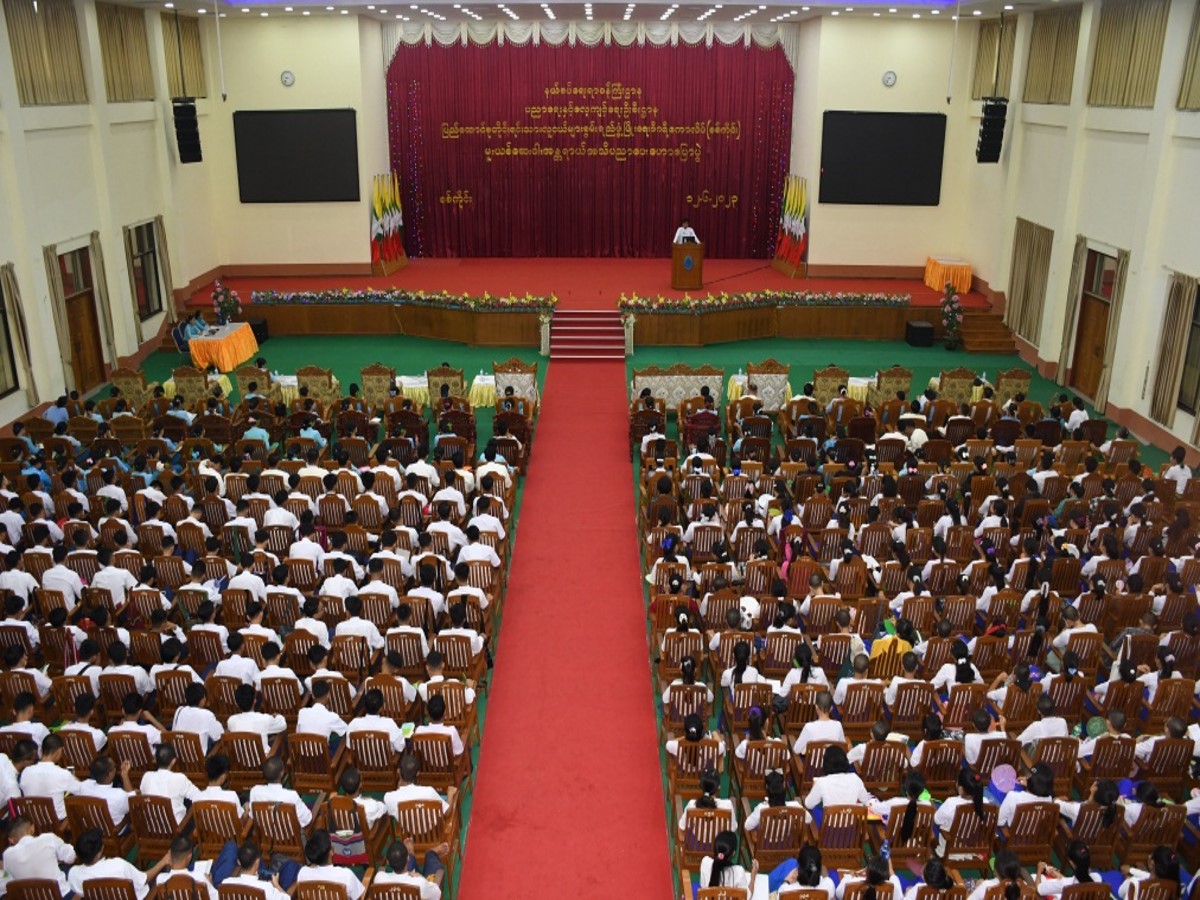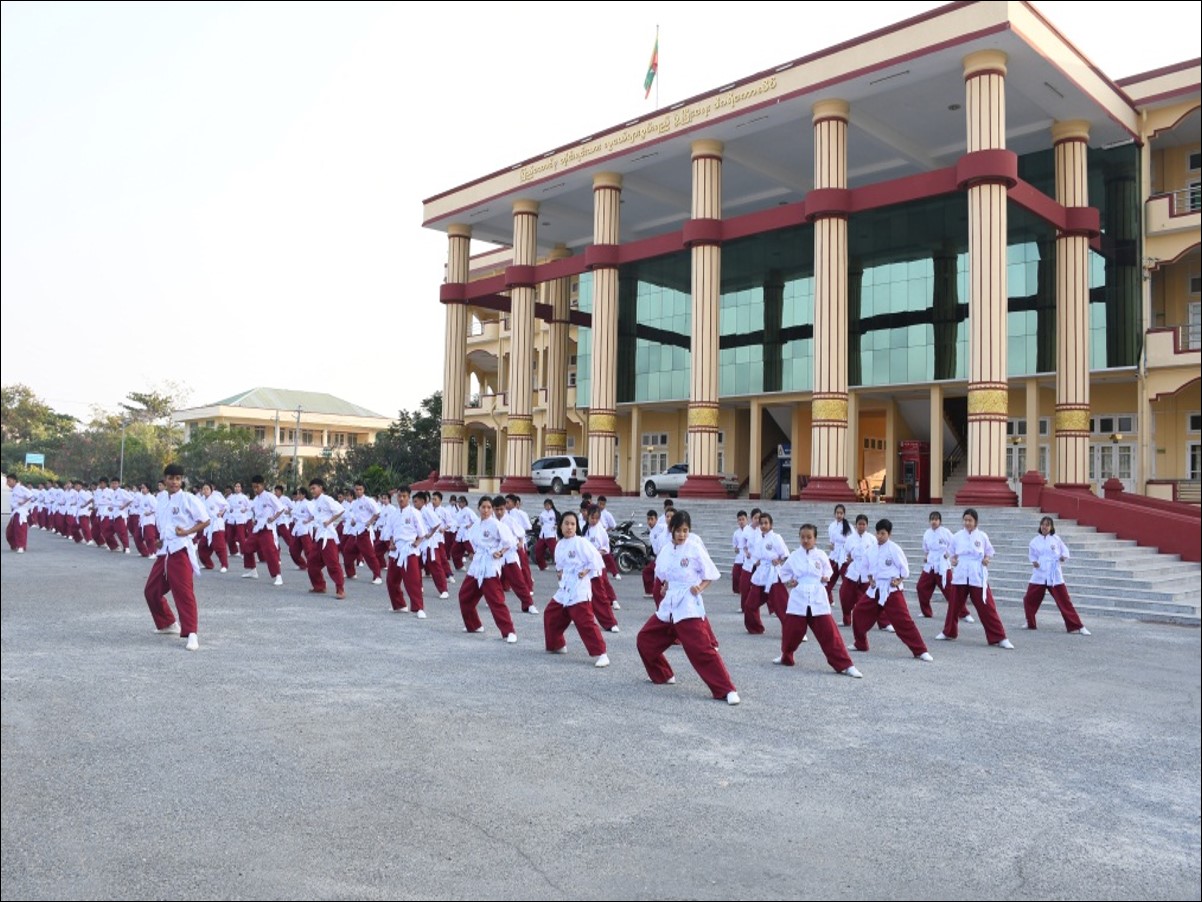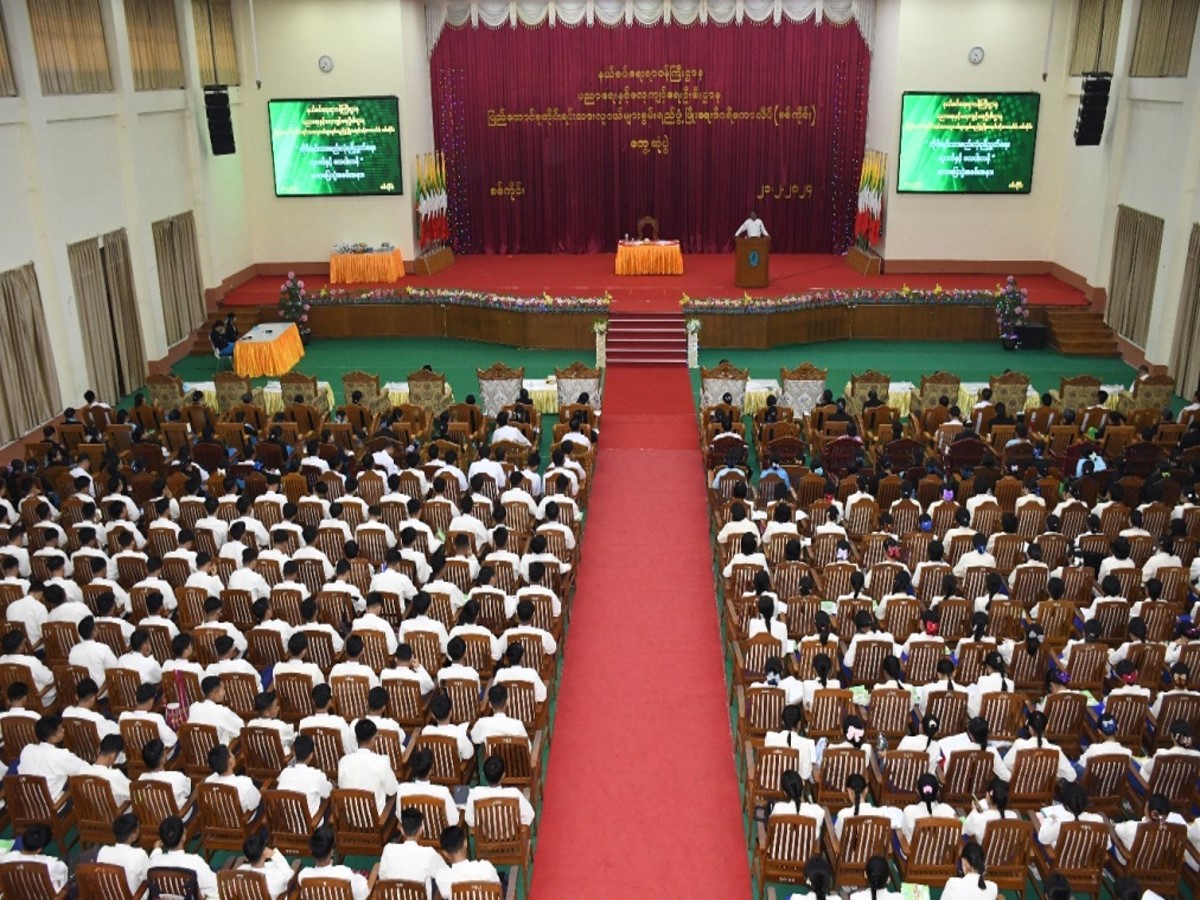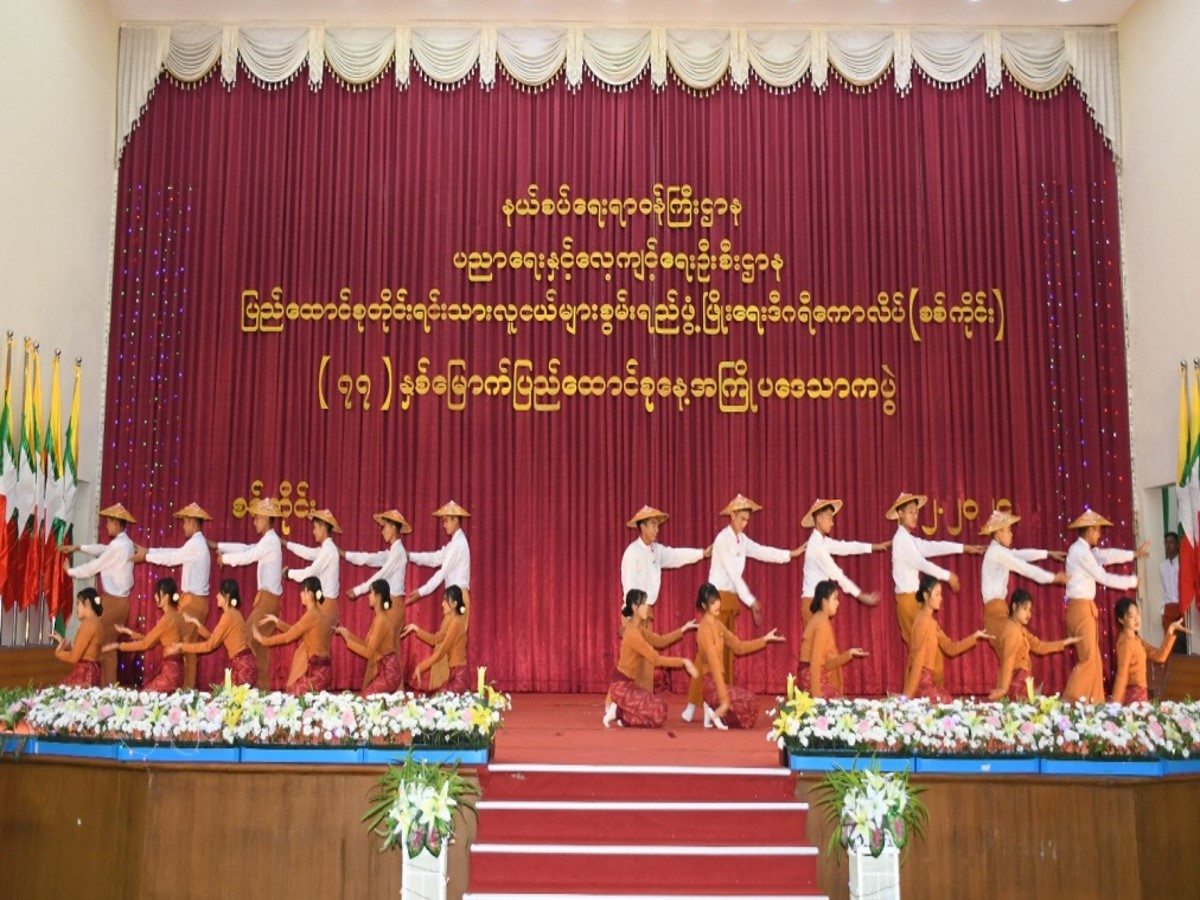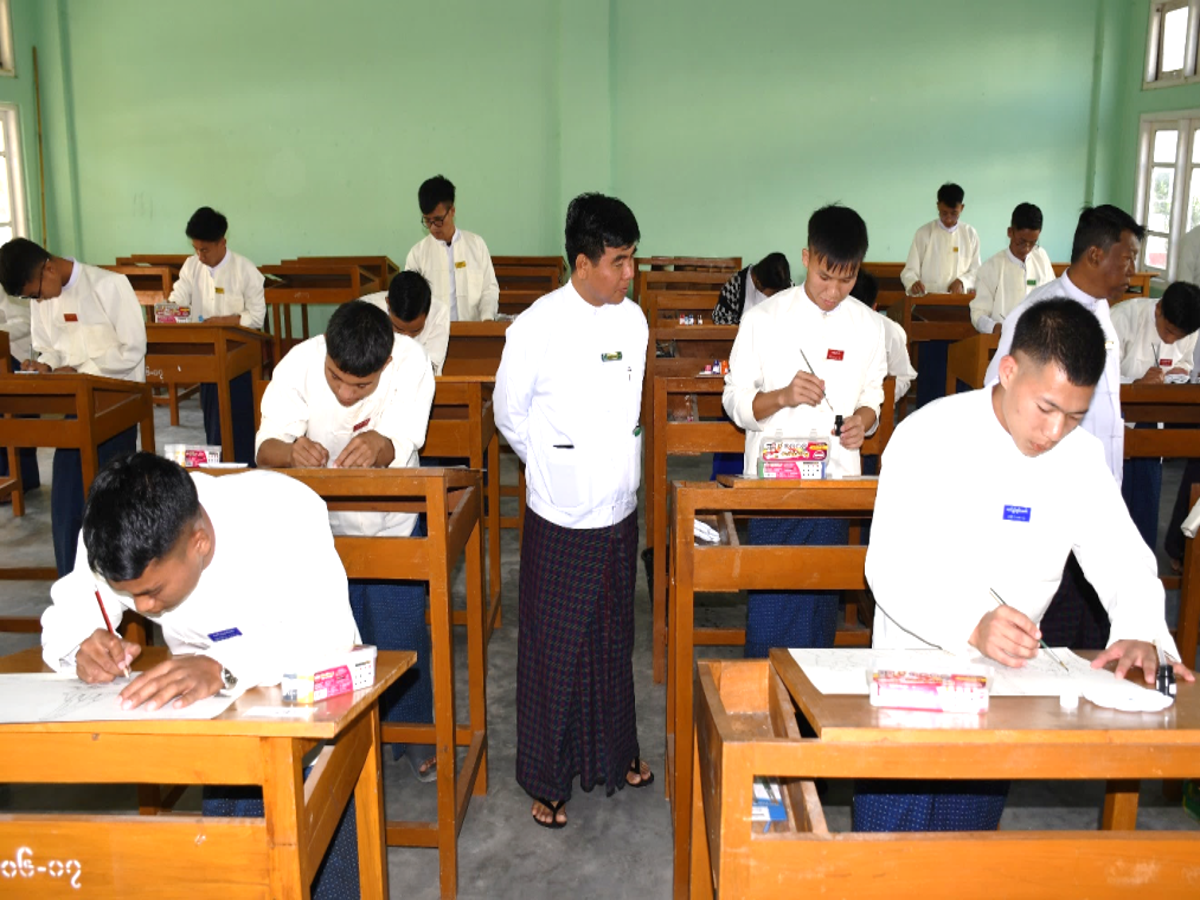Ministry of Border Affairs
Ministry of Border Affairs
Background History
Since Myanmar regained her independence, there emerged armed groups due to misunderstanding among the national races and difference in ideology. For this reason, the successive governments could not implement border areas development measures. Border areas development measures together with peace and stability measures could be implemented with added momentum by laying down systematic plans when some national armed groups came into the legal fold in 1989. Border areas development measures were able to be carried out ¬with might and main in 1989 in accordance with the guidance of the Heads of the State fostering our three main national causes which are non-disintegration of the Union, non-disintegration of the national solidarity and perpetuation of the sovereignty of the State and focusing on peace and tranquility, national solidarity and regional development.
To take responsibility and carry out the office works of the Work Committee for the Implementation of the Development of the Border Areas and National Races while implementing development measures for the border areas and national races, the office of the Work Committee for the Implementation of the Development of the Border Areas and National Races was established as a separate office in accordance with the State Law and Order Restoration Council's Order No. (17/92) issued by the Office of the State Law and Order Restoration Council on 8th April, 1992 with 207 total staffs comprising 49 officers and 158 staffs.
In line with the various functions of the Office of the Work Committee for the Implementation of the development of the Border Areas and National Races, the border areas development measures need to be undertaken in a wider scale and to continuously supervise, monitor and co-ordinate these measures, therefore, Ministry for the Development of Border Areas and National Races was established with Notification No. (54/92) dated 14th September 1992. Then, the Ministry was reestablished at Ministry of Progress of Border Areas and National Races and Development Affairs with Notification No. (15/94) dated 30th January 1994.
At present, Ministry of Progress of Border Areas and National Races and Development Affairs was abolished by Notification No. (4/2011) issued by the President Office of the Government of the Republic of the Union of Myanmar on 30th March 2011 and Ministry of Border Affairs has been established.
Strategy of Ministry of Border Affairs
"To accelerate striving for the development of the border areas and national races, that have lagged for behind in development due to various reasons, without having any gap between the states and mainland areas."
The Organization of the Ministry
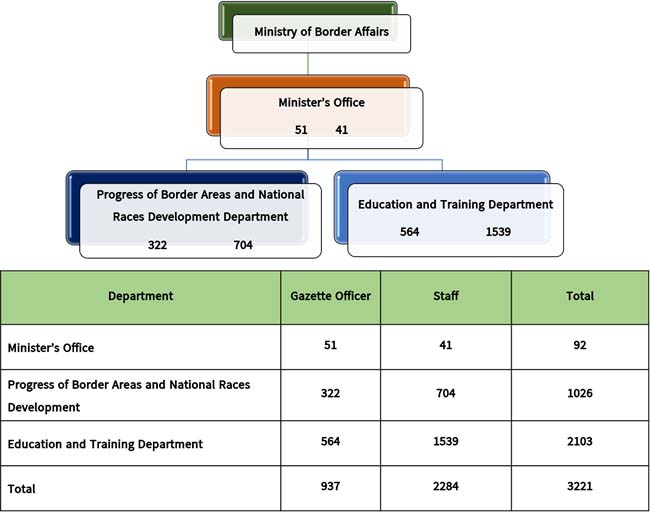
The Policies of the Ministry
Ministry of Border Affairs is carrying out the development of border areas and national races and human resource development by laying down the following 4 policies;
(a) Stability and tranquility in the border areas;
(b) Development of the border areas;
(c) Development of socio-economic condition of the people in border areas; and
(d) Development of human resources of national races in border areas.
Missions of the Ministry
(a) To preserve and maintain the security, prevalence of law and order and regional peace and tranquility of the border areas;
(b) To strengthen the amity among national races;
(c) To develop socio-economy of national races by establishing infrastructure in border areas;
(d) To preserve the culture, literature and custom of the national races;
(e) To propagate religious affairs in the border areas;
(f) To support nationalities youth to be able to pursue basic education, higher education and professional education for the future; and
(g) To serve the development of their respective regions by their willingness.
Functions of the Ministry
(a) Designating special development zones for the development of border areas and national races;
(b) Drawing up the long-term and short-term plans for the development of national races residing in border areas;
(c) Implementing the long-term and short-term plans which are approved by the Central Committee for the Development of Border Areas and National Races;
(d) Implementing the development works which have been prescribed for immediate performance by the Central committee for the development of Border Areas and National Races;
(e) Implementing socio-economic infrastructure for the border areas with annual plans such as:
1. Roads and bridges;
2. Water supply:
(aa) to supply water for cultivation;
(bb) to supply water for drinking;
3. Electricity:
(aa) Hydro-electric;
(bb) solar energy system;
4. Religious Affairs;
5. Construction work for Peace:
(aa) Roads and bridges;
(bb) Education;
(cc) Health;
(dd) Housing;
(f) Giving chances for Nationalities Youth living in different border areas to be able to attend schools from Basic Education Middle School to High School for free of charge;
(g) Supporting Nationalities Youth who pass the basic education high school to pursue higher education at the University for Development of the National Races of the Union and Nationalities Youth Resource Development Degree Colleges;
(h Consolidating the Union Spirit and amity among the Nationalities Youth while studying together at the schools, degree colleges and university and to understand and cherish the culture tradition, customs and practices of national races;
(i) Nurturing nationalities youth to exist in their mind as non-disintegration of the Union, non-disintegration of the Union, non-disintegration of national solidarity and perpetuation of sovereignty;
(j) Appointing the nationalities youth at the respective Ministries after completing higher education so that they can participate in their regional development work;
(k) Teaching vocational expertise to the national races women in the border areas and assisting them to set up their own business applying with their vocational skills;
(l) Teaching engineering to the Nationalities Youth in the border areas with the aim of becoming skillful workers and carrying out the development of small skill manufacturing and industries;
(m) Carrying out cultural exchanging programs to enrich a wider knowledge for the nationalities youth in the border areas;
(n) Carrying out national affairs as a priority in accordance with the desire of nationalities;
(o) Implementing the promotion and propagation of religious affairs in the border areas;
(p) Establishing crops cultivation, livestock breeding and cottage industries in order to substitute poppy cultivation;
(q) Protecting and preserving border boundary pillars and markers; and
(r) Managing for the cooperating with United Nations Organizations, International Organizations, Regional Organizations and respective persons in order to effectively implement the border areas development and human resource development.
Organization Committees
In order to carry out measures for the development of border areas and national races systematically, the Government started to form “The Central Committee for the Implementation of the Development of Border Areas and National Races” with 5 members by the State Law and Order Restoration Council’s Order No. (23/89) dated 25th May 1989 and now, the Central Committee was reconstituted by the State Administration Council's Notification No. (34/2023) dated 23th August 2023 as follows:
|
Sr. No. |
Name and Designation |
Duty |
|
1. |
Chairman of the State Administration Council, Prime Minister |
Chairman |
|
2. |
Vice Chairman of the State Administration Council, Deputy Prime Minister |
Vice Chairman |
|
3. |
Deputy Prime Minister and Minister of Defense |
Member |
|
4. |
Union Minister, Ministry of Home Affairs |
Member |
|
5. |
Chief Ministers, Government of the Regions/States |
Member |
|
6. |
Chief of the General Staff (Army, Navy and Air) |
Member |
|
7. |
Director, Directorate of People's Militia and Territorial Forces |
Member |
|
8. |
Union Minister, Ministry of Border Affairs |
Secretary |
|
9. |
Deputy Minister, Ministry of Border Affairs |
Joint Secretary |
Duties of the Central Committee
a. Laying down the policy in order to implement the objectives;
b. Approving, giving guidance and instructing for the implementation of long-term and short-term master plans which are drawn up by the Ministry and submitted through the work Committee.
c. Laying down development works which should be carried out immediately at the border areas and instructing implementation thereof;
d. Laying down work plans and instructing implementation thereof with a view to maintain the culture, literature and customs of the national races;
e. Laying down measures for maintaining security, prevalence of law and order and regional peace and tranquility in order to continuously accelerate the development works at the border areas;
f. Approving Development Areas which should be expanded.
Powers of the Central Committee
a. The Central Committee shall form the Work Committee;
b. The Central Committee shall determine the Chairman and Secretary in forming the Work Committee, and may determine the Vice-Chairman and Joint-Secretary if necessary.
“Work Committee for the Development of Border Areas and National Races” was started to form with 17 members by the State Law and Order Restoration Council Order No. (24/89) dated 31st May 1989 and now, the Work Committee is reconstituted by the Central Committee's Notification No. (30/2023) dated 10th May 2023 as follows:
|
Sr. No. |
Name and Designation |
Duty |
|
1. |
Union Minister, Ministry of Border Affairs |
Chairman |
|
2. |
Deputy Minister, Ministry of Home Affairs |
Member |
|
3. |
Deputy Minister, Ministry of Transport and Communications |
Member |
|
4. |
Deputy Minister, Ministry of Planning and Finance |
Member |
|
5. |
Deputy Minister, Ministry of Agriculture, Livestock and Irrigation |
Member |
|
6. |
Deputy Minister, Ministry of Cooperative and Rural Development |
Members |
|
7. |
Deputy Minister, Ministry of Electric Power |
Member |
|
8. |
Deputy Minister, Ministry of Education |
Member |
|
9. |
Deputy Minister, Ministry of Science and Technology |
Member |
|
10. |
Deputy Minister, Ministry of Health |
Member |
|
11. |
Deputy Minister, Ministry of Ethnic Affairs |
Member |
|
12. |
Minister, Ministry of Security and Border Affairs (Region/State Government) |
Member |
|
13. |
Deputy Director, Directorate of People's Militia and Territorial Forces |
Member |
|
14. |
Permanent Secretary, State Administration Council Office |
Member |
|
15. |
Permanent Secretary, Ministry of Border Affairs |
Member |
|
16. |
Permanent Secretary, Ministry of Construction |
Member |
|
17. |
Permanent Secretary, Ministry of Information |
Member |
|
18. |
Permanent Secretary, Ministry of Religious Affairs and Culture |
Member |
|
19. |
Permanent Secretary, Ministry of Industry |
Member |
|
19. |
Permanent Secretary, Ministry of Immigration and Population |
Member |
|
20. |
Permanent Secretary, Ministry of Sports and Youth Affairs |
Member |
|
21. |
Permanent Secretary, Ministry of Construction |
Member |
|
22. |
Permanent Secretary, Ministry of Social Welfare, Relief and Resettlement |
Member |
|
23. |
Deputy Minister, Ministry of Border Affairs |
Secretary |
|
24. |
Director General, Progress of Border Areas and National Races Department |
Joint Secretary |
Duties and powers of the Work Committee
a. Scrutinizing long-term and short-term master plans drawn up and submitted by the Ministry and submitting and obtaining approval of the Central Committee;
b. Giving guidance for the implementation of long-term and short-term master plans, which have been approved by the Central Committee and supervising and inspecting the works;
c. Giving guidance for the implementation of development works which have been prescribed for immediate performance by the Central Committee and supervising and inspecting the works;
d. Forming Work Sub-Committees at the central level and determining the duties there of; and
e. Forming Regional Work Committees and determining the duties there of.
In accordance with the policies laid down by the Central Committee for the Implementation of the Development of Border Areas and National Races, the Work Committee for the Development of Border Areas and National Races was formed 13 Work Sub-Committees on 31st May, 1989. Then, by the decision of Work Committee meeting (3/94) on 3rd October 1994 and the President Office's Notification No. 6/11 dated 20th April, 2011, 18 Work Sub-Committees was reconstituted in which Union Minister/ Deputy Ministers from the respective Ministry are assigned as Chairman and heads of department are assigned as members. Then, 13 Work Sub-Committees were reconstituted according to the Notification No.60/2012 issued by the President Office on 24th August, 2012. After that, according to the Union Government Office's Notification No. (8/2016) dated 16th November, 2016, 7 Work Sub-Committee have been reconstituted and now, in accordance with the Notification No. (1/2023) dated 22nd September, 2023 by the Work Committee for the Development of Border Areas and National Races, 7 Work Sub-Committee have been reconstituted as follows;
a. Work Sub-Committee for Roads and Bridges and Infrastructure Development;
b. Work Sub-Committee for Education, Health and Human Resource Development;
c. Work Sub-Committee for Agriculture, Livestock and Natural Resources;
d. Work Sub-Committee for Energy and Electricity;
e. Work Sub-Committee for Transportation, Communication and Tourism Development;
f. Work Sub-Committee for Religious and Culture;
g. Work Sub-Committee for Rural Development, Social Welfare and Vocational Education.
In order to implement the development measures for border areas and national races, 11 Regional Work Committees were formed since 13th June, 1989 in which Commanders of Military Commands and Chairmen of the States acted as Chairmen of the respective Regional Work Committee. Moreover, respective work committees had been formed at the district and township levels. In accordance with the President Office's Notification No. (6/11) dated on 20th April, 2011, Chief Minister of the respective Region/State were assigned as Chairman of Regional Work Committee. By the decision of (1/2012) meeting of "The Work Committee for the Development of Border Areas and National Races", 9 Regional Work Committees were reconstituted and now, according to the decision of the Work Committee's Meeting (2/2023), 9 Regional Work Committees are reconstituted as follows:
a. Kachin State Regional Work Committee;
b. Kayah State Regional Work Committee;
c. Kayin State Regional Work Committee;
d. Chin State Regional Work Committee;
e. Mon State Regional Work Committee;
f. Rakhine State Regional Work Committee;
g. Shan State Regional Work Committee;
h. Sagaing Region Regional Work Committee; and
i. Tanintharyi Region Regional Work Committee.
Development of Border Areas and National Races Law
In order to effectively and systematically carry out development measures of border areas and national races, the Government enacted "Development of Border Areas and National Races Law" with Law No.11/93 on 13th August, 1993. To be in line with the current situation at that time, the State Peace and Development Council enacted "the Law Amending the Development of Border Areas and National Races Law" with Law No.7/2006 on 11th August, 2006. Then, "The Second Amendment of the Development of Border Areas and National Races Law" with Law No. 44/2015 was enacted on 22nd July, 2022.
The Master Plan for the Development of Border Areas and National Races was drawn up. Under this Master Plan, the 13-year plan, in which the first short-term 3-year plan from 1993-1994 fiscal year to 1995-1996 fiscal year, the first medium-term 5-year plan from 1996-1997 fiscal year to 2000-2001 fiscal year and the second medium-term 5-year plan from 2001-2002 fiscal year to 2005-2006 fiscal year, was implemented. Then, 30-year long-term plan for the development of border areas and national races, which is starting form 2001-2002 fiscal year up to 2029-2030 fiscal year, had been drawn up and implemented with 6 medium-term 5-year plan. In line with the current situation, 20 year long-term plan from 2011-2012 fiscal year to 2030-2031 fiscal year for the development of borders areas is being implemented.
Management Structure for the implementation of Border Areas Development measures
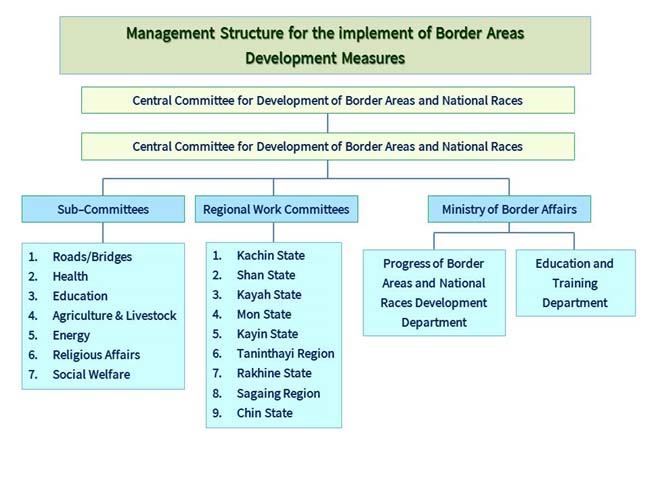
The Progress of Border Areas and National Races Department
The Progress of Border Areas and National Races Department has been carrying out regional development measures and measures for socio-economic development of the people in border areas in (116) townships of (7) States, (2) Regions, (1) Self-Administered Region and (5) Self-Administered Zones and in (52) townships according to work necessity and thus, these measures are being implemented in a total of (168) townships and also in the Regions that are necessary to be implemented due to instructions made by the state level personnel, submissions by Region/State Governments and submissions by Htuttaw Representatives.
The entitled works in implementing border areas development measures are as follows;
a. Roads/Bridges sector;
b. Education sector;
c. Health sector;
d. Agriculture sector;
e. Drinking water supply sector;
f. Energy sector;
g. Public relations sector;
h. Religious affairs sector;
i. Housing sector.
Under Progress of Border Areas and National Races Department, the Department (Headquarters) and Regions/States Development Supervisory Offices are established as follows;
Regions/States Development Supervisory Offices
|
Sr.No |
Region |
State/Region Development Supervisory Office |
State Branch Office |
District Development Supervisory Office |
Township Development Supervisory Office |
|
1. |
Myitkyina |
1 |
|
3 |
8 |
|
2. |
Taunggyi |
1 |
2 |
10 |
18 |
|
3. |
Loikaw |
1 |
|
1 |
4 |
|
4. |
Pha-an |
1 |
|
2 |
5 |
|
5. |
Mawlamyine |
1 |
|
1 |
5 |
|
6. |
Dawae |
1 |
|
2 |
4 |
|
7. |
Sittway |
1 |
|
3 |
8 |
|
8. |
Monywa |
1 |
|
4 |
8 |
|
9. |
Hakha |
1 |
|
2 |
4 |
|
10. |
Meikhtilar |
|
|
1 |
|
|
11. |
Yangon |
|
|
1 |
|
|
12. |
Pyinmana |
|
|
1 |
|
|
|
Total |
9 |
2 |
31 |
64 |
Education and Training Department
Education and Training Department was established under Ministry of Border Affairs on 30th June, 1999 with the purposes of promoting and teaching basic and higher educational subjects to the nationalities youths from border areas and training and nurturing them to be intellectuals and intelligentsia who can serve for the development of their regions and providing vocational domestic science courses for young women from border areas and the Department is established as follows;
- The Department (Head Office);
- University for the Development of the National Races of the Union;
- Nationalities Youths Resource Development Degree Colleges;
- Central Training School;
- 45 Training Schools for Development of Nationalities Youths from Border Areas;
- 9 Technical Schools for Nationalities Youths from Border Areas;
- 45 Vocational Training Schools of Domestic Science for Women.
Processes for human resources development implemented by Education and Training Department
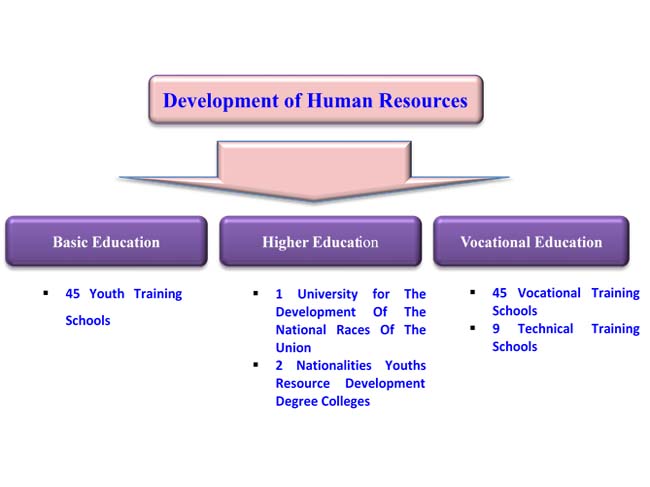
University for the Development of the National Races of the Union (Sagaing)
Background History
According to the 65th meeting of Revolutionary Council that was held on 5-2-1964, Academy for the Development of National Groups (ADNG) was established on 20-10-1964 with the aim to support the development and unity of national races.
According to State Law and Order Restoration Council Meeting No-(18/91) that was held on 2nd May, 1991, ADNG was upgraded into University level with the Document No- 01/Nawata(L)Sawa-18 of the Chairperson Office, State Law and Order Restoration Council and established with a total of (512)-(112) officials and (400) personnel.
The University for the Development of the National Races of the Union was handed over to the Ministry of Border Affairs on 1st April, 2012 and started implementing with a total of (551), (187) officials and (364) personnel, are serving in this University and transformed the constitution according to the Government Meeting No. (2/2015) that was held on 15.1.2015.
Location Area
The University for the Development of the National Races for the Union is located on Ywa Thit Gyi’s index (F-252619), about 4 miles south of NatkhaRine Village on the - Sagaing-Monywa Road, 22 miles from Sagaing. The location area of University is Field No(850/851), Registration No. (96/42/138) and the area is wide about 393.90 acres.
Aim
The objectives of the University for the Development of the National Races of the Union are as follows:
A. To strengthen the union spirit among the national races of the union while residing in a friendly atmosphere.
B. To produce good educational personnel who are free from party politics and who are of good moral character.
C. To enhance the quality of leadership and efficiency in carrying out the development of living standards and Border areas.
D. To cultivate the desire to carry out the research with a view for the success of the development of the nationalities.
E. To make the national youths become the youths who believe in and uphold our three main causes: non-disintegration of the union, non-disintegration of the national solidarity and ensuring the perpetual of the sovereignty of the state.
Degrees offered at UDNR
The degrees offered at UDNR are as Follows;
|
No |
Name of Courses |
Period |
Degree |
|
(A) |
Master of Education |
2 years |
MEd |
|
(B) |
Bachelor of Education |
5 years |
Bed
|
Educational Departments
In the University for the Development of the National Races of the Union (Sagaing), there are 21 educational departments and mention as follow:
A. Department of Educational Theory.
B. Department of Educational Psychology.
C. Department of Teaching Methodology.
D. Department of Myanmar.
E. Department of English.
F. Department of Mathematics.
G. Department of History.
H. Department of Geography.
I. Department of Economics.
J. Department of Chemistry.
K. Department of Physics.
L. Department of Biology.
M. Department of Computer Science.
N. Department of Physical Education.
O. Department of Fine Art.
P. Department of Music and Dancing.
Q. Department of Domestic Science.
R. Department of Industrial Art.
S. Department of National Languages and Culture.
T. Department of Agriculture and Animal Husbandry.
U. Department of Moral Education.
Offering appointment
All the graduates have been appointing at Basic Education High Schools under Ministry of Education with the rank of Senior Assistant Teacher.
Situation of Official Help given to each of the Trainees
(A) Food Supplies
(1) Rice - 2.25 lames
(2) Oil - 2.25 tickles
(3) Beans - 5 tickles
(4) Salt - 0.5 tickle
(5) Wetration (1 day) - 750 kyats
(6)Supplement nutrious - 570 kyats
(B) Clothing Supplies
(1) Myanmar Jacket for male/ Safari Coat for female - 1 Piece
(2) Paso/ Longyi - 2 pieces
(3) White shirt/ Myanmar jacket with an overlapping flap in front - 1 Piece
(4) Slippers - 1 Pair
(5) T-shirt - 2 pieces
(6) Trousers - 1 piece
(7) Canvas - 1 pair
(8) Socks - 1 pair
(9) Satchel/ shoulder bag - 1 piece
(C) Accommodation Supplies
(1) Mosquito Net - 1 piece
(2) Pillow - 1 piece
(3) Pillowcase - 1 piece
(4) Mattress - 1 piece
(5) White Sheet - 1 piece
(6) Blanket - 1 piece
(7) Cotton Quilt - 1 piece
(8) Towel - 1 piece
(D) Stationary Supplies
|
1. |
Pencil Case |
- 1 piece |
|
2. |
Exercise Book |
- 6 dozens |
|
3. |
Pen |
- 1 dozen |
|
4. |
Pencil |
- 6 pieces |
|
5. |
Ruler |
- 2 pieces |
|
6. |
Tutorial Book |
- 1 dozen |
(E) Stipend (1 month) - 3000 kyats
Scheduling and training of trainee's daily activities
- 5 : 00 Am - Getting up Time
- 5 : 40 to 6 : 20 Am - Time for Freshen up
- 6 : 20 to 07 :00 Am - Morning Practical Classes
- 7 : 00 to 7 : 30 Am - Breakfast Time
- 7 : 30 to 8 : 00 Am - Preparation Time for Classes
- 8 : 00 to 11 :30 Am - Morning Classes
- 11 : 30 to 12 :30 Am - Lunch Time
- 12 : 30 to 15 : 10 pm - Afternoon Classes
- 15 : 10 to 16 : 00 pm - Private time
- 16 : 00 to 17 : 00 pm - Practical Activities
- 17 : 00 to 18 : 00 pm - Private time
- 18 : 00 to 18 : 30 pm - Dinner Time
- 18 : 30 to 19 : 00 pm - Private Leisure Time
- 19 : 00 to 21 : 00 pm - Night Study Time
- 21 : 30 to 22 : 00 pm - Preparation for Bedtime
- 22 : 00 - Bed Time
Explanation:
- In the Morning Classes, Afternoon Classes and at Night Study time, the trainees must be ready 10 minutes earlier in their classrooms and Study Rooms.
- From Tuesday in the second week, their uniform wearing style must be assessed at 07:30 AM on every Tuesday.
- There are 4 periods of 50 minutes per period in the morning classes and 3 periods in the afternoon with 10 - minute - break after two periods.
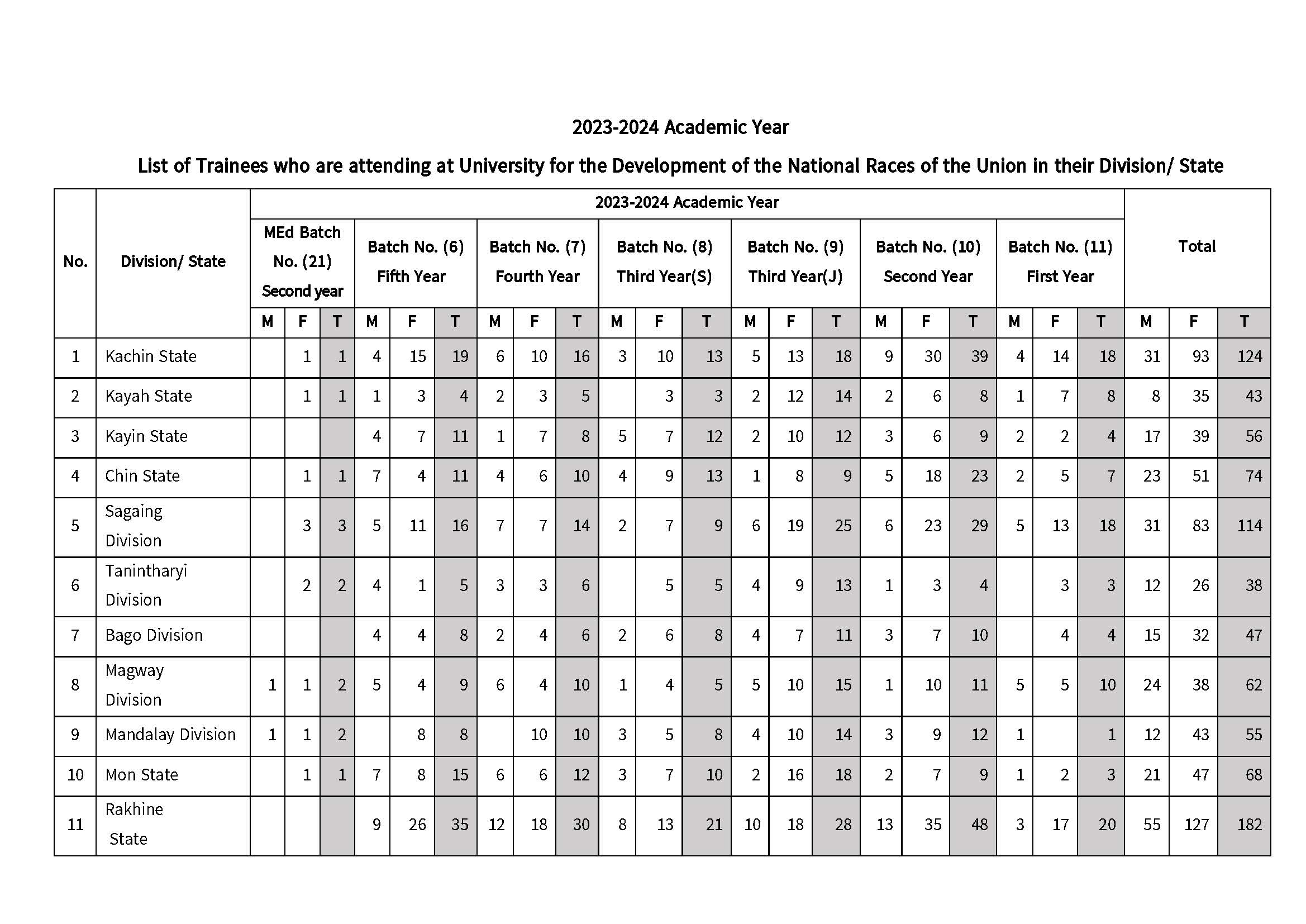
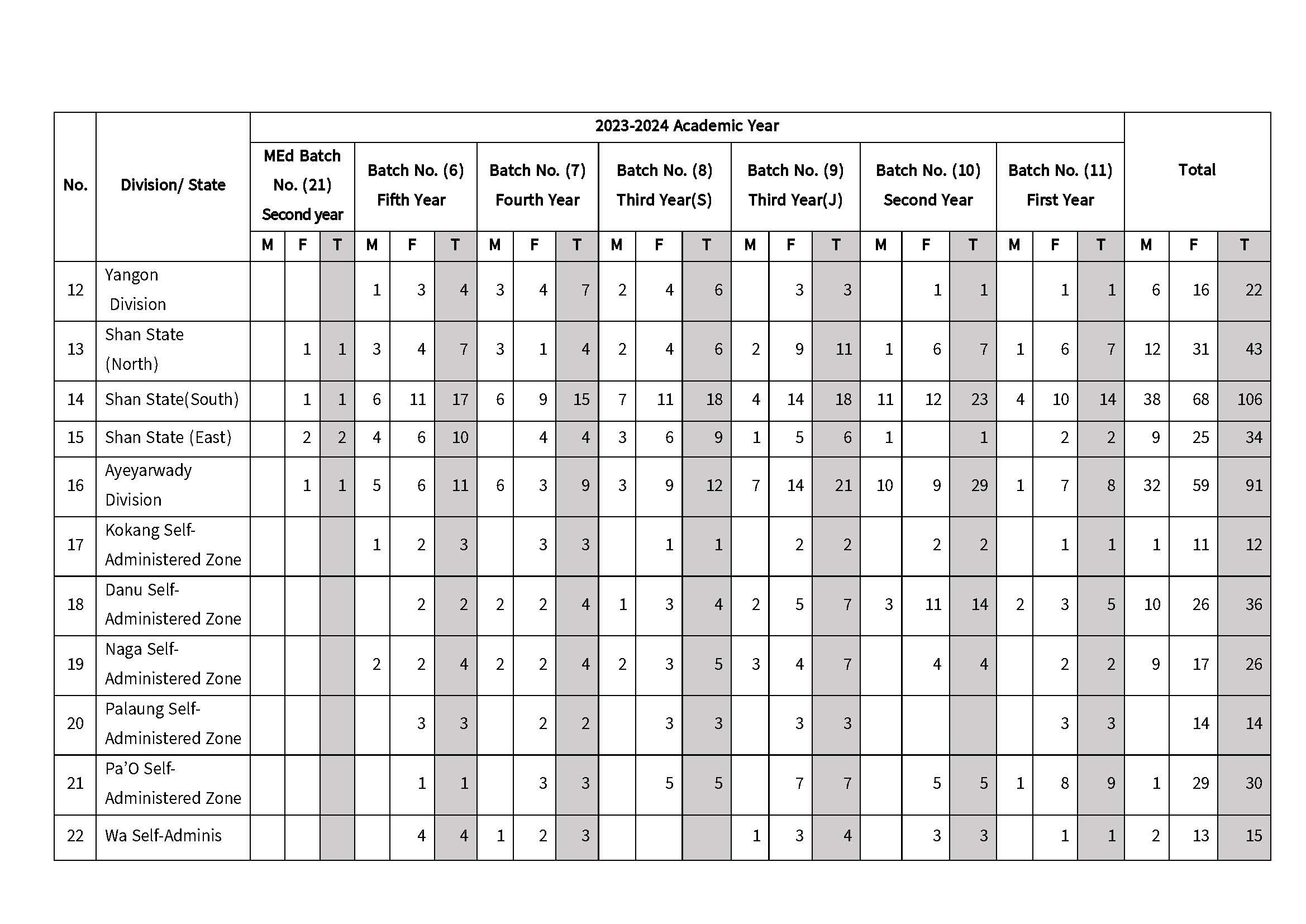
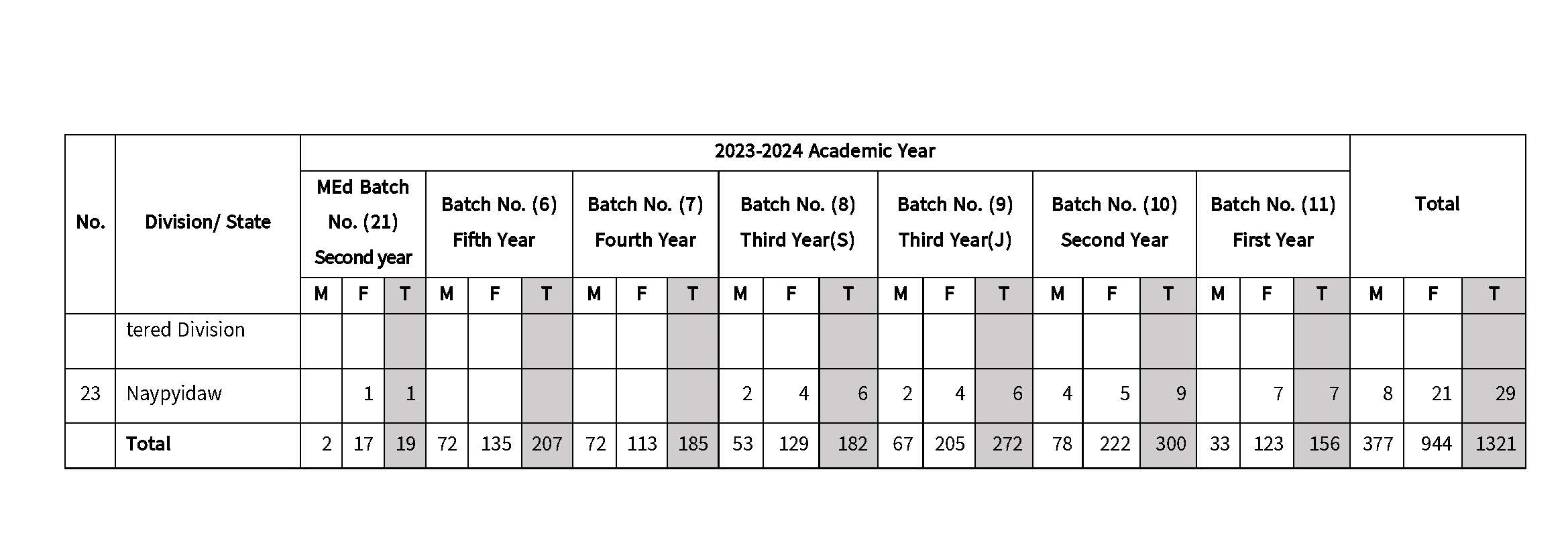
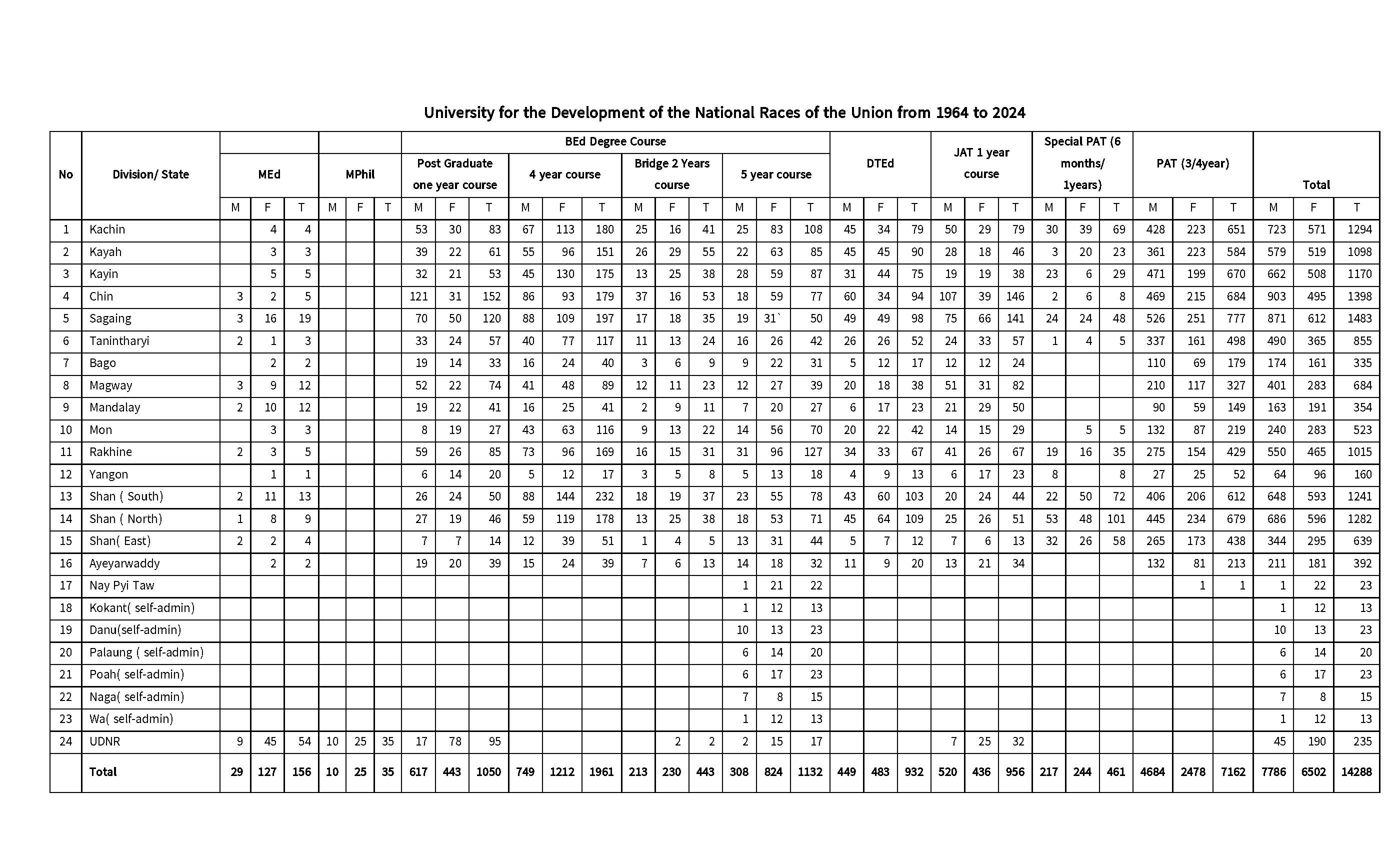
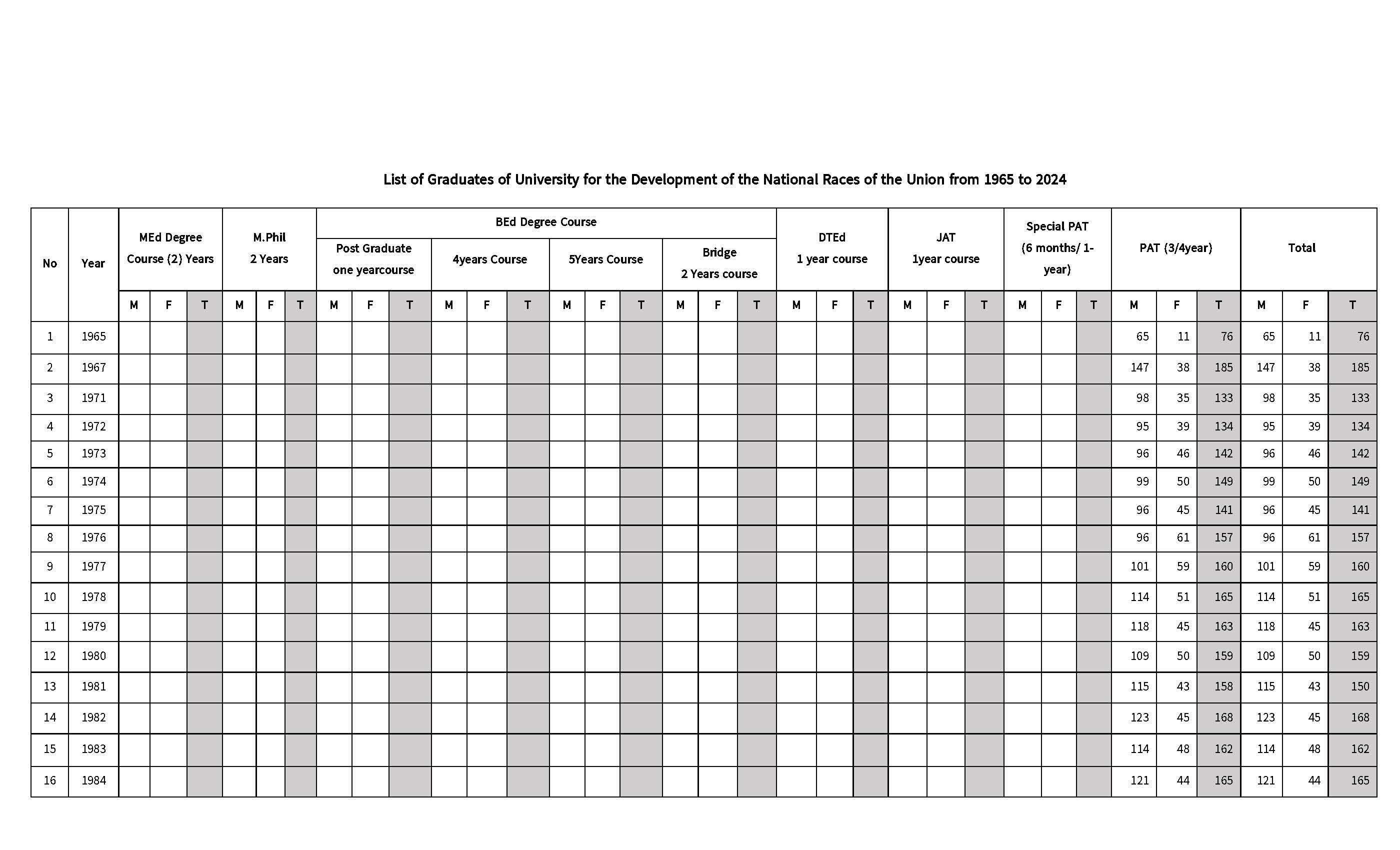
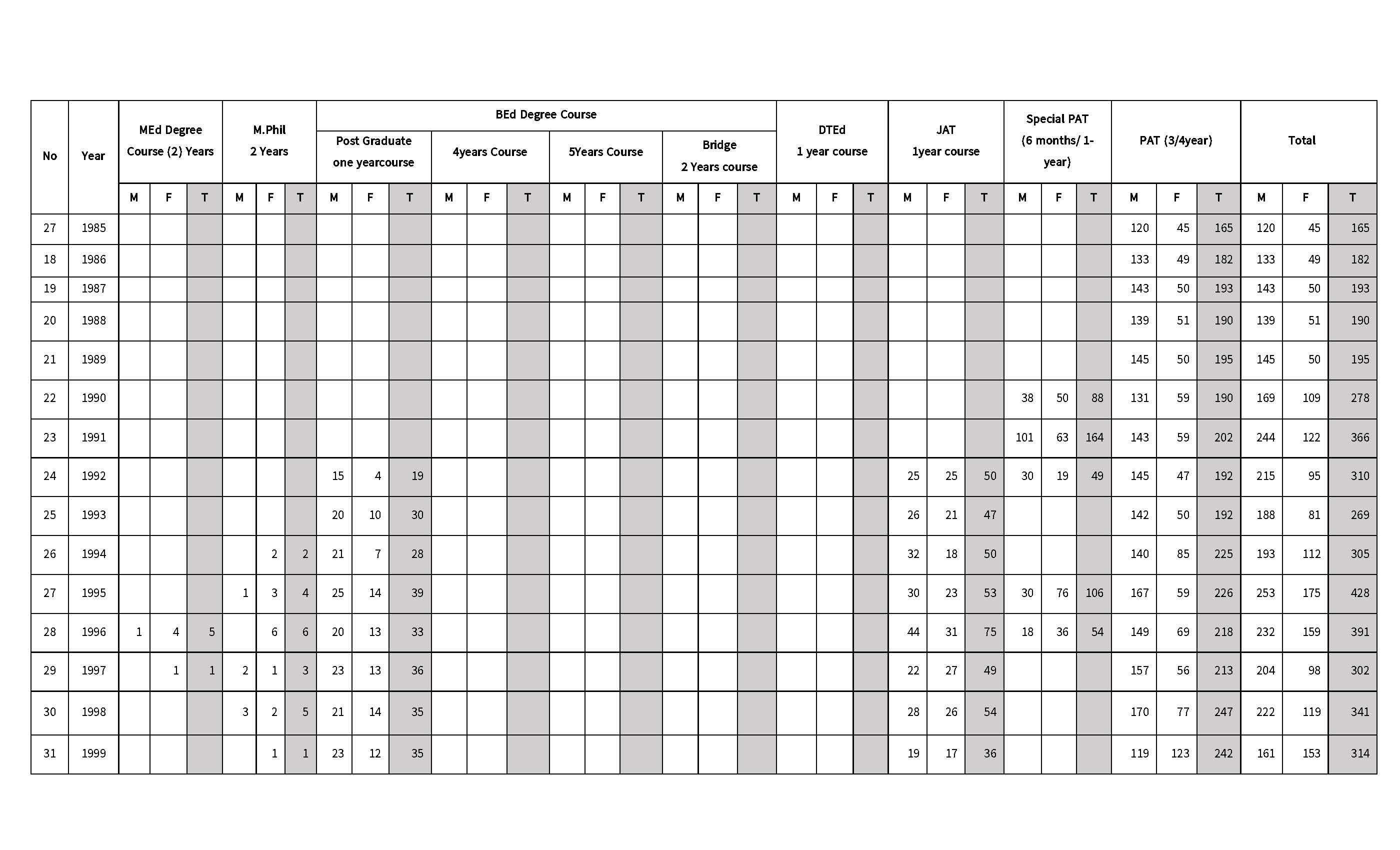
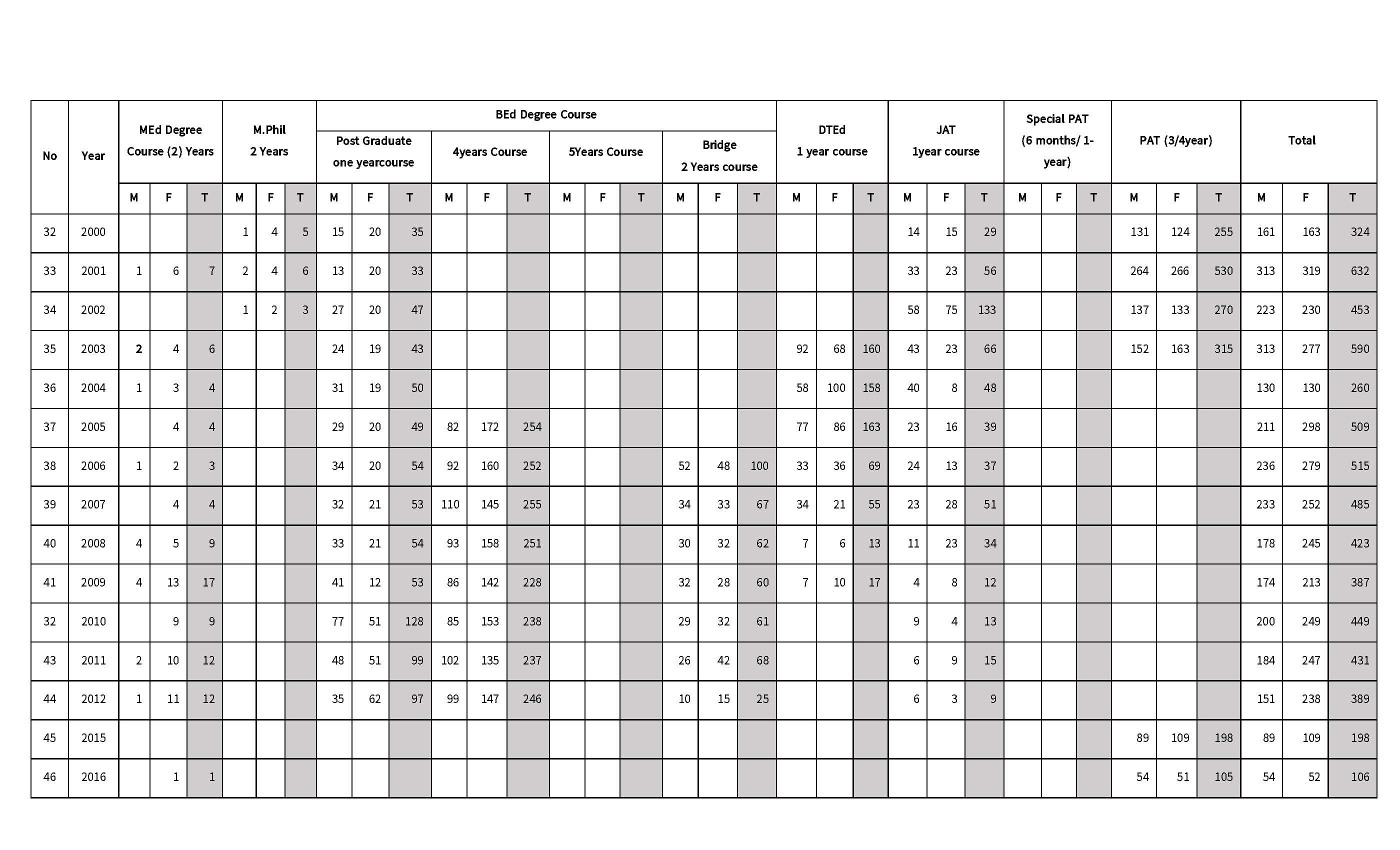
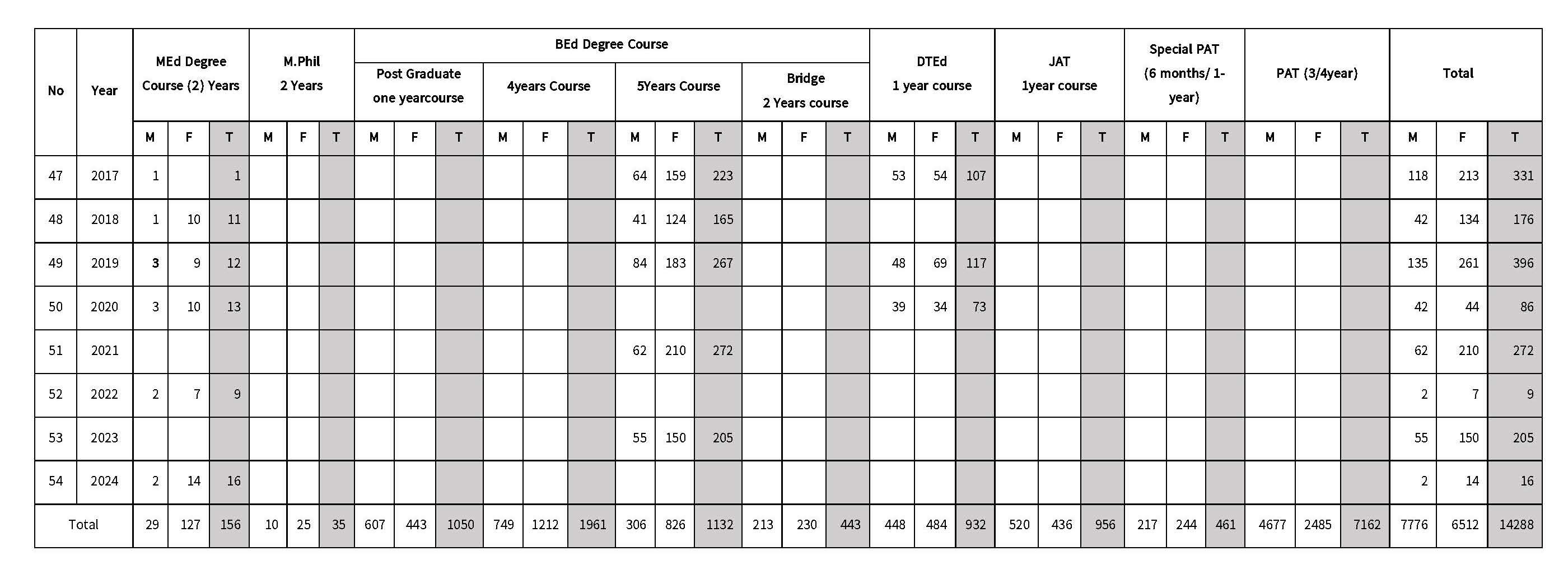
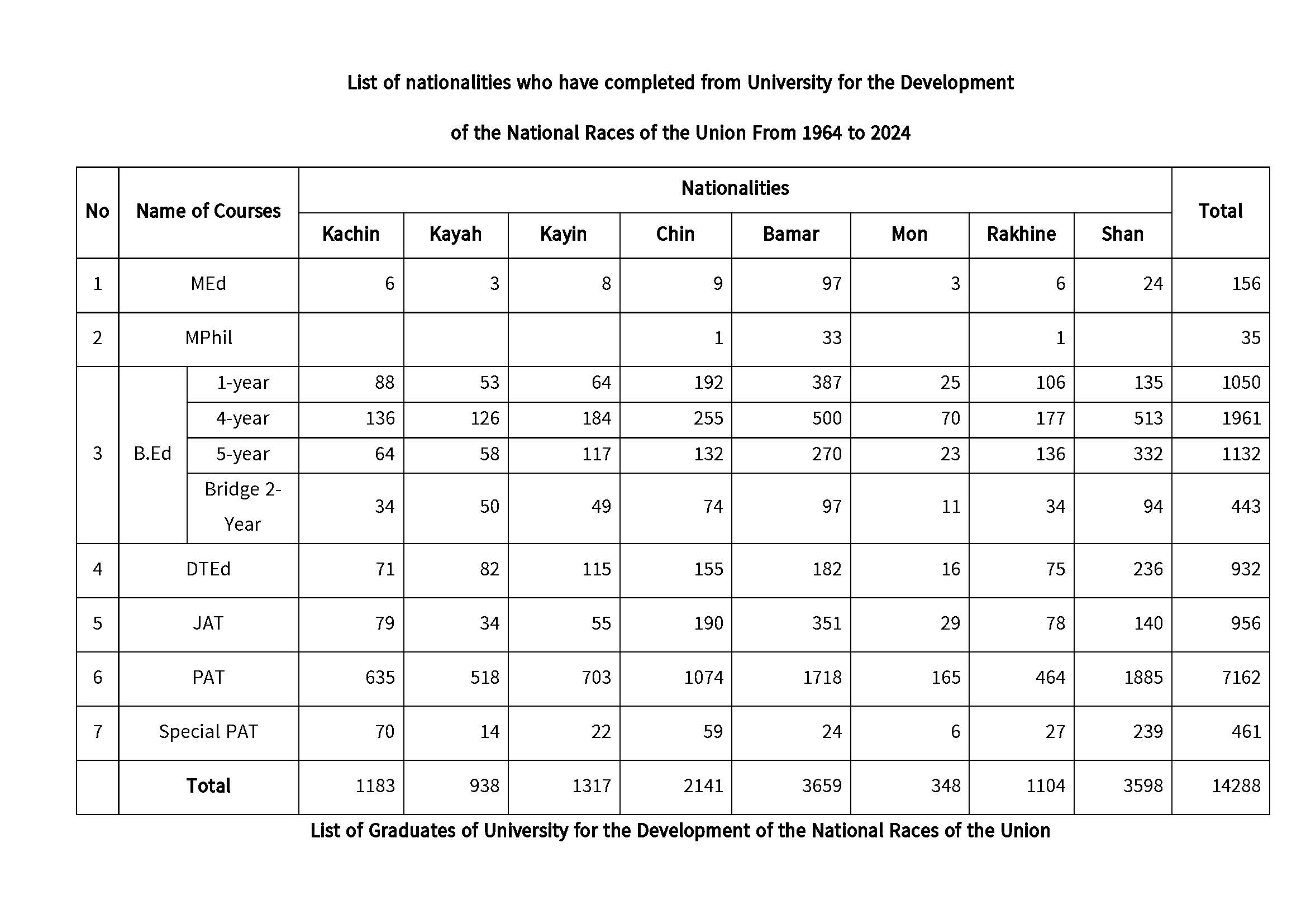
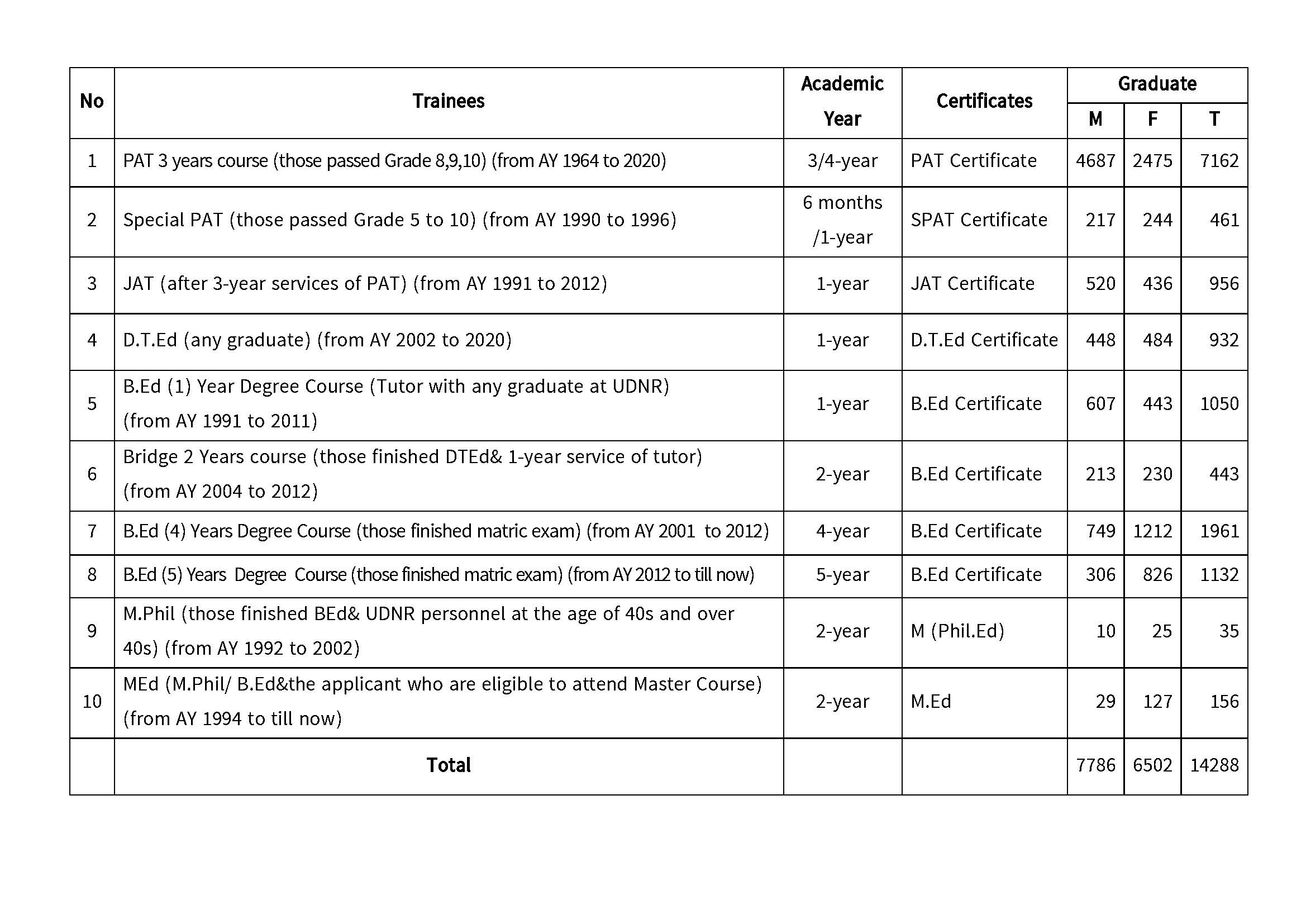
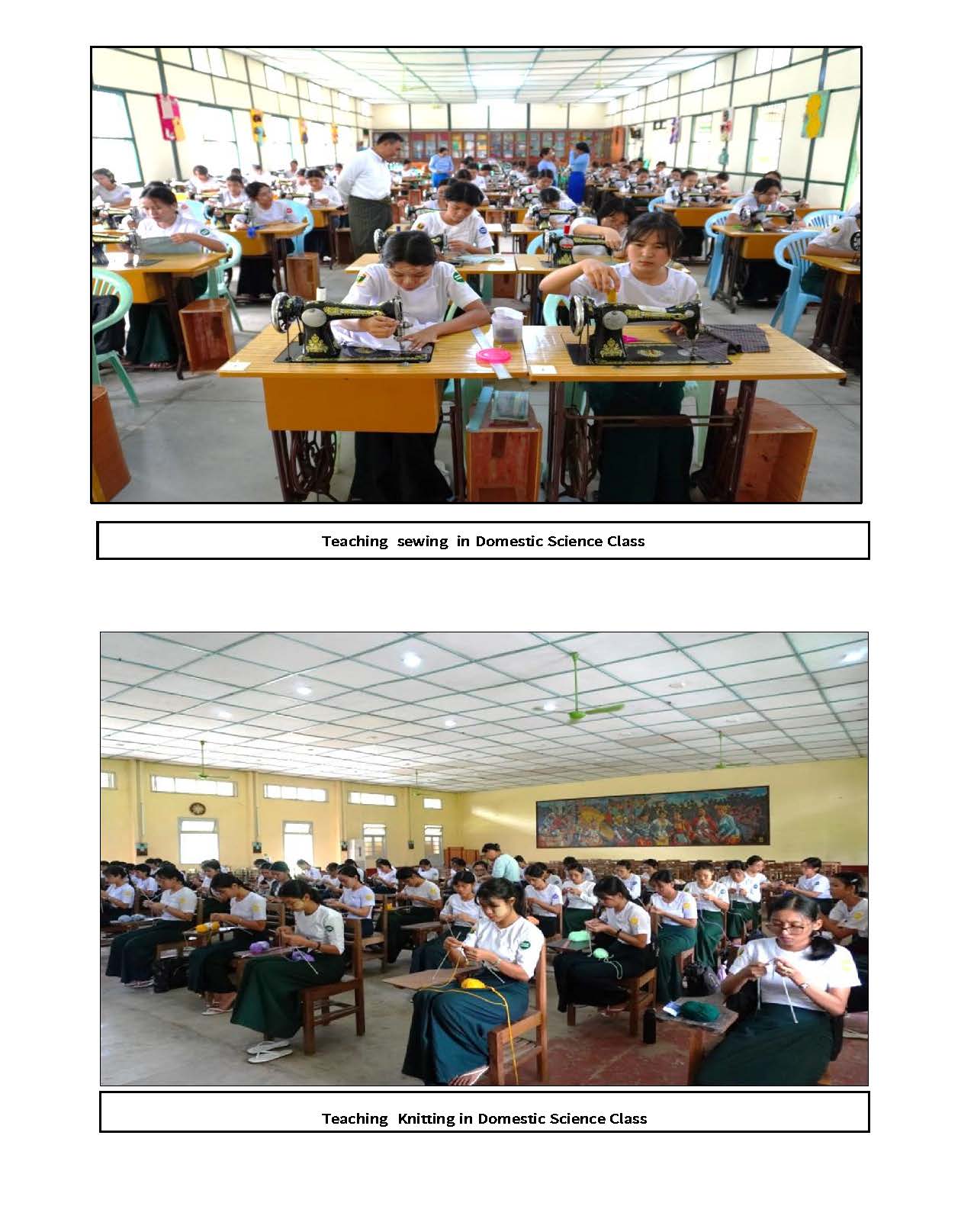
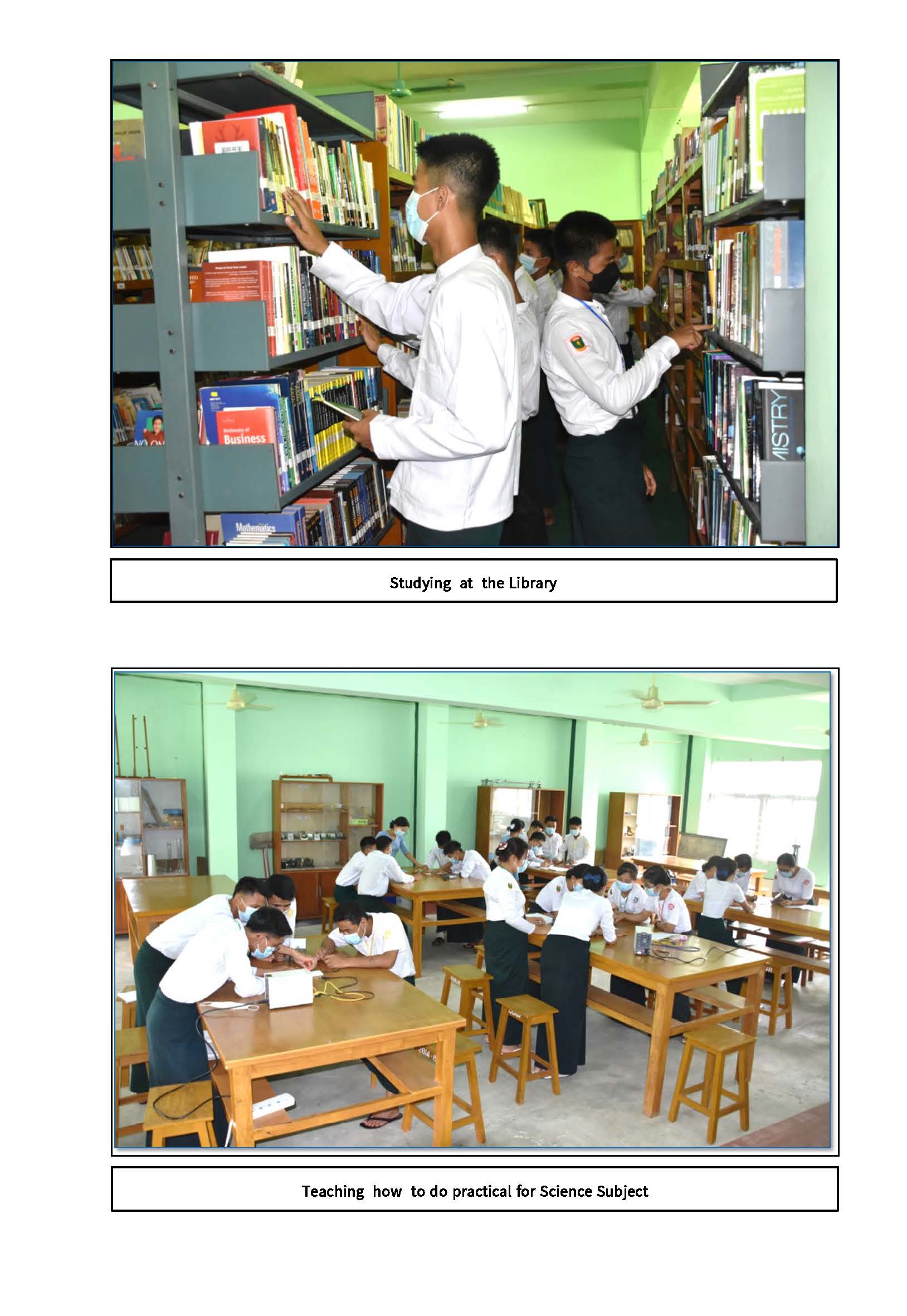
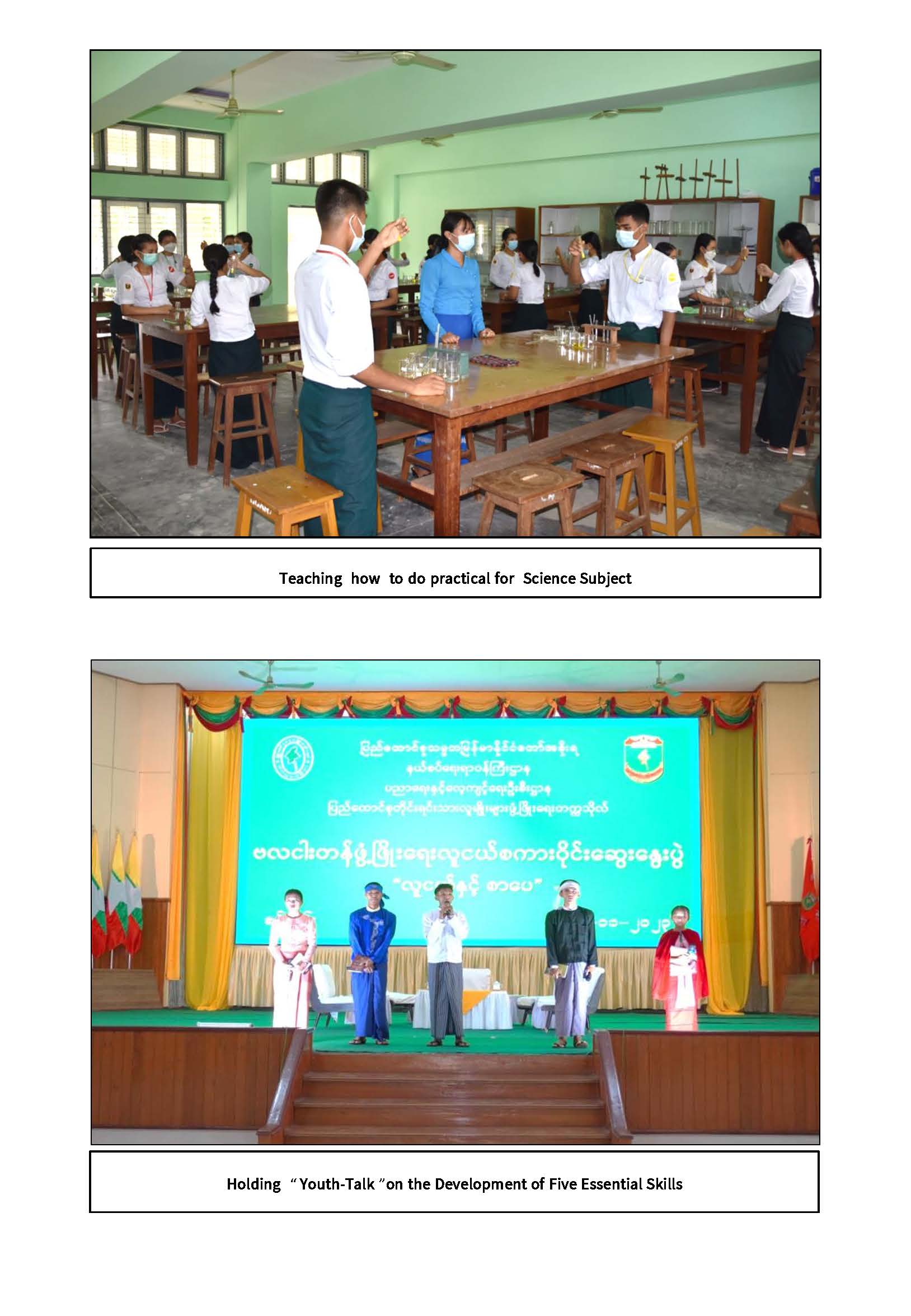
Nationalities Youth Resource Development Degree College, Yangon
Background Information
According to the meeting decision of the Union of Myanmar Government Meeting (21/ 99) held on 17th June, 1999, the Working Committee for the Implementation of the Development of Border Areas and National Races submitted it to the State Peace and Development Council. Thus, on 30th June, 1999, with the official letter no. 21/99, AhPhaYa 99 (72), the constitution of the Department of Education and Training was permitted and it was established on that day. Afterwards, the two Nationalities Youth Resource Development Degree Colleges (Yangon & Sagaing) were established starting from 2000-2001 academic year, under the supervision of the Department of Education and Training. The Nationalities Youth Resource Development Degree College, Yangon was firstly opened at Kamayut Station Street, Hlaing Township on 15th June, 2000 and then the college was transferred to plot No.3383, Land surveying Quarter No. 61, Sittaung Road, Dagon Seikkan Township and was opened on 5th July 2005.
Location and Area
Nationalities Youth Resource Development Degree College, Yangon is located at plot No.3383, Land-surveying Quarter No.61, Sittaung Road, Dagon Seikkan Township, Yangon Region. It is 31.516 acres in area. The permission on land-use has been approved with the official letter no. Makha/ Matha/ 36 L-2002 (2036) by the Department of Urban and Housing Development, Ministry of Construction on 24th, September 2002.
Nationalities Youth Resource Development Degree College, Sagaing
College History
The implementation work committee for the development of border regions and national races presented to the National Peace and Development Council in the meeting No.21/99 of the Government of the Union of Myanmar held on 17th June 1999. Education and Training Department was organized on 30th June, 1999 with the letter No. (21/ 99) Ah Pha Ra 99(72) by government organization. Then, the two degree colleges, Nationalities Youth Resource Development Degree College, Yangon and Mandalay were comprised under the supervision of Education and Training Department. Nationalities Youth Resource Development Degree College, (Yangon / Mandalay) started opening in 2000-2001 Academic Year.
In accordance with the instruction of the Head of the State, the Degree College in Amarapura township, Mandalay was opened from 12th July 2000 to 14th September 2012 and then it was transferred to Ministry of Education on 14th November. It was temporarily moved to University for the Development of the National Races of the Union at Ywarthitgyi village on 1st October 2012 and it was opened as Nationalities Youth Resource Development Degree College, Sagaing.
According to the instruction of Union Minister, Ministry of Border Affairs and Prime Minister of Sagaing Region, Nationalities Youth Resource Development Degree College, Sagaing, was opened near Ohn-Taw village on the land with 61.93 acres beside Mandalay – Monywa Highway, on the left side of mile stone No. 26/2 and 26/4, fourteen miles far away from Sagaing from 2013-2014 academic year to till now.
Location and Width
Nationalities Youth Resource Development Degree College, Sagaing is located in 61.93 acres beside Mandalay – Monywa Highway, on the left side of mile stone No. 26/2 and 26/4, Sagaing Region.
Nationalities Youth Resource Development Degree Colleges (Yangon & Sagaing)
Daily Routine of the Students (Training Timetable)
Time Routine
1. 05:00 a.m Time to get up
2. 05:40 - 06:20 a.m Time for doing physical exercises
3. 06:20 - 07:00 a.m Time for personal hygiene
4. 07:00 - 07:30 a.m Time for assembly, taking attendance and saying oaths
5. 07:30 - 08:00 a.m Breakfast time
6. 08:00 - 11:45 a.m Morning classes
7. 11:45 - 12:30 p.m Lunch time
8. 12:30 - 15:30 p.m Afternoon classes
9. 15:30 - 16:00 p.m Time for relaxation
10. 16:00 - 17:00 p.m Time for doing sports and gardening
11. 17:00 - 18:00 p.m Time for relaxation
12. 18:00 - 18:30 p.m Dinner time
13. 18:30 - 19:00 p.m Time of preparing for night study
14. 19:00 - 21:00 p.m Study time
15. 21:00 - 22:00 p.m Time for relaxation, assembly, taking attendance
16. 22:00 pm Bedtime
Clarification: (1) Students must arrive 10 minutes earlier than the class time for every morning session, afternoon session and night study.
(2) Since the second week of each semester, there is the students’ assembly to be examined for proper dress code every Tuesday at 7 o’clock.
(3) It takes 45 minutes for each class period and there are altogether nine class periods: five periods in the morning session and 4 periods in the afternoon session.
Conferred Degrees
Degrees and diplomas are conferred as follows:
1. Bachelor of Arts (B.A) Degrees (four-year course)
(a) B.A (Myanmar)
(b) B.A (History)
(c) B.A (Geography)
2. Bachelor of Science (B.Sc)Degrees (four-year course)
(a) B.Sc (Physics)
(b) B.Sc (Mathematics)
(c) B.Sc (Chemistry)
3. AGTI Diplomas (three-year course)
(a) Civil
(b) Mechanical
(c) Electrical Power
(d) Electronics
4. Computer (Certificate)
Provision per student
1.Providing rations and food expense
Rice - 2.25 cans
Oil - 2.25 ticals
Beans/ Peas - 5.00 ticals
Salt - 0.50 ticals
Fresh Food (per day) - 750 kyats
Nutritional supplements - 570 kyats
2. Providing clothes
Traditional Jacket/ Safari Coat - 1 piece
Longyi - 2 pieces
White Shirt/ Myanmar Traditional Blouse (long sleeve) - 2 pieces
T-shirt - 2 pieces
Trousers - 1 pair
Schoolbag - 1 piece
Slippers - 1 pair
Canvas shoes - 1 pair
Socks - 1 pair
3. Providing Bedding Sets
Mosquito net - 1 piece
Pillow - 1 piece
Pillowcase - 1 piece
Mattress - 1 piece
White bed sheet - 1 piece
Blanket - 1 piece
Quilt - 1 piece
Towel - 1 piece
4. Providing Stationery
Pencase - 1 piece
Notebook - 6 dozens
Pen - 1 dozen
Pencil - 6 pieces
Ruler - 2 pieces
Tutorial Book - 1 dozen
5. Pocket Money (per month) - 3,000 kyats
Nationalities Youth Resource Development Degree College, Yangon
Master & Ph.D Graduated Students’ List
|
No |
Academic Year |
M.A |
M.Sc |
M.Res |
Ph.D |
Total |
|
1. |
2006-2007 |
5 |
4 |
5 |
5 |
19 |
|
2. |
2007-2008 |
10 |
5 |
8 |
- |
23 |
|
3. |
2008-2009 |
3 |
18 |
12 |
1 |
34 |
|
4. |
2009-2010 |
6 |
23 |
11 |
- |
40 |
|
5. |
2010-2011 |
13 |
17 |
2 |
- |
32 |
|
6. |
2011-2012 |
8 |
11 |
- |
- |
19 |
|
7. |
2012-2013 |
3 |
23 |
- |
- |
26 |
|
Total |
48 |
101 |
38 |
6 |
193 |
|
Nationalities Youth Resource Development Degree College, Sagaing
Master & Ph.D Graduated Students’ List
|
No |
Academic Year |
M.A |
M.Sc |
M.Res |
Ph.D |
Total |
|
1. |
2006-2007 |
|
2 |
7 |
|
9 |
|
2. |
2007-2008 |
5 |
10 |
|
4 |
19 |
|
3. |
2008-2009 |
18 |
25 |
3 |
|
46 |
|
4. |
2009-2010 |
7 |
8 |
21 |
2 |
38 |
|
5. |
2010-2011 |
4 |
20 |
4 |
12 |
40 |
|
6. |
2011-2012 |
4 |
9 |
10 |
|
23 |
|
7. |
2012-2013 |
5 |
13 |
3 |
|
21 |
|
Total |
43 |
87 |
48 |
18 |
196 |
|
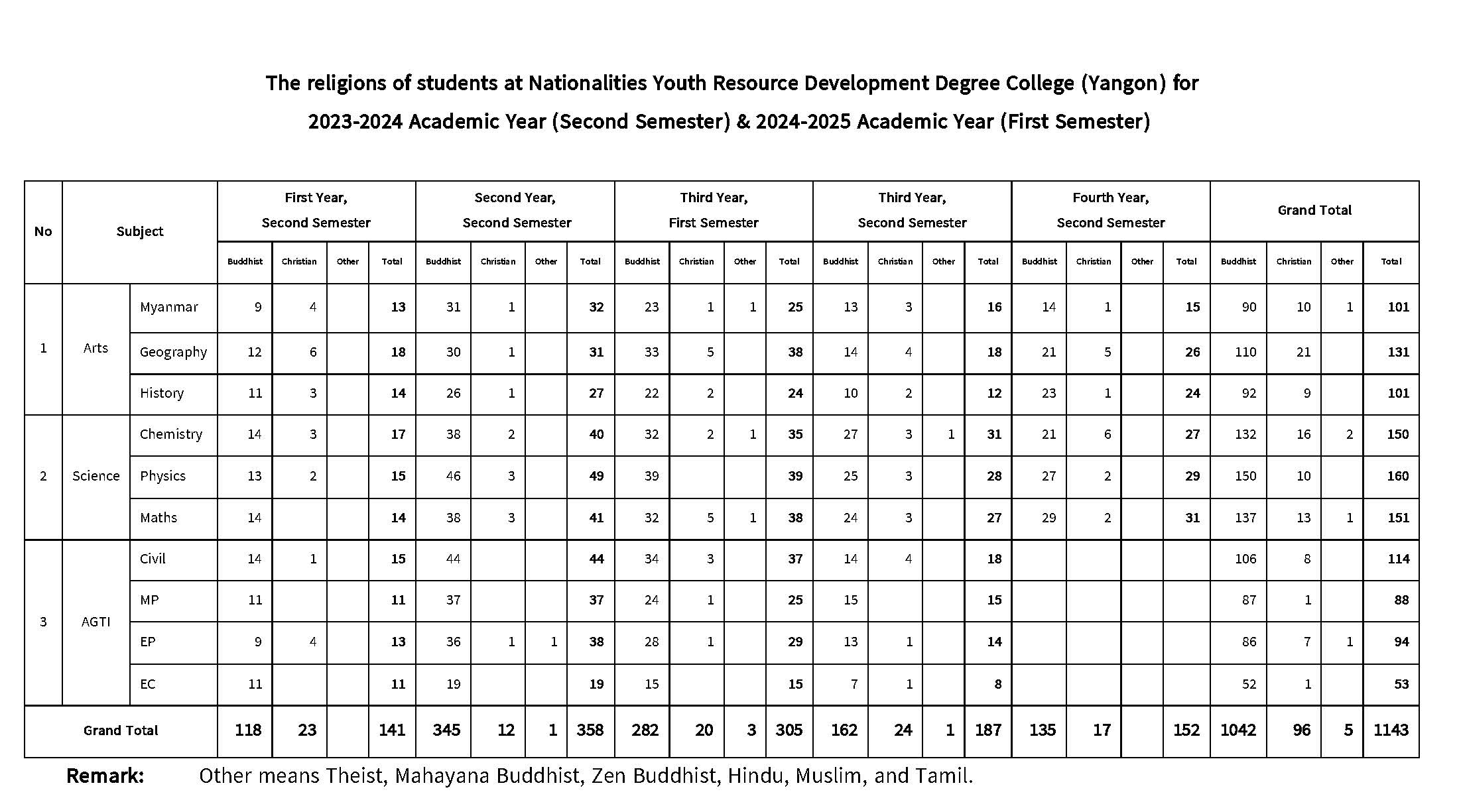
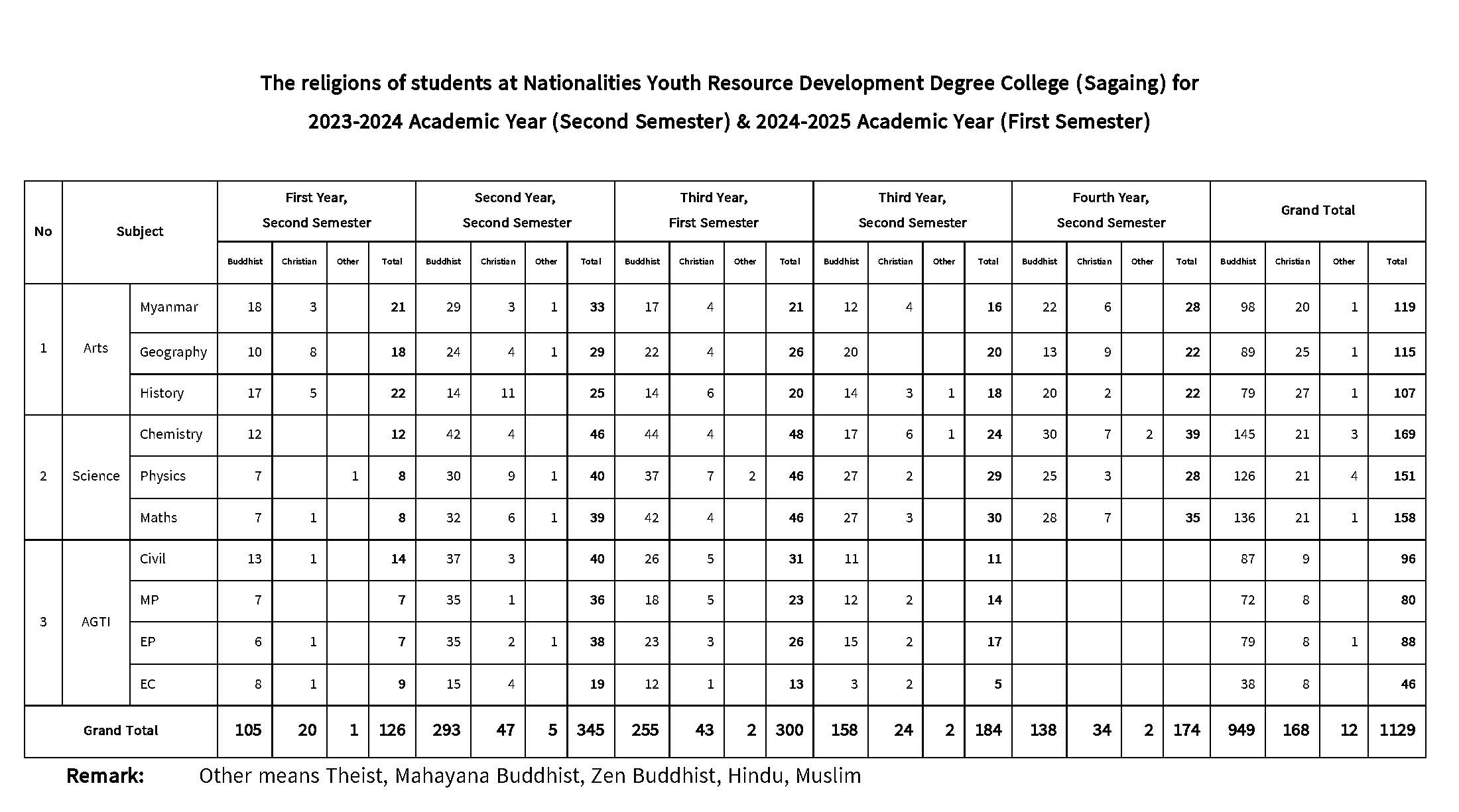
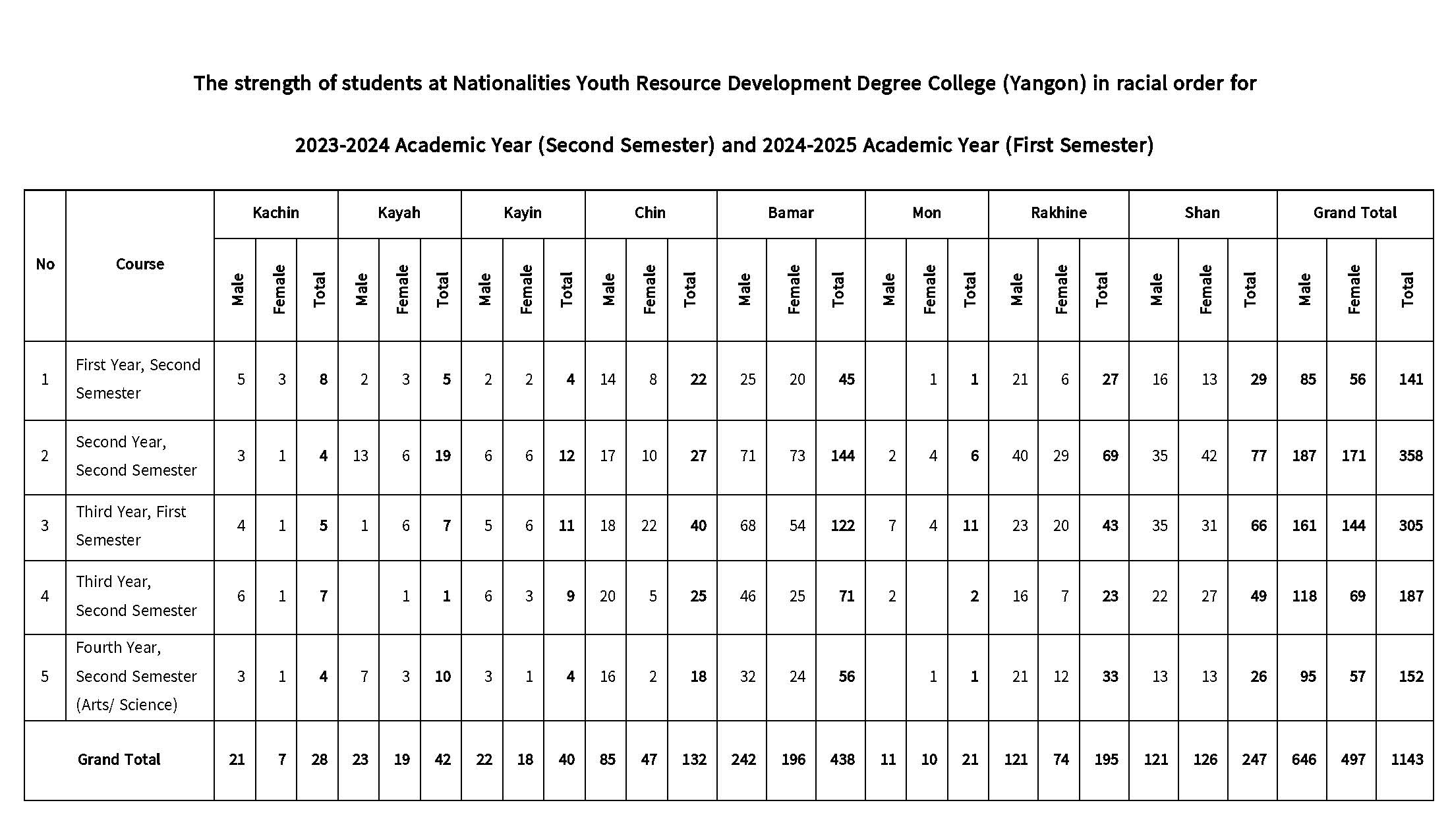
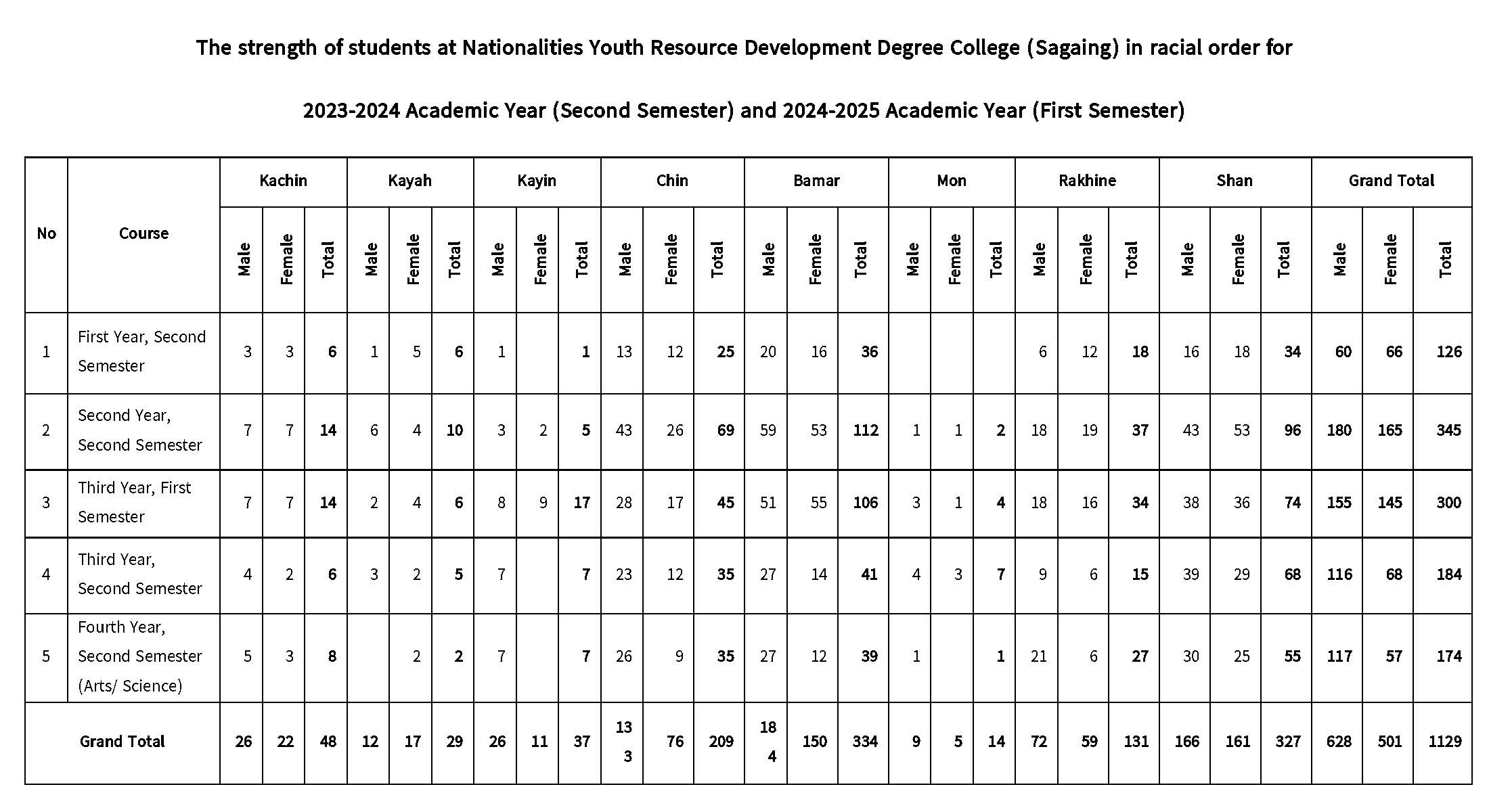
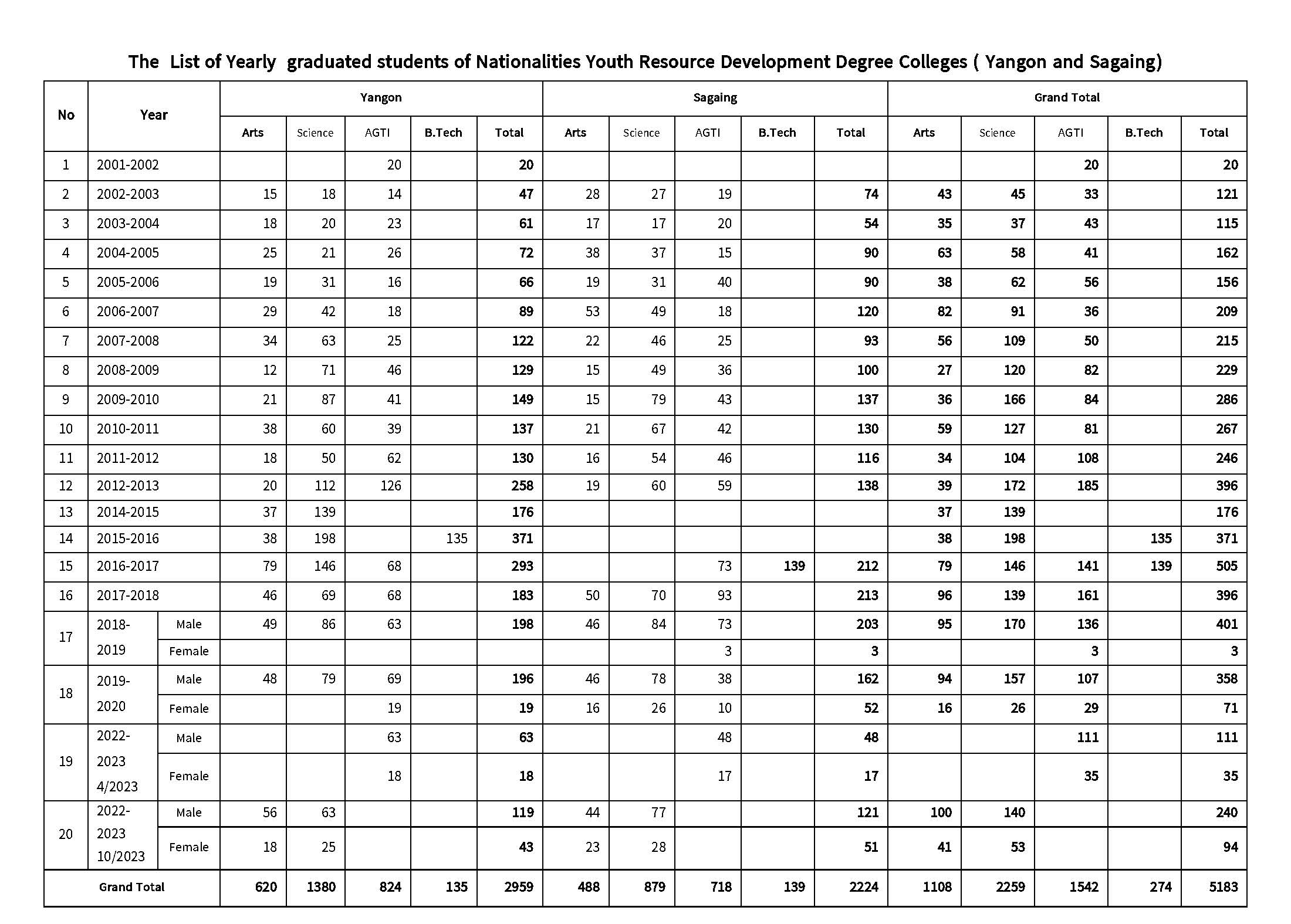
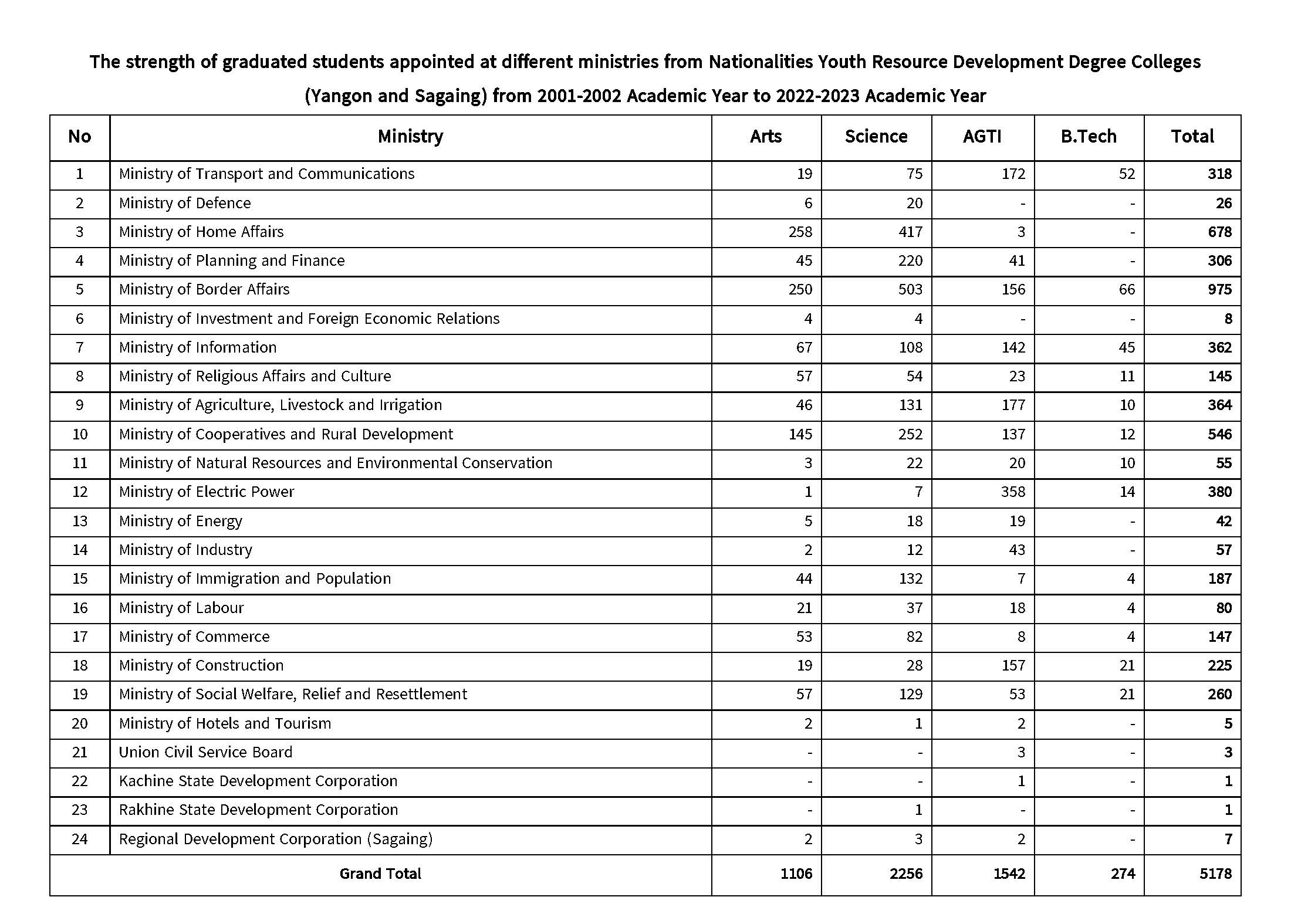
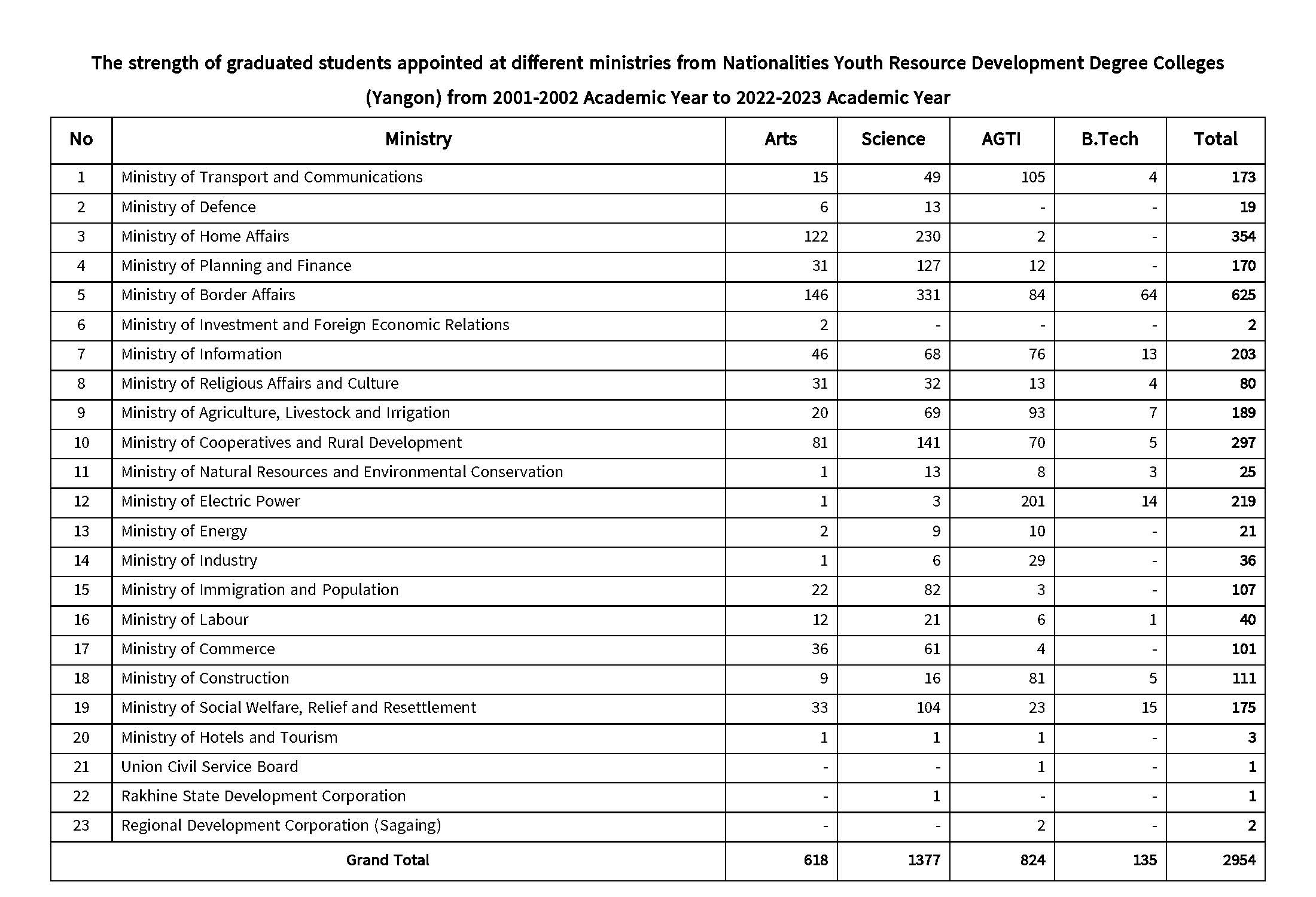
Nationalities Youth Resource Development Degree Colleges (Yangon)
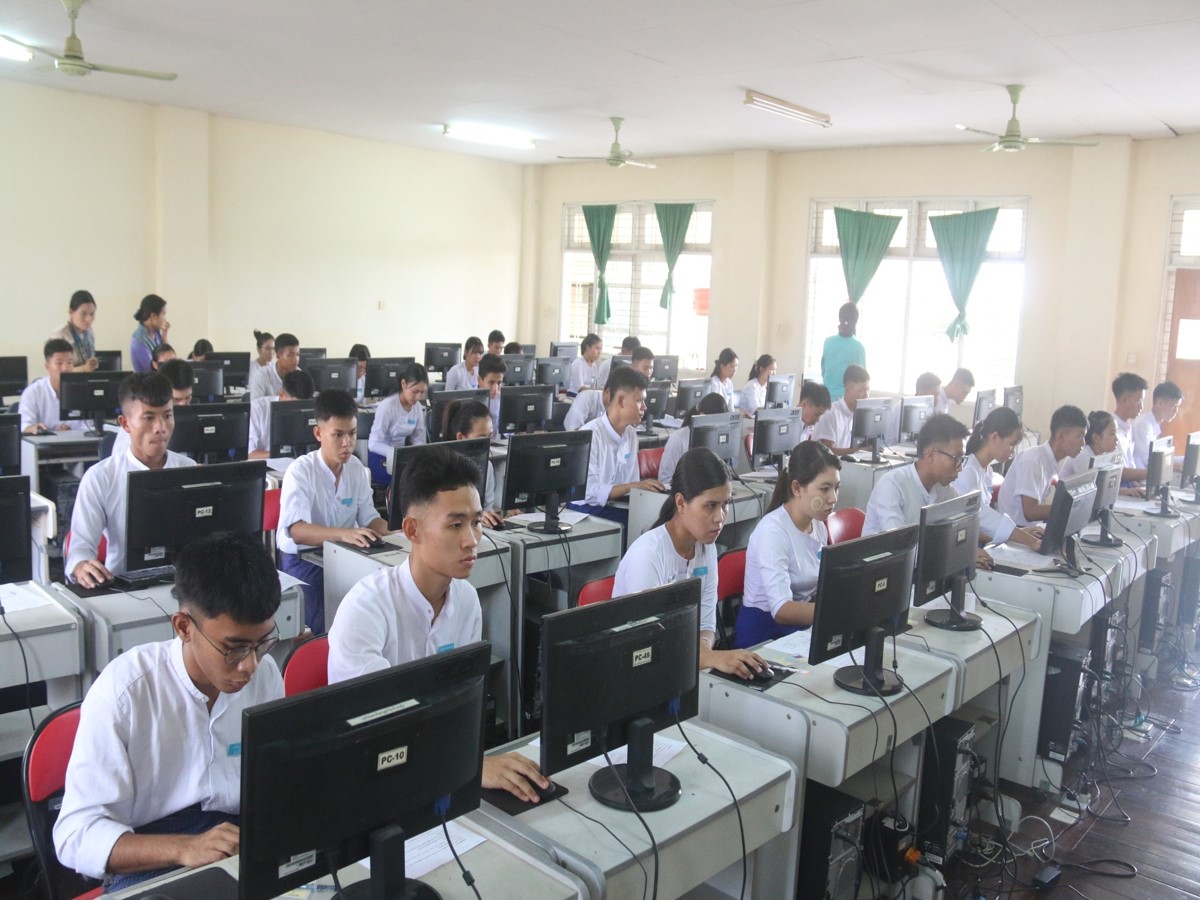
Nationalities Youth Resource Development Degree Colleges (Sagaing)
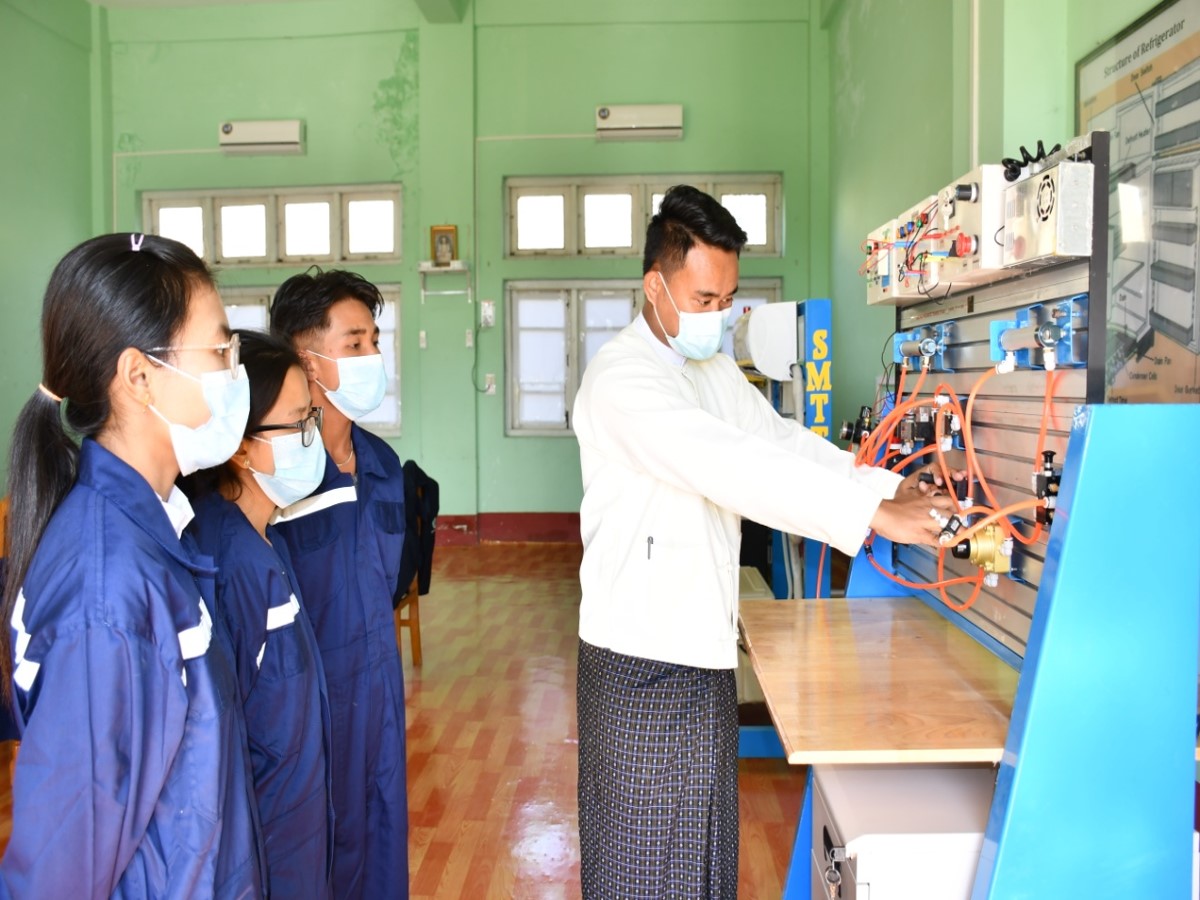
Information of Central Training School
Background Information
The Central Training School was opened as a Municipal Training School on February 16, 1998 until it was transferred to the Department of Education and Training. The Department of Education and Training took over from the Department of Municipal Development on June 30, 1999 and it was transformed into a Central Training School.
Location and area
It is located in Myawaddi Min Gyi Road, No.51 Ward, North Dagon Township, Yangon and it is ten acres.
The purpose of the opening
The Central Training School has been established with the following purposes.
(a) To promote the skills of civil servants under the two departments of the Ministry of Border Affairs and other organizations and ministries
(b) To be able to carry out the tasks and responsibilities skillfully in accord with the position and rank
(c) To understand the rules and regulations, policy and guidance of the organization and to be able to implement the tasks assigned.
Training Courses Conducted
With the aim of promoting the skills and capabilities of the civil servants and helping them achieve successful implementation of the objectives of the two departments under the Ministry, training courses have been organized since 1998 to date the enable at the Central Training School. So far, altogether 16630 trainees (6215 male trainees and 10415 female trainees) have been trained. (Attached File)
During an individual fiscal year, the following courses are being conducted the whole year round.
No Name of the course
(a) Course for Enhancing the Potential of the Executive Officers
(b) Leadership Course for Programme of Peace and Progress of the Border Areas and National Races
(c) Administrative Course
(d) Course for Clerks
(e) Instructor Course for Advanced Tailoring
(f) Motorized Sewing Machine Course
(g) Computerized Embroidery Course
(h) Special Course for Finance Regulation
(i) Store-keeping Course
(j) Elderly Care Course
(k) Construction Skilled Worker Training Course
(l) Sewing Course
Training qualification Committee
Training qualification Committee for assessing the skills and abilities of the trainees to pursue certificates is set up with the following people.
|
a |
Director General |
Education and Training Department |
Chairman |
|
b |
Director General |
Progress of Border Areas and National Races Department |
Member |
|
c |
Deputy Director General (Basic Education Branch) |
Education and Trainingg Department |
Member |
|
d |
Deputy Director General (Higher Education Branch) |
Education and Trainingg Department |
Member |
|
e |
Deputy Director General |
Progress of Border Areas and National Races Department |
Member |
|
f |
Director (Higher Education Branch) |
Education and Training Department |
Member |
|
g |
A Representative |
Department of Rural Development |
Member |
|
h |
Principal |
Central Training School |
Secretary |
| i |
Director(Administrative Department) |
Education and Training Department |
Joint Secretary |
Daily Schedule of the trainees
1. 05:00 Time to Wake Up
2. from 05:40 to 06:20 Time for doing physical exercise
3. from 06:20 to 07:00 Time for personal hygiene
4. from 7:00 to 07:30 Time for assembly, taking attendance and saying oath
5. from 7:30 to 08:00 Breakfast time
6. from 8:00 to 11:10 Morning classes
7. from 11:10 to 12:00 Lunch time
8. from 12:00 to 15:10 Afternoon classes
9. from 15:10 to 16:00 Relaxation time
10. from 16:00 to 17:00 Time for fatigue (sports, cleaning, gardening)
11. from 17:00 to 18:00 Relaxation time
12. from 18:00 to 18:30 Dinner time
13. from 18:30 to 19:00 Time to prepare for reading
14. from 19:00 to 21:00 Evening study time in the classrooms
15. from 21:00 to 22:00 Personal time/Queuing time
16. 22:00 Bed time
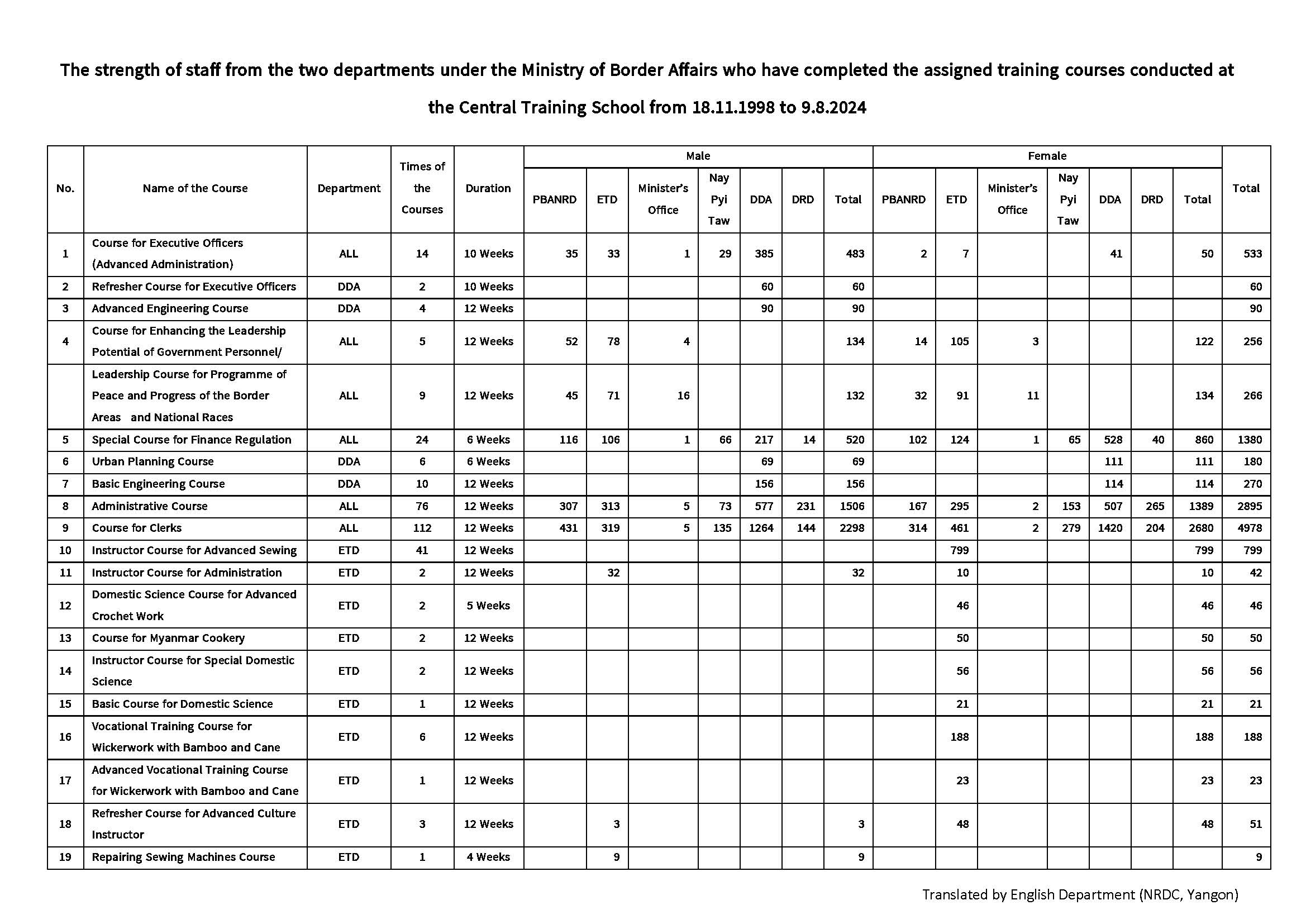
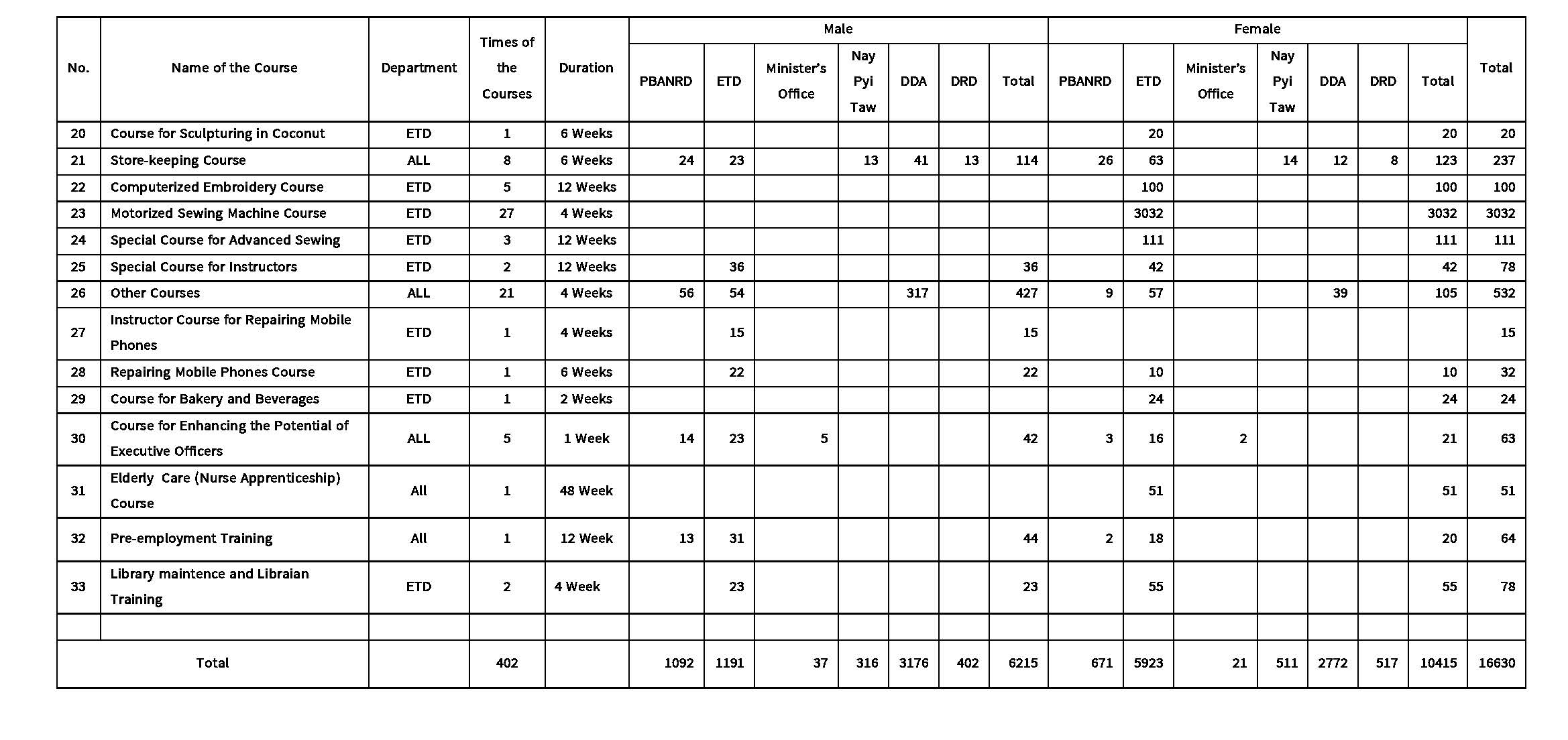
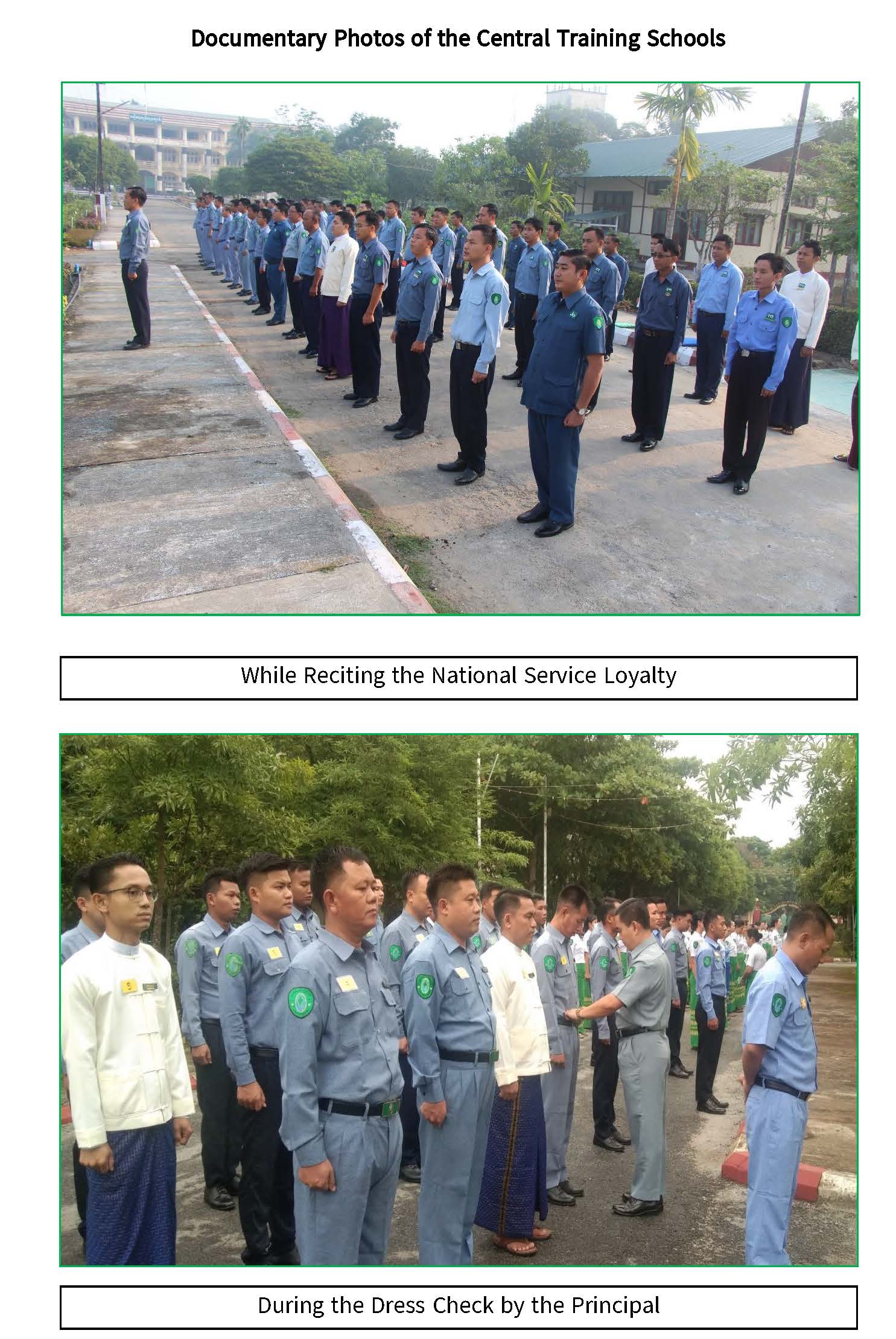
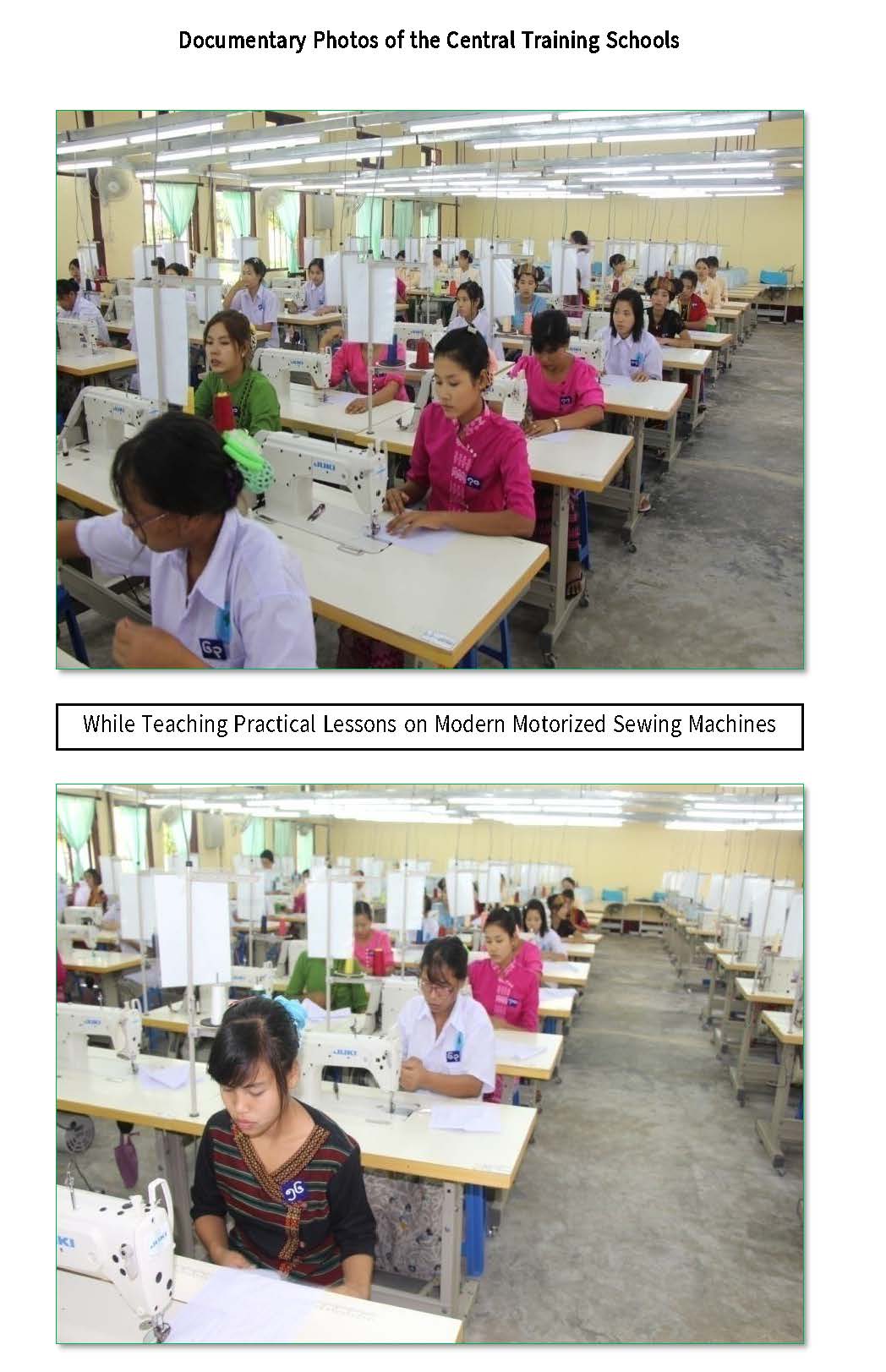
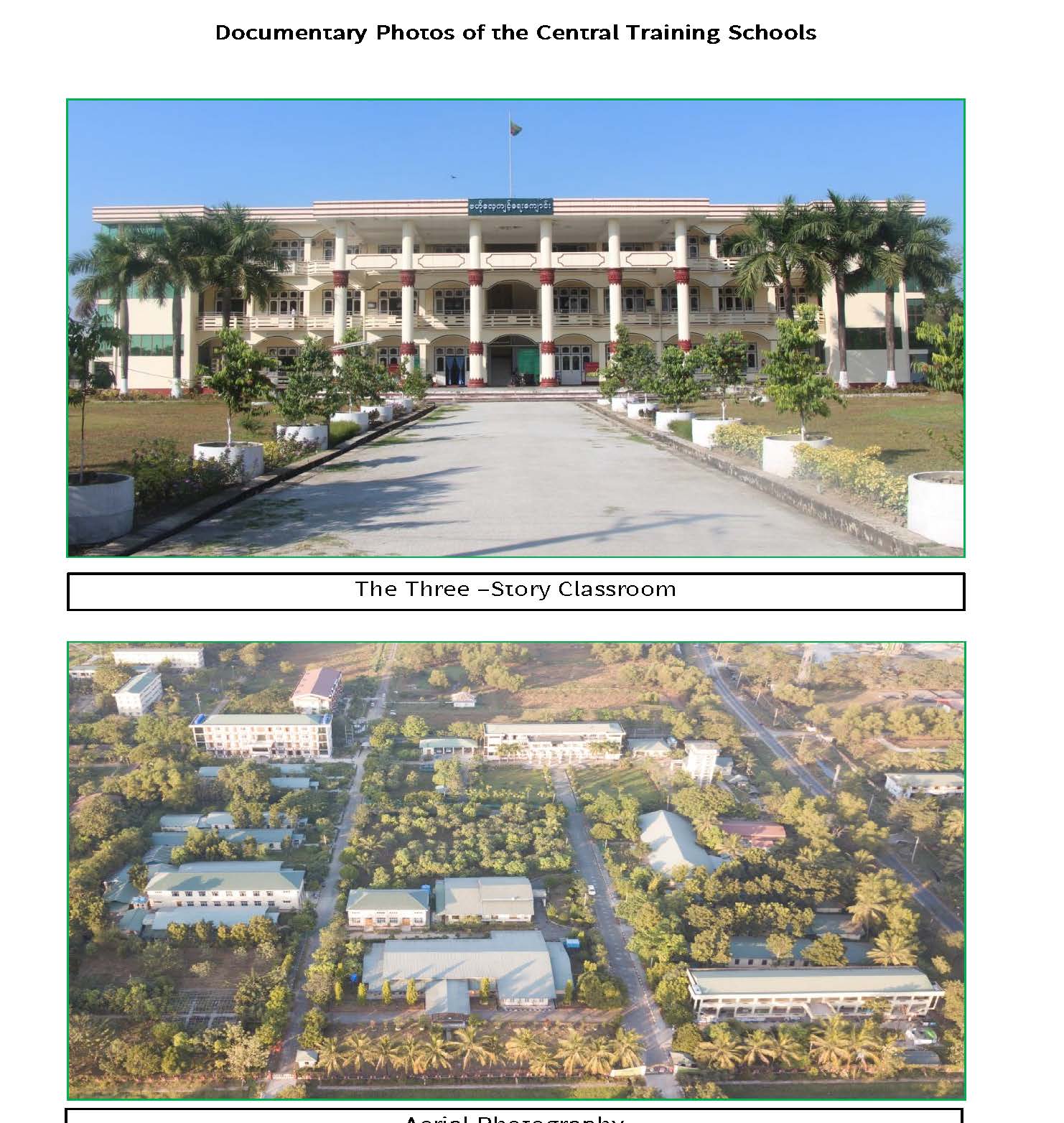


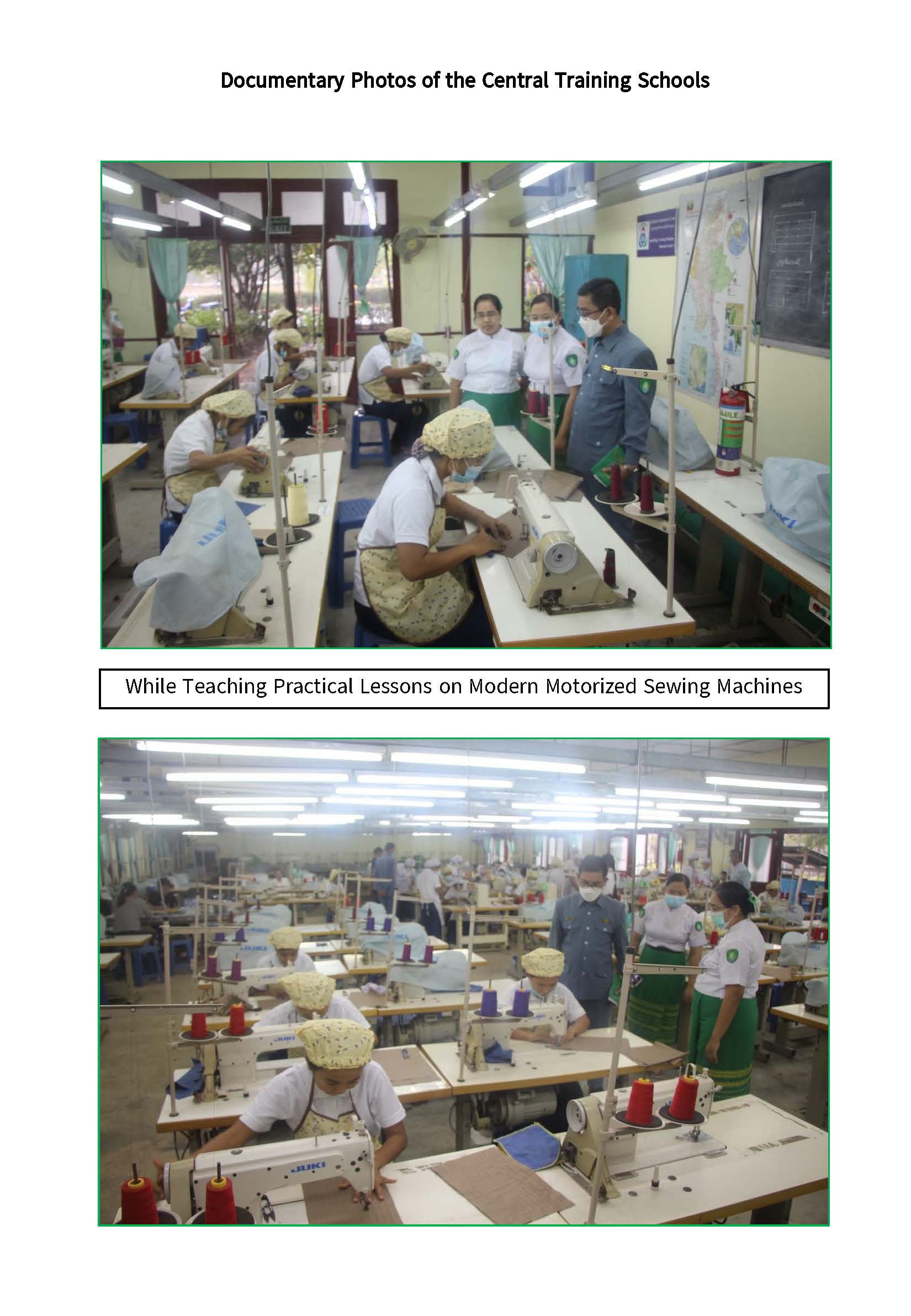
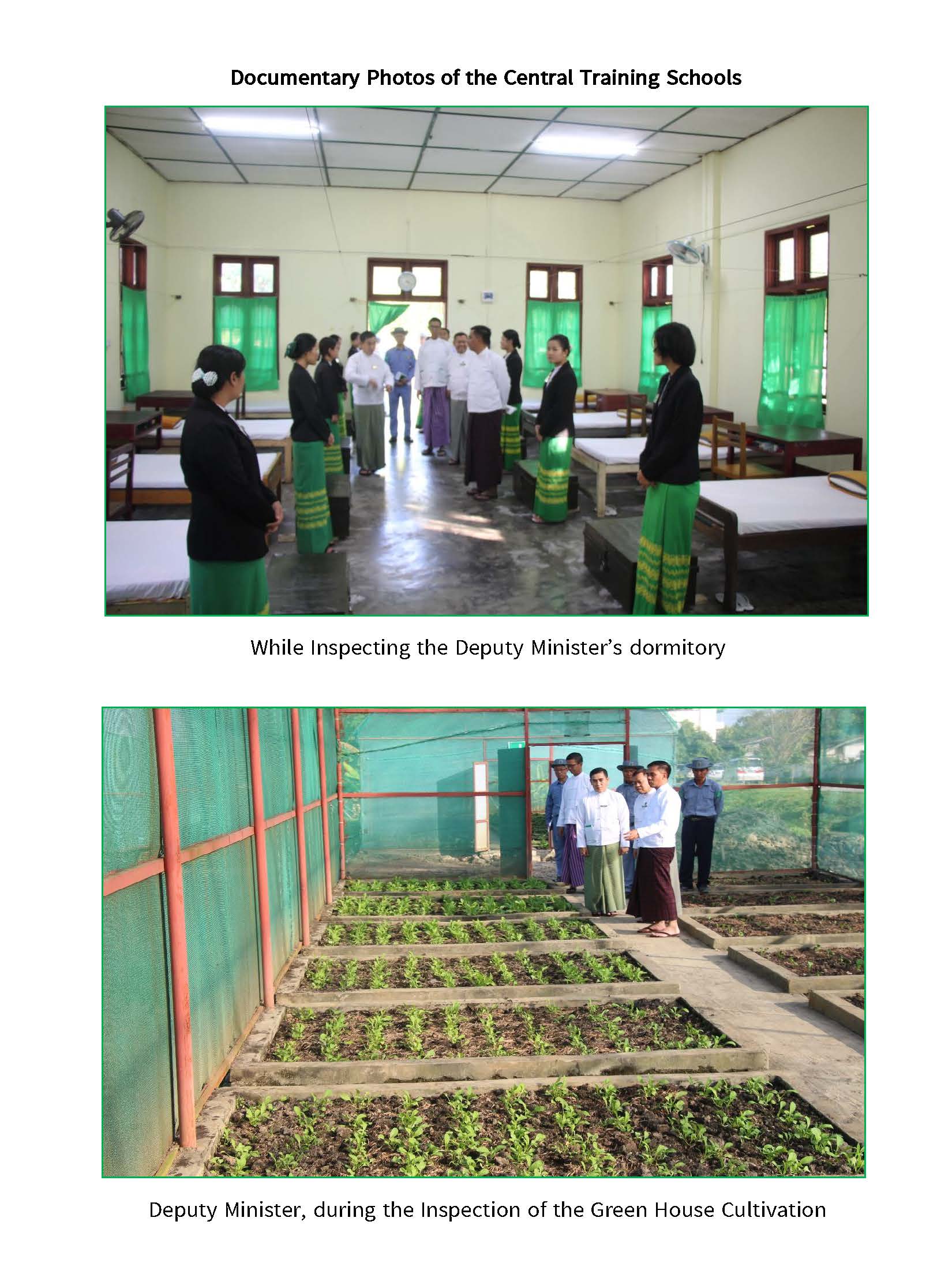
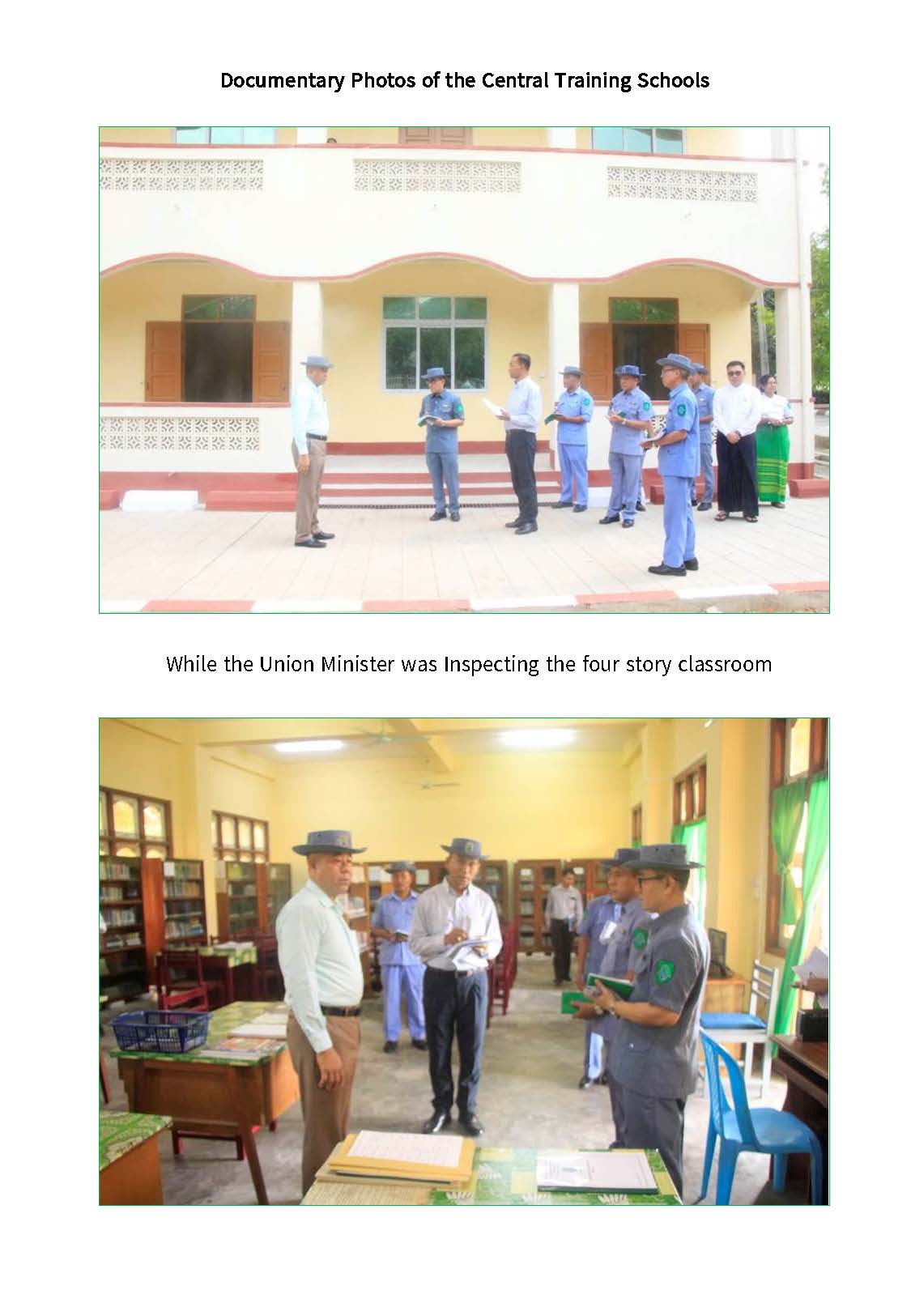
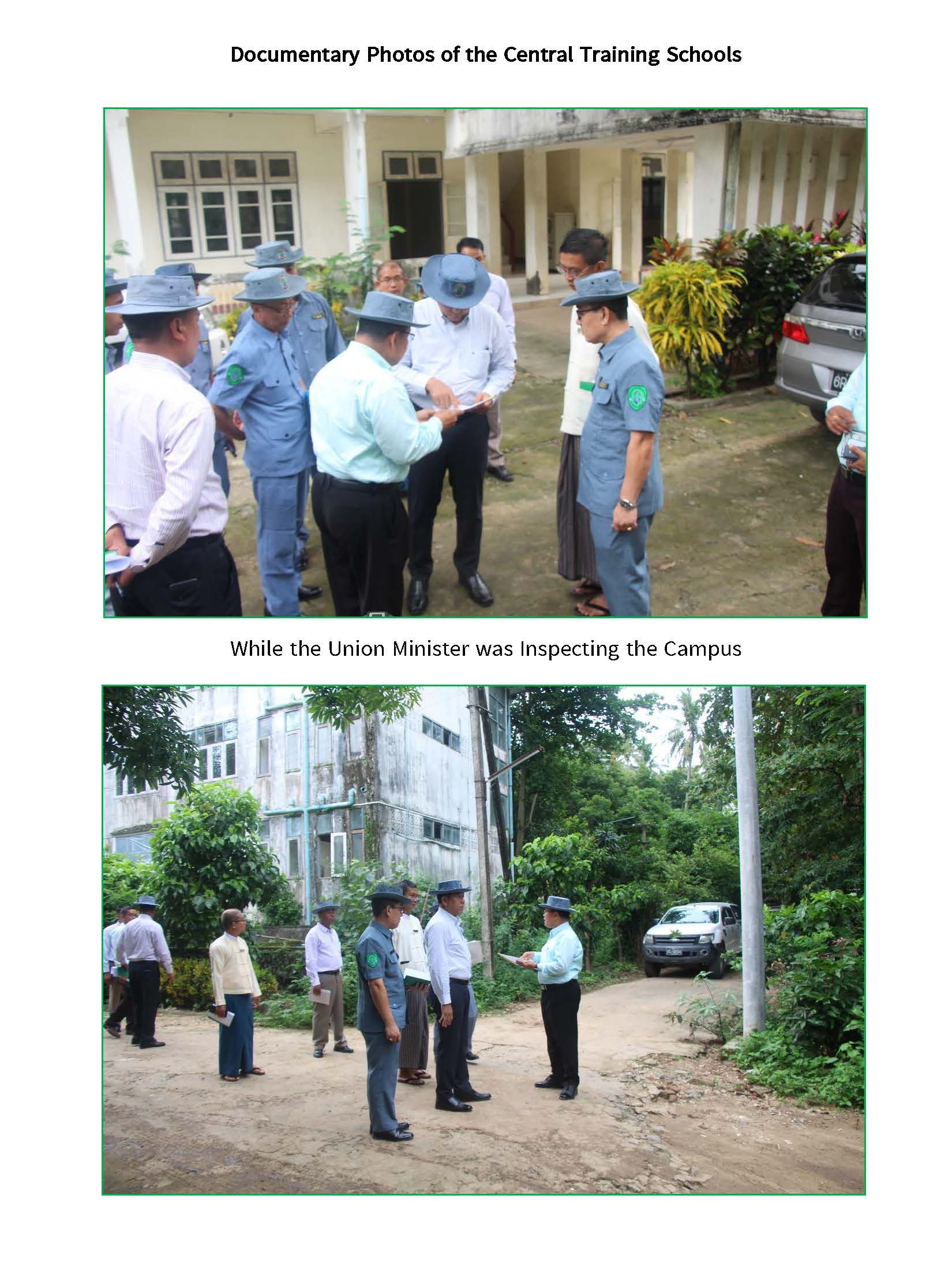
Locations of Training Schools for Development of Nationalities Youths from Border Areas

Website Address


